
USER
GUIDE
A
downloadable, printable guide to your Wiko Ride
TM
2 and its features.
Available applications and services are subject to change at any time.
Table of contents
Getting started .............................................................................................................................. 1
Introduction ............................................................................................................................ 2
About the user guide ...................................................................................................... 2
Set up your phone ................................................................................................................. 3
Parts and functions ......................................................................................................... 3
Battery use ..................................................................................................................... 4
SIM card ......................................................................................................................... 7
SD card ........................................................................................................................... 7
Turn your phone on and off .......................................................................................... 10
Use the touchscreen ..................................................................................................... 10
Activation and service ................................................................................................... 12
Complete the setup screens ......................................................................................... 12
Basic operations .................................................................................................................. 13
Home screen and applications (Apps) list .................................................................... 13
Phone settings menu .................................................................................................... 14
Portrait and landscape screen orientation .................................................................... 15
Capture screenshots .................................................................................................... 15
Applications .................................................................................................................. 16
Phone number .............................................................................................................. 21
Airplane mode .............................................................................................................. 21
Enter text ...................................................................................................................... 22
Google Account ............................................................................................................ 24
Google Play Store ........................................................................................................ 26
Lock and unlock your screen ........................................................................................ 31
Update your phone ....................................................................................................... 31
Your phone’s home screen .................................................................................................. 36
Home screen basics ..................................................................................................... 36
Status bar and notification panel .................................................................................. 38
Customize the home screen ......................................................................................... 41
Making connections .................................................................................................................... 45
Phone calls and voicemail ................................................................................................... 46
Place and answer calls ................................................................................................. 46
Voicemail ...................................................................................................................... 54
Optional calling services ............................................................................................... 55
Call settings .................................................................................................................. 57
Contacts ............................................................................................................................... 60
Add a contact ................................................................................................................ 60
Edit a contact ................................................................................................................ 63
Delete a contact ............................................................................................................ 64
Share a contact ............................................................................................................ 65
Import contacts ............................................................................................................. 66
Back up contacts .......................................................................................................... 66
Messages ............................................................................................................................ 68
Text and multimedia messages .................................................................................... 68
Gmail ............................................................................................................................ 74
Internet and social networking ............................................................................................. 82
Chrome browser ........................................................................................................... 82
Facebook ...................................................................................................................... 83
Twitter ........................................................................................................................... 84
Connectivity ......................................................................................................................... 85
Transfer files between your phone and a computer ..................................................... 85
Wi-Fi ............................................................................................................................. 86
Bluetooth ...................................................................................................................... 88
Apps and entertainment .............................................................................................................. 94
Camera and video ............................................................................................................... 95
Camera overview .......................................................................................................... 95
Take pictures and record videos ................................................................................... 96
View pictures and video using Photos .......................................................................... 97
Edit pictures .................................................................................................................. 98
Share pictures and videos .......................................................................................... 100
Camera settings ......................................................................................................... 104
Productivity ........................................................................................................................ 106
Calendar ..................................................................................................................... 106
Navigation apps .......................................................................................................... 110
Google Search ............................................................................................................ 112
Calculator ................................................................................................................... 113
Clock ........................................................................................................................... 115
Entertainment and activities ............................................................................................... 122
YT Music app .............................................................................................................. 122
YouTube ..................................................................................................................... 122
Settings ..................................................................................................................................... 124
Basic settings ..................................................................................................................... 125
Network & Internet ............................................................................................................. 126
Wi-Fi ........................................................................................................................... 126
Wi-Fi Calling ............................................................................................................... 129
Mobile network ........................................................................................................... 130
Data usage ................................................................................................................. 130
Hotspot & tethering ..................................................................................................... 131
Airplane mode ............................................................................................................ 132
VPN (Virtual Private Networks) .................................................................................. 132
Private DNS ................................................................................................................ 133
Wireless Emergency alerts ......................................................................................... 133
Connected devices ............................................................................................................ 133
USB ............................................................................................................................ 133
Connection preferences ............................................................................................. 135
Apps & notifications ........................................................................................................... 139
Recently opened apps ................................................................................................ 139
Notifications ................................................................................................................ 139
Default apps ............................................................................................................... 140
Permission manager ................................................................................................... 140
Special app access ..................................................................................................... 140
Battery ............................................................................................................................... 142
Display ............................................................................................................................... 143
Sound ................................................................................................................................ 144
Storage .............................................................................................................................. 145
Privacy ............................................................................................................................... 146
Location ............................................................................................................................. 148
Security .............................................................................................................................. 149
Security status ............................................................................................................ 150
Device security ........................................................................................................... 151
Device admin apps ..................................................................................................... 152
Encryption & credentials ............................................................................................. 152
Trust agents ................................................................................................................ 153
Screen pinning ............................................................................................................ 153
Accounts ............................................................................................................................ 153
Add account ................................................................................................................ 153
Automatically sync data .............................................................................................. 154
Accessibility ....................................................................................................................... 154
Volume key shortcut ................................................................................................... 154
Downloaded services ................................................................................................. 155
Screen readers ........................................................................................................... 155
Display ........................................................................................................................ 156
Interaction controls ..................................................................................................... 157
Audio & on-screen text ............................................................................................... 159
Experimental options .................................................................................................. 159
Google ............................................................................................................................... 159
System ............................................................................................................................... 160
Languages & input ...................................................................................................... 160
Gestures ..................................................................................................................... 161
Date & time ................................................................................................................. 162
Backup ........................................................................................................................ 162
Reset options .............................................................................................................. 163
Multiple users ............................................................................................................. 163
System updates .......................................................................................................... 164
About phone ............................................................................................................... 164
Getting help............................................................................................................................... 166
For assistance ................................................................................................................... 167
Troubleshooting .......................................................................................................... 167
Specifications ............................................................................................................. 168
Customer Service information .................................................................................... 169
Copyright information ................................................................................................. 169
Safety and use .......................................................................................................................... 170
Please read before proceeding .......................................................................................... 171
Privacy restrictions ..................................................................................................... 171
Disclaimers ................................................................................................................. 171
Limitation of damages ........................................................................................................ 171
Important health information and safety precautions ......................................................... 172
Electrical safety .......................................................................................................... 172
Safety precautions for proper grounding installation .................................................. 172
Safety precautions for power supply unit .................................................................... 172
Regulatory agency identifications ...................................................................................... 179
FCC Regulations ........................................................................................................ 179
RF Exposure Information (SAR) ................................................................................. 179

1
Getting started
The topics in this section will introduce you to your phone, help you get set up with service,
provide an overview of the phone screen, and get you started with basic phone operations.

2
Introduction
The following topics describe the basics of using this guide and your new phone.
About the user guide
Thank you for purchasing your new Wiko Ride 2. The following topics explain how best to use
this guide to get the most out of your phone.
Before using your phone
Read the Quick Start Guide that is located on your phone within Settings thoroughly for proper
usage.
Accessible services may be limited by subscription contract conditions.
Descriptions in the user guide
Note that most descriptions in this guide are based on your phone's setup at the time of
purchase. Unless otherwise noted, instructions begin from the phone's home screen, which is
displayed by pressing the Home button . Some operation descriptions may be simplified.
Screenshots and key labels
Screenshots and other illustrations in this user guide may appear differently on your phone.
Key labels in the user guide are simplified for description purposes and differ from your phone's
display.
Other notations
In the user guide, the phone may be referred to either as "phone," "device," or "handset." A
microSD™ or microSDHC™ card is referred to as an "SD card" or a "memory card."
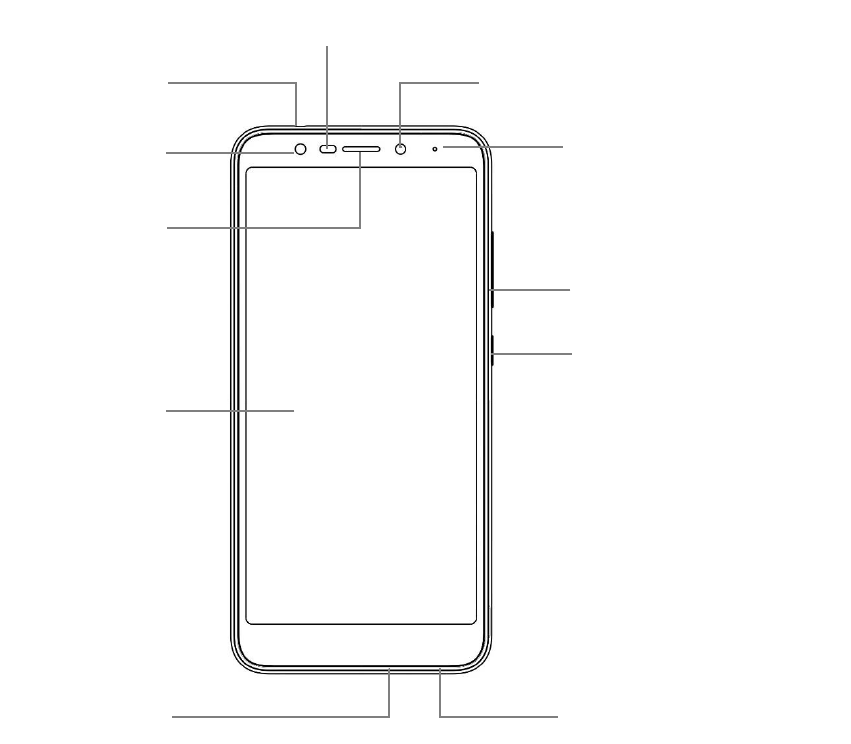
3
Set up your phone
The following topics give you all the information you need to set up your phone and wireless
service the first time.
Parts and functions
These topics illustrate your phone’s primary parts and key functions.
Note: Your phone's screens and apps layouts are subject to change. This user guide uses
sample images only.
Phone Layout
Headset Jack
Front camera
Volume key
Power key
LED indicator
Proximity sensor
Charger/Accessory jack
Receiver
Touch screen
Microphone
Flash

4
Part
Description
Front camera
Take pictures and record videos while facing the screen and
conduct video conference.
Receiver
Hear the caller and automated prompts.
Touchscreen
Display all the information needed to operate your phone,
such as the call status, the Contacts list, and the date and
time. It also provides one-tap access to all of your features
and applications.
Power key
Press to turn the screen on or off.
Press and hold to switch the phone on or off, to restart it.
Charger/Accessory jack
Connect the USB cable (included) for charging or connect
other accessories.
Volume keys
Adjust the volume for ringtones, media, notifications, and
system sounds.
Headset jack
Plug in either an optional stereo headset or an optional
headset for convenient, hands-free conversations.
Microphone
Used for transmitting your voice electronically for a call, voice
recording, or video recording.
CAUTION! Inserting an accessory into the incorrect jack may damage the phone.
Battery use
The following topics explain how to insert and remove your phone’s battery.
Battery cautions
Storage: Avoid storing or leaving battery with no charge remaining. Saved information and
settings may become lost or changed, or battery may become unusable. Charge once
every six months before storing or leaving unused for a long period.
Bulges: Depending on use, bulges may appear near end of battery life. This does not affect
safety.
Replacing battery: The battery is a consumable item. It needs to be replaced if operating
time shortens noticeably. Purchase a new battery.
Cleaning: Clean soiled terminals between battery and phone with a clean, dry cotton swab.
Soiled terminals can result in a poor connection and prevent charging, etc.
Insert the battery
Follow these instructions to insert your phone’s battery safely and properly.
1. Remove the battery cover.

5
Lift gently in the direction shown.
2. Insert the battery.
Align the contacts of the battery with the contacts in the phone and gently press the battery
down into place.
3. Attach the battery cover.
Make sure that all the tabs are secure and there are no gaps around the cover.
Remove the battery
Follow these instructions to remove your phone’s battery. Always power the phone off before
removing the battery.
1. Remove the battery cover.

6
2. Remove the battery.
Lift upward gently as shown.
Charge the battery
Follow these instructions to charge your phone’s battery using either the included AC adapter
or via a USB connection on your computer.
Charge using the AC adapter
1. Plug the USB connector into the charger/accessory jack on the bottom of your phone.
2. Plug the other end of the USB cable into the AC adapter.
3. Plug the AC adapter into an electrical outlet.
The indicator light illuminates red when charging starts. The light turns to green when the
battery is fully charged. Fully charging a battery may take up to 3.5 hours.
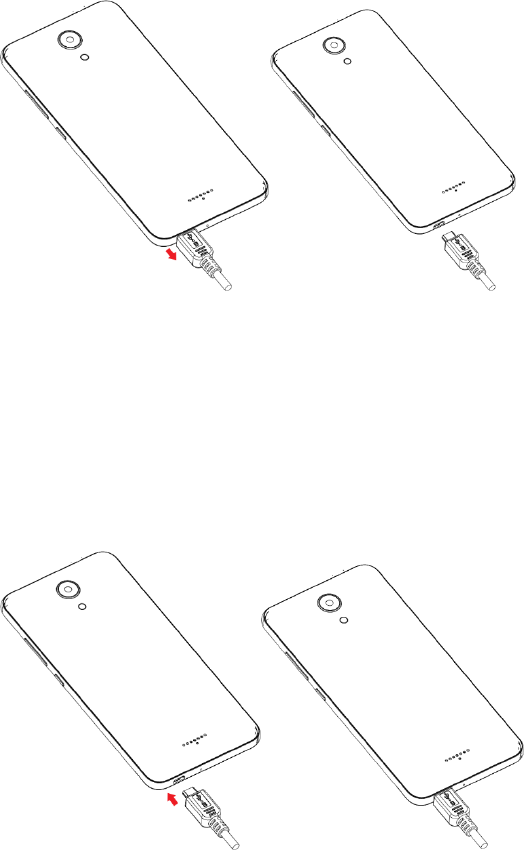
7
4. After charging, disconnect the phone from the charger.
Unplug the AC adapter from the outlet and remove the USB cable from the phone and the
AC adapter.
Charge using a PC connection
Before using a PC connection to charge your phone, ensure that the computer is turned on.
Depending on the type of connection, your phone’s battery may not charge.
1. Insert the small end of the USB cord into the charger/accessory jack on the bottom of your
phone.
2. Insert the large end of the USB cord into an external USB port on your computer.
3. After charging, remove the USB cable from both the phone and the computer.
SIM card
The SIM card is an IC card containing phone number and other customer information. Your
phone’s SIM card is preinstalled and should only be accessed if directed by a customer service
representative.
SD card
Your phone supports the use of an optional SD card (not included) to expand its storage
capacity. It supports cards up to 64 GB. Some cards may not operate properly with your phone.

8
SD card cautions
Data: Information stored on an SD card can become lost or changed accidentally or as a
result of damage. It is recommended that you keep a separate copy of important data. Wiko
is not responsible for damages from data that is lost or changed.
Reading/Writing data: Never power off or remove the battery while reading or writing data.
Battery level: A low battery charge may prevent reading/writing to an SD card.
Handling SD card: Use/store SD cards away from the reach of infants, otherwise it may
cause choking if swallowed.
Insert an SD card
Follow these steps to insert an optional SD card (not included).
1. Remove the battery cover.
2. Insert SD card.
Insert SD card all the way gently without bending and with terminals facing down.
3. Insert the battery and attach the battery cover (see Insert the battery).
Unmount an SD card
Always unmount an SD card before removing it from your phone to avoid corrupting or
damaging the files in the storage card.
1. From home, swipe up to access Apps, and tap Settings .
2. Tap Storage > .
Your SD card is now safely ejected. To use this SD card again, you will need to mount it first by
the following steps:
1. From home, swipe up to access Apps and tap Settings .
2. Tap Storage > SD card.
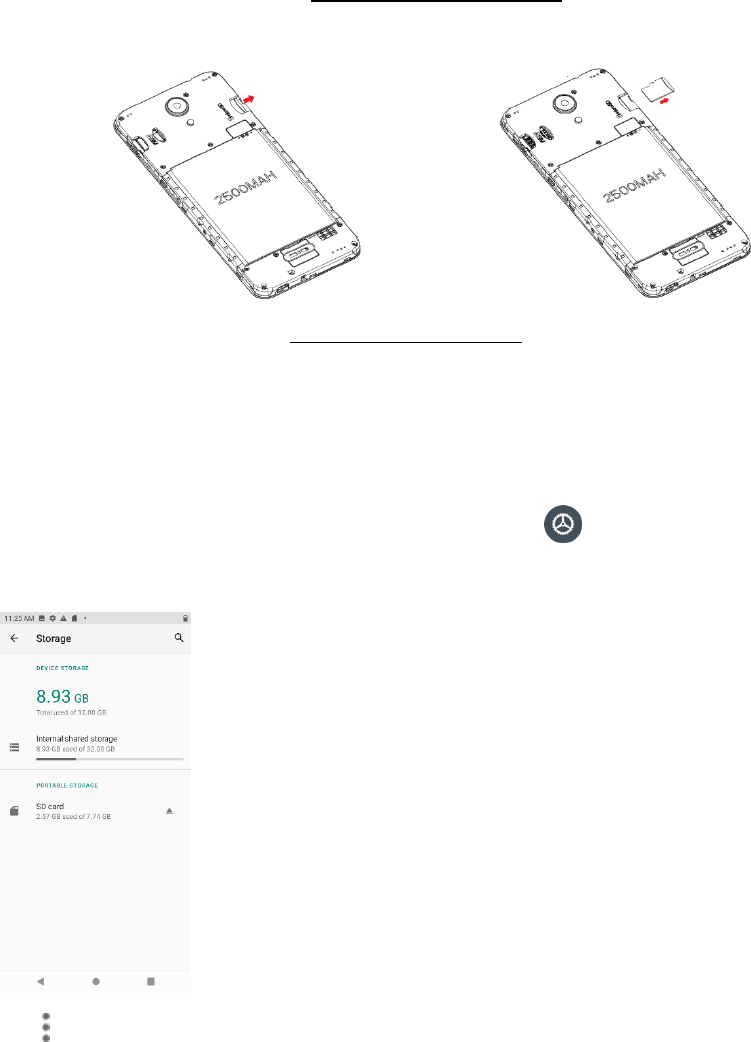
9
3. Tap MOUNT on the prompted screen.
Remove an SD card
Follow these instructions to remove an SD card.
1. Remove the battery cover (see Remove the battery cover).
2. Remove SD card.
3. Attach the battery cover (see Attach the battery cover).
Format an SD card
When you insert an optional SD card for the first time, it is recommended that you format it on
your phone. When formatting an SD card, you should back up your music and photo files that
are stored on the card as formatting the SD card deletes all the stored data.
1. From home, swipe up to access Apps and tap Settings .
2. Tap Storage > SD card.
3. Tap to access options menu, and tap Storage settings.
4. Select Format or Format as internal, and then tap FORMAT SD CARD to confirm.

10
All data on the SD card is erased, and the card is formatted for use on your phone.
Turn your phone on and off
The instructions below explain how to turn your phone on and off.
Turn your phone on
Press and hold the Power key until the device turns on.
Turn your phone off
1. Press and hold the Power key.
2. Tap Power off.
Use the touchscreen
Your phone’s touchscreen lets you control actions through a variety of touch gestures.
Tap or touch
When you want to type using the onscreen keyboard, select items onscreen such as
application and settings icons, or press onscreen buttons, simply tap or touch them with your
finger.
Touch and hold
To open the available options for an item (for example, a contact or link in a Web page), touch
and hold the item.

11
Swipe or slide
To swipe or slide means to quickly drag your finger vertically or horizontally across the screen.
Drag
To drag, press and hold your finger with some pressure before you start to move your finger.
While dragging, do not release your finger until you have reached the target position.
Flick
Flicking the screen is similar to swiping, except that you need to swipe your finger in light, quick
strokes. This finger gesture is always in a vertical direction, such as when flicking the contacts
or message list.
Rotate
For most screens, you can automatically change the screen orientation from portrait to
landscape by turning the phone sideways. When entering text, you can turn the phone
sideways to bring up a bigger keyboard. See Touchscreen keyboards for more details.
Note: To activate auto-rotate mode, swipe up from Home screen to access Apps, and tap
Settings > Display > Auto-rotate screen, and slide the switch to the On position.
You can also activate it by dragging down status bar and tap Auto-rotate .
Pinch and spread
“Pinch” the screen using your thumb and forefinger to zoom out or “spread” the screen to zoom
in when viewing a picture or a Web page. (Move fingers inward to zoom out and outward to
zoom in.)

12
Activation and service
Before using your phone, you must set up your service.
1. Press and hold the Power button to turn your phone on. Allow hands-free activation to
connect the phone to the network and then allow the phone to check for any updates. The
phone will then power off.
2. After the phone turns back on, the device may ask you to complete a few setup screens to
customize your phone. You may need to skip the setup screens and complete step 3 first.
3. From Home screen, tap Phone and Dialer pad . Dial 611, tap Call and then
follow the recorded directions.
Complete the setup screens
Once your service has been activated, you will need to run Setup. The Setup Wizard will
appear to guide you through the basic settings on your device.
Select a default language you want to use, connect to Wi-Fi (if to available), enter your name to
personalize some apps, set screen lock method, sign in to your Google™ Account, select
location services, and more.
Follow the remaining instructions to finish your phone setup.

13
Basic operations
The following topics outline basic features and operations of your phone.
Home screen and applications (Apps) list
Most of your phone’s operations originate from the Home screen or the apps list.
1. From any screen press the Home button to display the Home screen.
2. From home, swipe up to access Apps.
For information about using the Home screen, see Home screen basics.
Select options and navigate screens
Tap icons, onscreen buttons, and other items to open or activate the assigned function.
• Tap Back button to return to the previous screen.
Recent applications
You can display a list of recently used applications using the Recent Apps button .
• Tap Recent Apps button to view a list of recently used applications.

14
For more information, see Switch between recently opened apps.
Phone settings menu
You can customize your phone’s settings and options through the Settings menu.
1. From Home, swipe up to access Apps and tap Settings .
2. Or you can also drag the status bar down twice and tap Settings
For more information, see Basic settings.
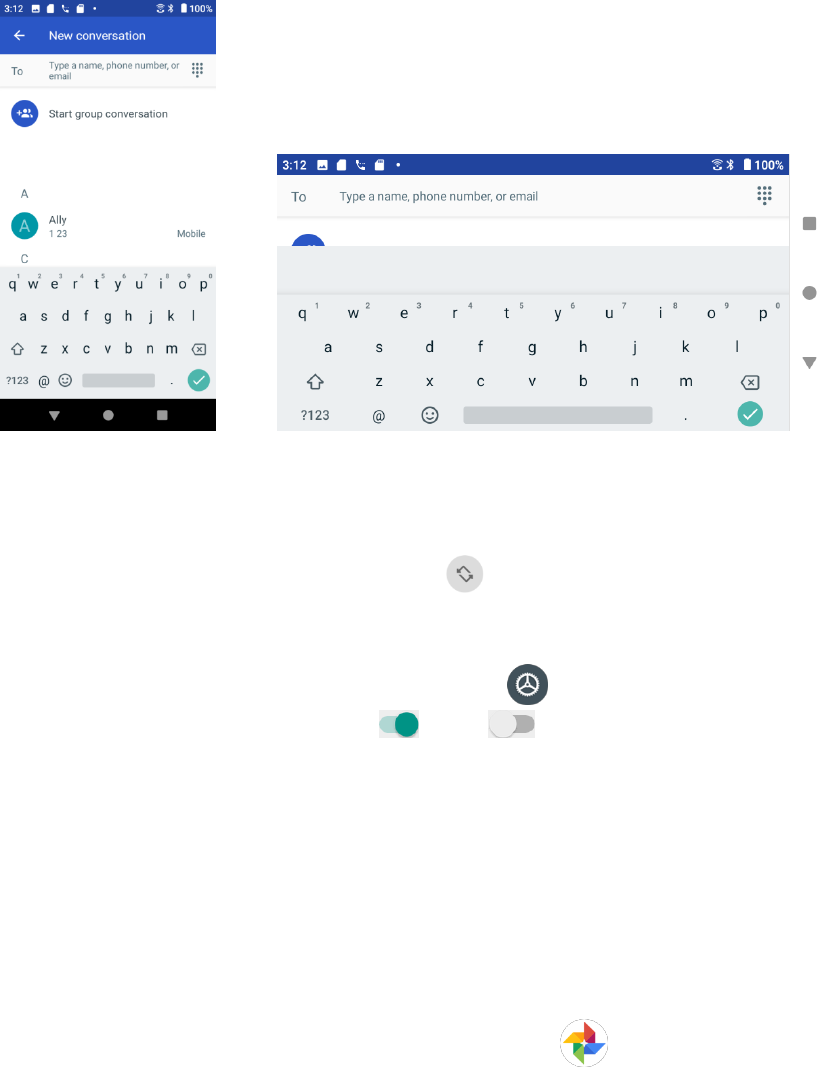
15
Portrait and landscape screen orientation
The default orientation for your phone’s screen is portrait (vertical), but many apps will change
to landscape orientation (widescreen) when you rotate the phone sideways.
Note: Not all screens will adjust for landscape orientation.
Turn screen rotation on or off
1. Drag the status bar down. Tap Auto-rotation to turn the option on or off.
2. You can also set the rotation option from the Settings menu.
From home, swipe up to access Apps, tap Settings , and tap Display > Auto-rotate
screen, and slide the switch to the On or Off position to activate or deactivate it.
Capture screenshots
To capture a screenshot, you can follow either of the following two ways:
• Press and hold the Power key and Volume down key at the same time to capture a
screenshot of the current screen.
• Touch and hold the Power key from the screen you want to capture a screenshot, and tap
Screenshot.
The screenshots you’ve taken will be stored in the Screenshots album in the phone’s Photos
app. From home, swipe up to access Apps, and tap Photos.

16
Applications
The following topics describe how to access the applications (Apps) list and launch apps on
your phone.
Launch applications
All installed apps can be accessed and launched from the apps list.
1. From home, swipe up to access Apps.
2. Tap an app icon to launch the corresponding application.
Working with apps
Group apps into a folder
1. Touch and hold an app and drag it over to another app to create a folder automatically.
2. To add more apps to the folder, drag each app over to the folder.
3. To name or rename the folder, open the folder, tap the title bar, and then enter a folder
name.

17
Remove apps from a folder
1. Tap the folder to open it.
2. Touch and hold an app in the folder and drag it out to the Home screen.
App shortcuts
Touch and hold an app icon on the Home screen or the Apps screen to display a menu that lets
you quickly access common app functions.
Note: Not all apps support the app shortcuts feature.
Switch between recently opened apps
You can easily switch between the apps you've recently opened.
Tap Recent Apps button to see your recently-opened apps.
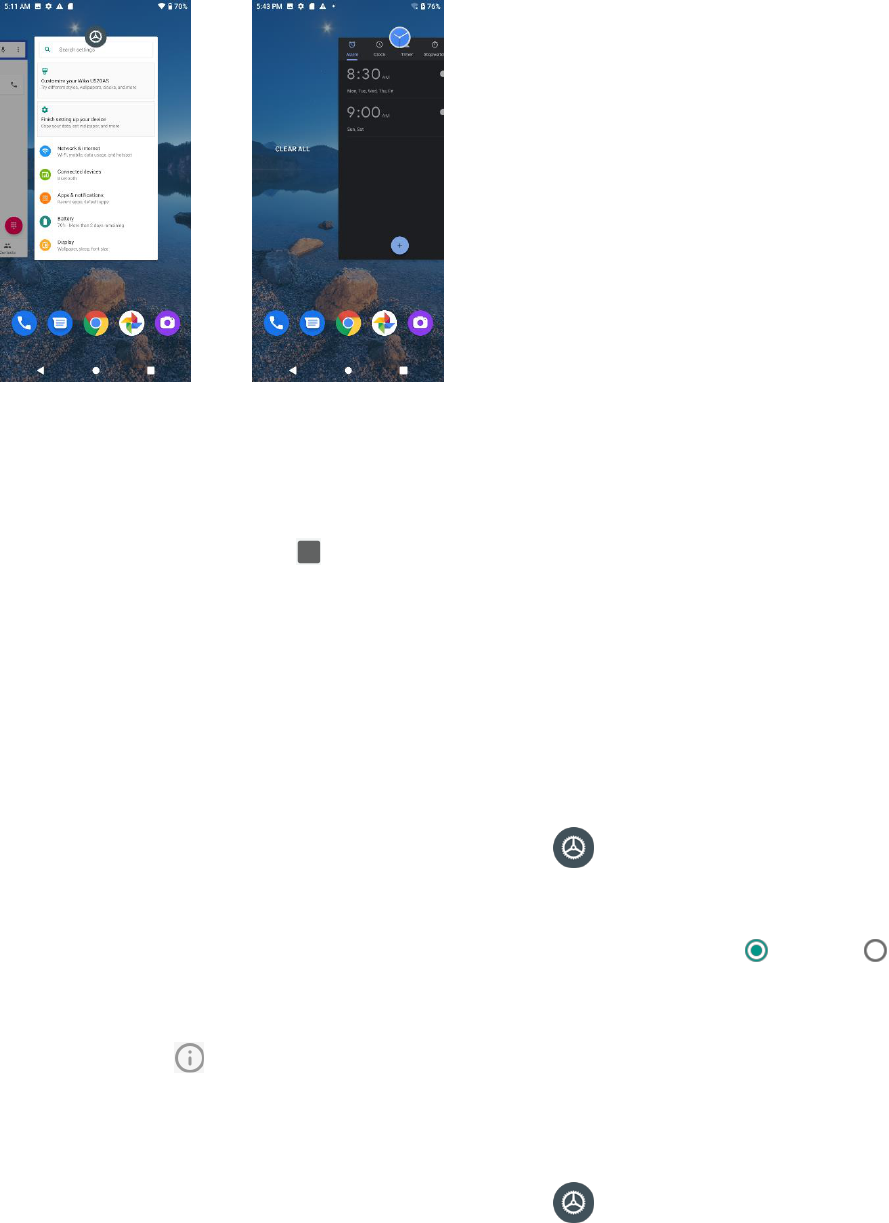
18
1. To locate an app, swipe right or left through the cards to find the app and tap it.
2. To remove an app, slide it up.
3. To remove all of the apps, slide the screen to the left side and tap CLEAR ALL.
You can tap Recent Apps button twice to quickly switch between two most recently used
apps.
Control app permissions
The first time you open an app, you’ll be asked to grant permission to access certain data or
features. This makes sure that you have full control of which apps have authorized access.
If you don’t want to grant access for one app, you can choose Deny. If you choose Deny in a
trusted app, you may not be able to use the app or access all the functions. To modify
permission settings, you can follow the below steps:
1. From home, swipe up to access Apps, and tap Settings .
2. Tap Apps & notifications > Permissions manager.
3. Tap the app you want to modify permissions, and select the switch to Allow or Deny
position to adjust the permission settings.
4. You can also access permission settings by touching and hold the app on Home screen or
Apps screen, tap to access App info screen, and tap Permissions.
Set default apps
You can choose default apps for web browsing, text messaging, and more.
1. From home, swipe up to access Apps, and tap Settings .
2. Tap Apps & notifications > Default apps.
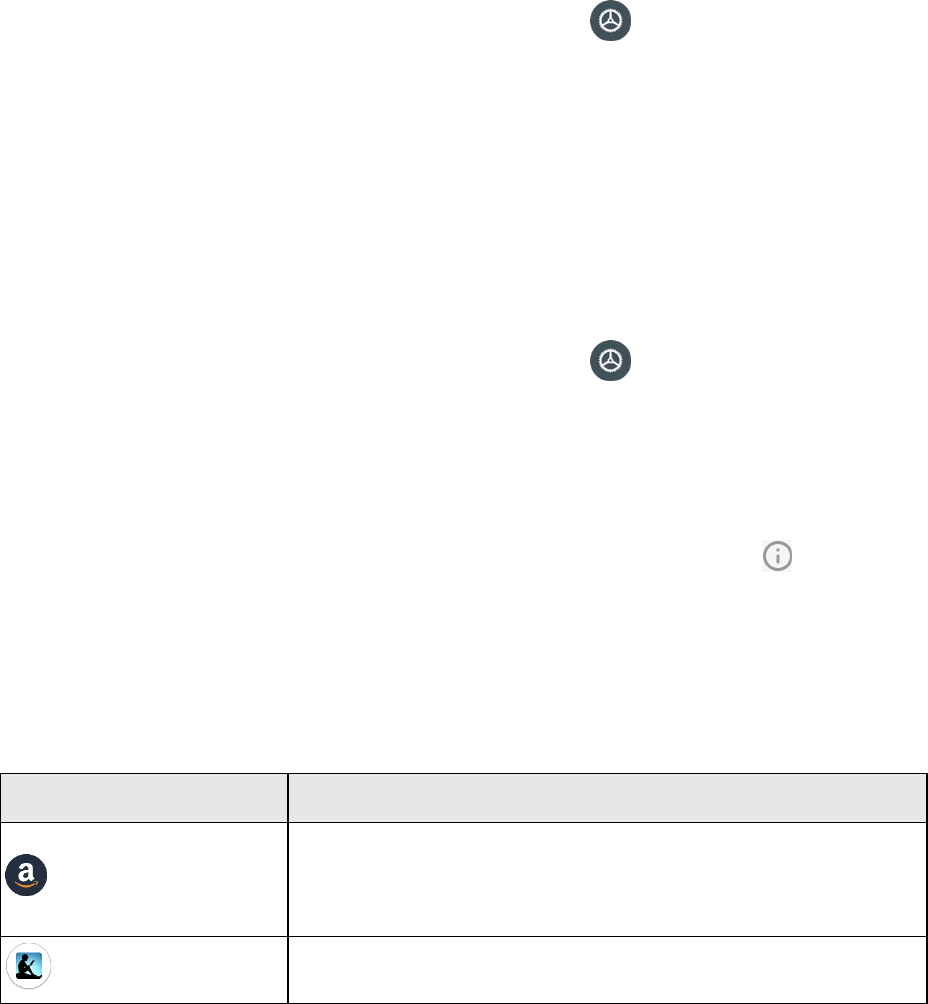
19
3. Choose your default web browser, phone, messages, and more.
Set up app links
When you tap a link, there may be more than one app that can open it, and you’ll need to
choose the app you want to use on the prompted screen. You can also tap Always on the
prompt screen to set that app as the default to use.
You can also set different apps as default one to open the link by Settings menu.
1. From home, swipe up to access Apps, and tap Settings .
2. Tap Apps & notifications > Default apps > Opening links.
3. Tap the app you want to set and tap Open supported links.
4. Choose Open in this app to set this app as default one to open when you tap a link. You
can also choose Ask every time or Don’t open in this app according to your preference.
Disable an app
You can disable some default apps which can’t be uninstalled to avoid them running in the
background and downloading data.
1. From home, swipe up to access Apps, and tap Settings .
2. Tap Apps & notifications.
3. Tap the app you want to disable to access App info screen.
4. Tap Disable.
Tip: You can also touch and hold an app on Home screen or Apps screen, tap to access
App info screen, and tap Disable.
Apps list
The apps list expands to include any apps you download and install on your phone. The
following table outlines the primary apps that have been preinstalled on your phone.
App
Function/Service
Amazon Assistant
Amazon Assistant helps you make better decisions wherever
you shop online by comparing products from Amazon as you
shop on retailer websites. Keep an eye out for product and price
comparisons that can save you time and money.
Amazon Kindle
The Kindle app puts millions of books, magazines, newspapers,
comics, and manga at your fingertips. Read anytime, anywhere.

20
App
Function/Service
Assistant
Your Google Assistant allows you to make calls, send
messages, open an app or perform other commands, all with
your voice.
Calculator
Perform basic and advanced mathematical calculations.
Calendar
Create and manage events, meetings, and appointments,
organize your time and remind you of important events.
Camera
Take and share pictures and videos.
Chrome
A browser you can use to surf the Internet.
Clock
Set alarms, view time in time zones around the world, use a
stopwatch, set a timer, and use your phone as a desk clock.
Contacts
Manage your contacts from a variety of sources.
Drive
Allows users to store files on Google servers, synchronize files
across devices, and share files.
Duo
Lets users make video calls in high definition.
Files
Check the category of documents, pictures, videos and
downloads.
FM Radio
Insert an earphone to listen to Radio channels.
Gmail
Send, receive, and manage your Gmail messages.
Google
Search information saved on the phone and in phone
applications as well as on the Internet.
Maps
Determine your location, find directions, browse local
businesses and attractions, rate and review places, and more.
Messages
Send and receive text messages.
Phone
Place and receive calls, use voicemail, set up and manage
contacts, and more.
Photos
Manages your photos including backing up and searching.

21
Play Movies & TV
Buy or rent movies and TV shows,and watch them on your TV,
smartphone,and more.
Play Store
Provide new Android apps, books, movies, and music for your
phone.
Settings
Provide an overview of items you can change through Settings.
Sound Recorder
Record sounds and play them back.
YouTube
Video-sharing website allows you to watch videos, upload
videos, etc.
YT Music
Music app that allows you to find the music you want and
discover new music.
Boost Perks
Boost Perks gives you access to special deals, exclusive perks
and chances to win one-of-a-kind experiences—and it’s all
included as part of your Boost service.
My boost
Registered your Boost account. Simplify the way you manage
your Boost Mobile account.
Phone number
Follow the instructions below to display your phone’s wireless phone number.
1. From home, swipe up to access Apps, and tap Settings .
2. Tap About phone.
3. You will see the phone number listed under Phone number.
Airplane mode
Airplane mode turns off all functions that emit or receive signals while leaving your phone on so
you can use apps that don’t require a signal or data.
To turn on airplane mode
1. From home, swipe up to access Apps, and tap Settings .
2. Tap Network & Internet > Airplane mode.
3. Slide the switch to the On position to activate the airplane mode.
You will see the airplane mode icon on the status bar.
To turn off airplane mode
1. From home, swipe up to access Apps, and tap Settings .

22
2. Tap Network & Internet > Airplane mode.
3. Slide the switch to the Off position to deactivate the airplane mode.
Your phone’s wireless connection features are now restored.
Tip: You can also access airplane mode through the status bar menu. Drag the status bar down
twice to access Quick Settings Panel and tap Airplane mode to have it enabled or disabled.
Note: Airplane mode may not be displayed on the first screen of the Quick Settings Panel, you
need to slide to the right to the next screen to locate it.
Enter text
You can type on your phone using one of the available touchscreen keyboards or Google voice
typing.
Touchscreen keyboards
Your phone offers you a choice of Google touchscreen keyboards for entering text. The
keyboard appears automatically onscreen when you tap a text entry field, and they can be used
in either portrait or landscape mode. You can also use the Google Voice typing option to enter
text using your voice (see Google voice typing for details).
Note: Keyboard layouts and options may change depending on where you’re using them. For
example, if you’re entering text to do a Web search, a search icon may be available instead of
an enter key.
Google keyboard
The Google keyboard offers a traditional QWERTY keyboard setup for entering text by tapping
keys (like on a computer), along with enhancements and options that allow you to enter text
faster and more accurately, such as continuous key input, personalized usage dictionaries, and
more.

23
Use Google keyboard
1. From home, swipe up to access Apps, and tap Settings .
2. Tap System > Languages & input > Virtual keyboard > Gboard.
Google voice typing
Google voice typing uses Google voice recognition to convert speech to text.
Tips for editing text
Your phone gives you many options to make entering text easier, including copying, cutting,
and pasting text, using voice-to-text input, customizing the user dictionary, using predictive text,
and more.
To edit text you have already entered:
1. Touch and hold or double-tap within the text you would like to edit.
2. Drag the tabs to change the highlighted selection.
3. The following options will appear: Cut, Copy, Paste, Share and Select all, (only after the
Copy action).

24
To insert new text:
1. Touch where you want to type, or touch and hold a blank space, the cursor will blink and the
tabs will show. Drag the tab to move the cursor.
2. If you have selected any text, tap the tab to show Paste which allows you to paste any text
you have previously copied.
Google Account
You will need a Google Account to access several phone features such as Gmail, Google
Maps, Duo, and the Google Play applications. Before you are able to access Google
applications, you must enter your account information. These applications sync between your
phone and your online Google Account.
Google Account cautions
Be sure not to forget your Google Account ID or password.
Create a Google Account
If you do not already have a Google Account, you can create one online or using your phone.
Note: You can also create and sign into your Google/Gmail account through your phone’s
Settings application.
Create a Google Account online
1. From a computer, launch a Web browser and navigate to google.com.
2. On the main page, click Sign-in > Create an account.
3. Follow the onscreen prompts to create your free account.
4. Look for an email from Google in the email box you provided and respond to the email to
confirm and activate your new account.

25
Create a Google Account using your phone
1. From home, swipe up to access Apps, and tap Settings .
2. Tap Accounts > Add account.
3. Tap Google and then tap or create a new account.
4. Follow the prompts to set up your account. Tap Next to proceed between steps, which may
include:
• Enter your First name and Last name.
• Enter a desired Username.
• Enter and reenter a password.
• Create a security question and answer, enter a secondary email address to help you
recover your password if you ever lose it.
• On the Finish account screen, select your Web history and additional Google Play
options.
• Enter the letters from the Authenticating screen.
• After your phone connects with the Google servers, select the items you would like to
sync with your phone and then tap Sync now.
5. Tap Finish setup.
Note: When setting up a new Google Account, either on your phone or online, you will be
prompted to add a secondary email address. Enter a second Gmail address or any other email
address from which you currently send and receive email. This address is used to authenticate
your account should you ever encounter problems or forget your password. It is strongly
encouraged for Android users so you can regain access to Google services and purchases on
your phone.

26
Sign in to your Google Account
If you have a Google Account but have not yet signed in with your phone, follow these
instructions to sign in to your Google Account.
1. From home, swipe up to access Apps, and tap Settings .
2. Tap Accounts > Add account.
3. Tap Google, and then tap Enter your email.
4. Enter your Gmail address and password, and then tap Next.
5. After your phone connects with the Google servers, select the items you would like to sync
with your phone and then tap Sync now.
6. Tap Finish setup.
Google Play Store
Google Play™ is the place to go to find new Android apps, books, movies, and music for your
phone. Choose from a wide variety of free and paid content ranging from productivity apps and
games to bestselling books and blockbuster movies and music. When you find what you want,
you can easily download and install it on your phone.
To access the Google Play store app, you must first connect to the Internet using your phone’s
Wi-Fi or mobile data connection and sign in to your Google Account. See Sign in to your
Google account for details.
Installing applications
Many different kinds of applications can be installed on your phone from Google Play
(provided by Google Inc.). Wiko is not responsible in any way for user-installed applications
(quality, reliability, legality, fitness for a purpose, credibility, accuracy, etc.) or resulting
malfunctions (viruses, etc.).

27
Important: Our policies often do not apply to third-party applications. Third-party applications
may access your personal information or require us to disclose your customer information to
the third-party application provider. To find out how a third-party application will collect, access,
use, or disclose your personal information, check the application provider’s policies, which can
usually be found on their website. If you aren’t comfortable with the third-party application’s
policies, don’t use the application.
Find and install an app
When you install apps from Google Play app and use them on your phone, they may require
access to your personal information (such as your location, contact data, and more) or access
to certain functions or settings of your phone. Download and install only apps that you trust.
1. From home, swipe up to access Apps, and tap Play Store .
2. When you open the Google Play store app for the first time, the Terms of Service window
will appear. Tap Accept to continue.
3. Browse through the categories (Apps, Games, Movies & TV, Music, Books, or
Newsstand), find an item you're interested in, and tap the name.
• Browse through featured apps. Scroll through the list of featured apps when you open
Google Play.
• Search for an app. Tap in the search bar at the top of the Google Play home screen,
enter the name or type of app you’re looking for, and then tap on the keyboard.
4. Tap an app to read a description about the app and user reviews.
5. Tap Install (for free applications) or the price (for paid applications).
Note: If you have not already done so, you will need to set up a payment method to purchase
paid apps from Google Play.

28
6. The subsequent screen notifies you whether the app will require access to your personal
information or access to certain functions or settings of your phone. If you agree to the
conditions, tap ACCEPT (for free apps) or ACCEPT and then BUY (for paid apps) to begin
downloading and installing the app.
• If you have not already set up a payment method, tap CONTINUE and then follow the
prompts to arrange payment and complete the purchase.
The selected app is downloaded and installed on your phone.
Warning: Read the notification carefully! Be especially cautious with applications that have
access to many functions or a significant amount of your data. Once you tap OK on this screen,
you are responsible for the results of using this item on your phone.
Purchasing applications
Purchase apps at your own risk. Wiko is not responsible for any harm to you or third parties
resulting from the use of purchased applications.
Request a refund for a paid app
If you are not satisfied with an app, you can ask for a refund within 15 minutes of the purchase.
Your credit card is not charged and the app is uninstalled from your phone.
If you change your mind, you can install the app again, but you can’t request a refund a second
time.
1. From home, swipe up to access Apps, and tap Play Store .
2. Tap Menu > My apps & games.
3. Tap the app to uninstall for a refund. The details screen for the app opens.
4. Tap Refund, and then tap Yes to confirm. Your app is uninstalled and the charge is
canceled.
Update an app
Depending on your settings, many apps will update automatically, or you can update apps
directly from the Play Store app.
Update an App Directly
1. From home, swipe up to access Apps, and tap Play Store .
2. Tap Menu > My apps & games.

29
3. Tap the app you want to update, and then tap Update > Accept.
The app update is downloaded and installed.
Set Automatic App Updates
1. From home, swipe up to access Apps, and tap Play Store .
2. Tap Menu > Settings.
3. Tap the app you want to set for auto-update, and then tap Auto-update.
The app is set to update automatically whenever an update becomes available.
Note: Automatic updates are unavailable for some apps.
Uninstall an app
You can uninstall any app that you have downloaded and installed from Google Play.
1. From home, swipe up to access Apps, and tap Play Store .
2. Tap Menu > My apps & games.
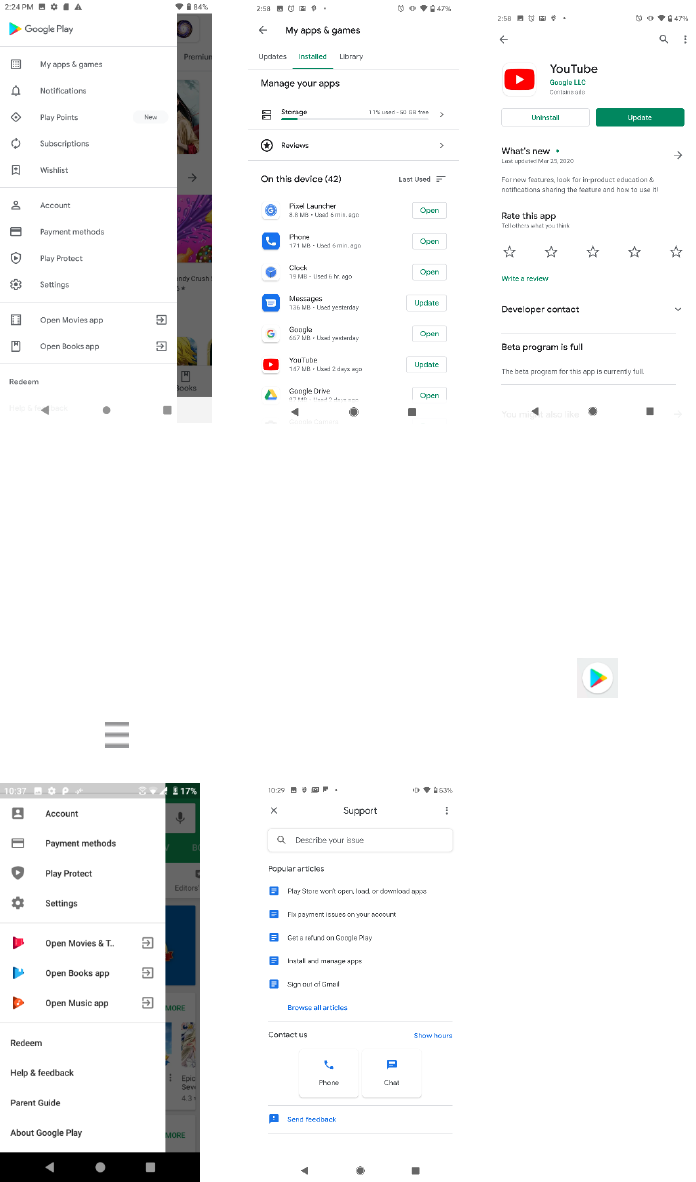
30
3. On the Installed screen, tap the app you want to uninstall, and then tap UNINSTALL > OK.
The app is uninstalled and removed from your phone.
Get help with Google Play
The Google Play store app offers an online help option if you have questions or wants to know
more about the app.
1. From home, swipe up to access Apps, and tap Play Store .
2. Tap Menu > Help & Feedback.
The Web browser will take you to the Google Play Help Web page, where you will find
comprehensive, categorized information about Google Play.

31
Lock and unlock your screen
Your phone allows you to quickly turn the screen off when not in use and to turn it back on and
unlock it when you need it.
Turn the screen off when not in use
To quickly turn the screen off, press the Power key. Pressing the Power key again or receiving
an incoming call will turn on your phone screen and show the lock screen.
To save battery power, the phone automatically turns off the screen after a certain period of
time when you leave it idle. You will still be able to receive messages and calls while the
phone’s screen is off.
Note: For information on how to adjust the time before the screen turns off, see Display
settings.
Turn the screen on and unlock it
1. To turn the screen on, press the Power key.
2. Swipe your finger across the screen from bottom to top to unlock it.
If you have set up a screen lock, you will be prompted to draw the pattern or enter the
password or PIN. See Screen lock for details.
Update your phone
From time to time, updates may become available for your phone. You can download and apply
updates through the Settings > System > Advanced >System updates menu.
Software update cautions
Update Size: Any update larger than 100MB will require you to connect to Wi-Fi as the
update cannot be downloaded over the cellular network.
During update: The phone cannot be used until the software update is complete. It may
take time to update your phone’s software.
Signal during update: Update your phone where signal reception is good, and do not
change location during the update process. Make sure the battery is adequately charged
before beginning an update. A weak signal or low battery during an update may cause the
update to fail. An update failure may disable the phone.
Other functions during update: Other phone functions cannot be used during a software
update.
Update your phone software
You can update your phone's software using the System update option.

32
Before updating your phone
Updating your phone may result in a loss of saved data depending on the condition of your
phone (malfunctioning, damaged, water seepage, etc.). You must back up all critical information
before updating your phone firmware.
Back up all data prior to update
To back up your Gmail information:
1. From home, swipe up to access Apps, and tap Settings .
2. Tap Accounts > Google.
3. Tap Account sync.
• If the Account sync option is already on, the switch will be to the right in the on position.
• If the Account sync option is off, slide the switch to the right so it is in the on position.
To back up your Exchange Mail information:
1. From home, swipe up to access Apps, and tap Settings .
2. Tap Accounts > Exchange > Sync now.
3. Tap the sync icon within the corporate account field to reveal the account’s synchronization
settings screen.
4. Toggle the onscreen checkmark to manually synchronize the desired parameters (Contacts
or Calendar).
To back up stored text messages:
1. From home, swipe up to access Apps, and tap Messages .
2. Select the text message from the list to view the message thread.
3. Touch and hold on a portion of the text message from the string. The Message options
context menu appears.
Note: You can back up stored text messages by forwarding them to your own phone number.
Open the messages after you have updated your firmware.
4. Tap Forward.
5. Enter your phone number and tap Send.
To restore your Google apps following the update:
1. From home, swipe up to access Apps, and tap Play Store .

33
2. Tap Menu > My apps & games > Library tab.
3. Scroll through the list of previously downloaded Google apps and choose those you wish to
reinstall.
4. Follow the onscreen instructions.
Note: Your Google app purchases are reloaded remotely and can be re-installed after the
update is applied.
As an added precaution, to preserve any data on your microSD card, please unmount it from
your phone prior to starting the update process. From home, swipe up to access Apps, and
tap Settings > Storage, and tap to eject the SD card.
Update your phone’s software
Once you have backed up all your data, use the Update now option to update your phone’s
software.
1. From home, swipe up to access Apps, and tap Settings .
2. Tap System > Advanced > System updates > System update > Check for update.
3. Tap .
Your phone automatically downloads and installs any available updates. You may be required
to power your phone off and back on to complete the software upgrade.
Alternatively, you can access system updates through the notification panel.
1. Drag the status bar down.
2. Locate the System update available icon ( ) in notifications.
3. Tap to open the System updates screen.
4. Tap Download and follow the onscreen instructions.
The downloading icon appears within the status bar to indicate the phone is downloading the
necessary files.
5. Tap Restart and install to complete the process.
Confirm your current phone software
1. From home, swipe up to access Apps, and tap Settings .
2. Tap About phone.

34
3. Locate the Software version on the screen displayed.
Update your profile
This option allows you to automatically update your online user profile information. If you
choose to change your user name and select a new one online, you must then update the user
name on your phone.
1. From home, swipe up to access Apps, and tap Settings .
2. Tap System > Advanced > System updates > Update profile.
3. Follow the onscreen instructions.
The phone will download and install the profile update and you will see a confirmation when
complete.
Note: If your data services or account syncing ever seems to go out unexpectedly, use this
feature to reconnect with the network.
Update your PRL
This option allows you to download and update the PRL (preferred roaming list) automatically.
1. From home, swipe up to access Apps, and tap Settings .
2. Tap System > Advanced > System updates > Update PRL.
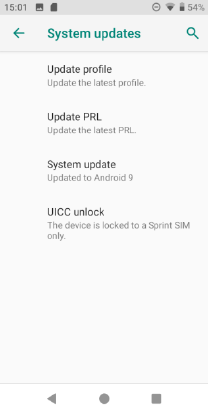
35
3. Follow the onscreen instructions.
The phone will download and install the PRL update and you will see a confirmation when
complete.
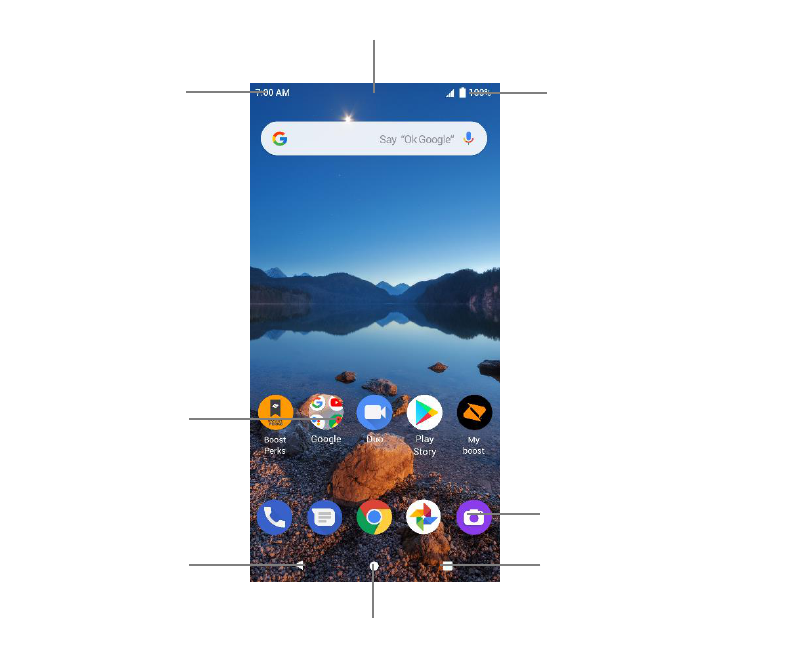
36
Your phone’s home screen
The following topics describe how to use and customize your phone’s home screen,
understand the status bar, and use the notification panel.
Home screen basics
The home screen is the starting point for your phone’s applications, functions, and menus. You
can customize your home screen by adding application icons, shortcuts, folders, widgets, and
more.
Home screen layout
Your home screen extends beyond the initial screen. Slide the screen left or right to display
additional screens.
Status bar
Status area
Notification area
Widgets
Application icons/
Primary shortcuts
Home button
Back button
Recent apps button
button

37
Item
Description
Status bar
Displays icons to notify you of your phone’s status (on the right
side) and notifications (on the left side).
Notification area
Displays notifications for incoming messages, missed calls,
application updates, and more. Drag the status bar down to display
the notification panel.
Status area
Displays phone and service status information such as signal
strength, battery status, Wi-Fi and data connectivity, ringer status,
and time.
Widget
Widgets are self-contained onscreen apps that reside on your
phone’s home screen.
Application icons
Application icons are shortcuts to favorite applications. You can add
and remove these shortcuts as you wish.
Primary shortcuts
Primary shortcuts are application shortcuts that appear in the same
location on all of your phone’s home screens. These are
customizable except for the Applications (Apps) shortcut, which
remains static.
Recent Apps button
Tap to display a list of recently used applications.
Home button
Tap to display the main home screen.
Back button
Tap to return to the previous screen.
Note: Your phone’s home screens cycle through so that you can keep swiping in one direction
and make it back to the main Home screen. The small circles above the primary shortcuts let
you know your current screen position.
Tip: Press Home button to return to the main Home screen from any other screen.
Extended home screens
In addition to the main Home screen, your phone features extended home screen to provide
more space for adding icons, widgets, and more. Press Home button to display the main
home screen and then slide the screen right to move from the main screen to an extended
screen.
To add a new Home screen, drag an app or a widget icon to the right edge of the main screen,
and release the icon till a new home screen is displayed.
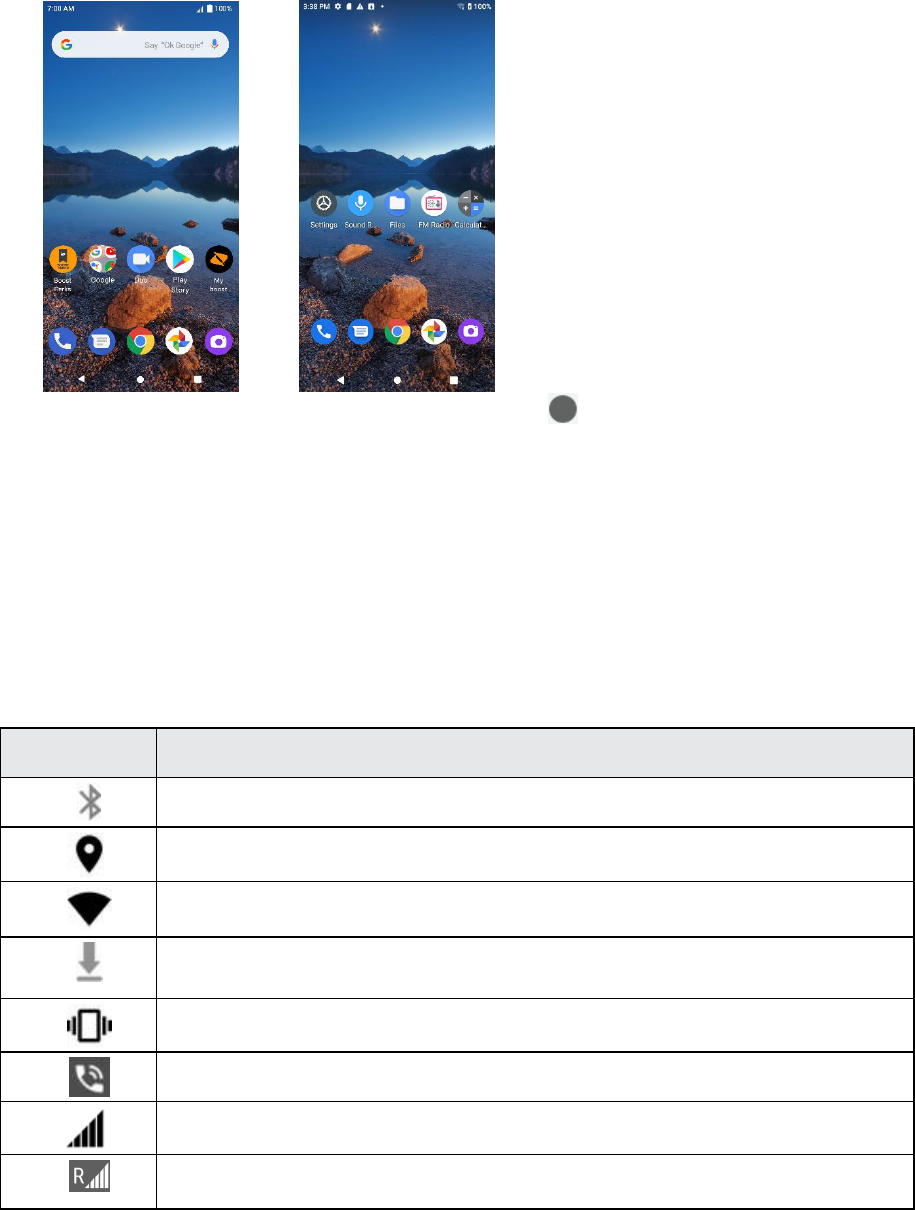
38
• While on an extended screen, press Home button to return to the main Home screen.
Status bar and notification panel
Your phone’s status and notifications are available at a glance at the top of the screen.
Status bar
The status bar at the top of the home screen provides phone and service status information on
the right side and notification alerts on the left. To view the notification panel or access the quick
settings menu, drag the status bar down from the top of the screen.
Main status icons
Icon
Status
Bluetooth
®
active
GPS active
Wi-Fi
®
active
Downloading
Vibrate
Speakerphone active
Network (full signal)
Network (roaming)
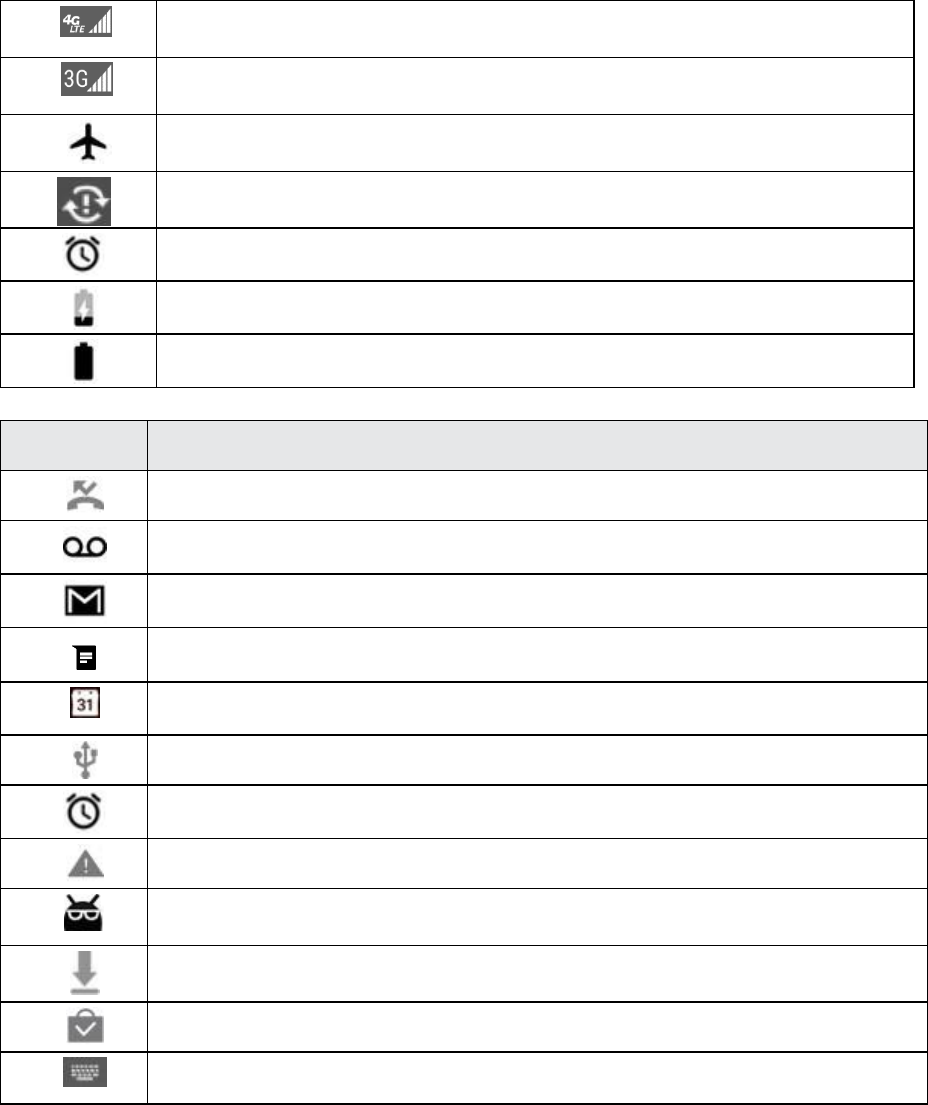
39
4G LTE data service
3G data service
Airplane mode
Sync active
Alarm set
Battery (charging)
Battery (full charge)
Main notification icons
Icon
Notification
Missed call
New voicemail
New Gmail
New text or MMS message
Event
USB connection
Alarm
Warning
Update available
Update downloading
Update successful
Keyboard active
Note: Additional notification icons may appear. All notifications may be accessed through the
notification panel.

40
Notification panel
Your phone’s notifications appear at the left side of the status bar, and you can access the full
notification panel by dragging down the status bar. From there, you can check notifications,
download updates, open messaging apps, use the quick settings menu, and more.
Open the notification panel
• Drag the status bar down.
The Notification Panel opens. To check notifications, tap an item in the list.
Close the notification panel
• Swipe up to close the Notification Panel.
• Or you can also tap Back button to close it.
Notification panel layout
The notification panel gives you access to both notifications and the Quick Settings menu.
To access the Quick Settings menu:
1. Drag the Status bar down to display Notification Panel.
2. Drag the Status bar down again to access full Quick Settings menu.

41
Customize the home screen
Learn how to set the wallpaper and add, move, or remove shortcuts, widgets, and folders from
the home screen.
Operations for rearranging the home screen
• Moving widgets and icons:
From home, touch and hold an item and then drag it to the desired location.
• Deleting widgets and icons:
From home, touch and hold an item and then drag it up to Remove.
• Displaying the home screen menu:
From home, touch and hold an empty space to display the home screen menu. It includes
Wallpapers, Widgets, and Home settings
Change the wallpaper
Select and assign your phone’s background wallpaper.
1. From home, touch and hold an empty space, and tap Wallpapers.

42
• You can also access the wallpaper menu through settings. From home, swipe up to access
Apps, and tap Settings > Display > Wallpaper.
2. Tap a location to select the wallpaper from.
3. Select a picture and tap Set wallpaper.
4. You can set this picture as the wallpaper of Home screen, Lock screen, or both Home
screen and Lock screen.
Add shortcuts to the home screen
You can add shortcuts for quick access to favorite apps from the home screen.
1. From home, swipe up to access Apps.
2. Touch and hold an app icon and drag it to move. The icon will disengage and you will see
thumbnails of your home screens.
3. Drag the icon to an empty location on one of the home screens. The shortcut is added to
the home screen.
Add widgets to the home screen
You can add widgets to your phone’s home screen. Widgets are self-contained apps that
display on a home screen. Unlike a shortcut, the Widget works like as an onscreen application.
There are all kinds of widgets, including links to a specific contact, Internet bookmarks,
Calendar, Gmail and email accounts, and many others.
1. From home, touch and hold an empty space, and then tap Widgets.
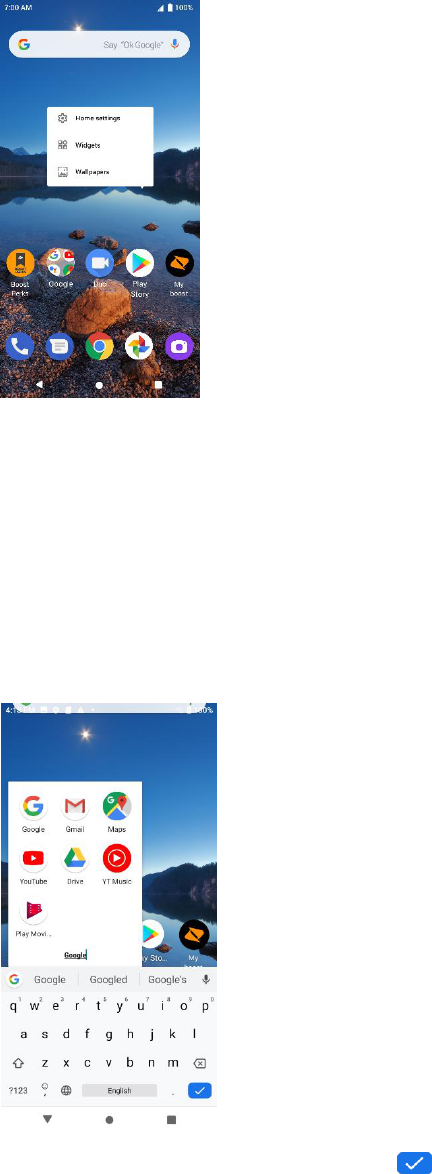
43
2. Touch and hold a widget icon. The icon will disengage and you will see thumbnails of your
home screens.
3. Drag the icon to an empty location on one of the home screens. The widget is added to the
home screen.
Add folders to the home screen
You can group Home screen shortcuts into folders for convenient access.
1. Drag a shortcut and release it over another shortcut on the Home screen to create a folder.
2. Type a name for the folder, and then tap .
3. To add more app shortcuts to the folder, touch and hold a shortcut and drag it on top of the
new folder.

44
Change folder names
Once you have added folders, you can change the name easily from the folder display.
1. From home, tap the folder to open it, and then tap the folder name.
2. Type a new name and then tap .

45
Making connections
The topics in this section will cover your phone’s ability to help you make connections, from
phone calls and maintaining contacts, to text messages, email, Internet, and international
services.

46
Phone calls and voicemail
The following topics outline the use of your device’s phone app to place and receive calls, use
voicemail, and more.
Place and answer calls
The following topics describe how to directly dial calls, how to answer incoming calls, and how
to use the in-call screen options.
Adjust In-Call volume
Press the Volume key up or down during the call.
Emergency call cautions
Emergency calls are restricted in Airplane mode.
Call using the phone dialer
The most “traditional” way to place a call is by using the phone’s dialer screen.
1. From home, tap Phone .
2. To dial a new number, tap Keypad to display the dialer screen.
3. Enter the numbers on the keypad.
As you enter digits, Smart Dial searches for contacts that match. If you see the number
you want to dial, tap it to place the call immediately without entering the rest of the number.
4. Tap to call the number.

47
The call begins when the other party answers.
5. To end the call, tap .
Call emergency numbers
You can place calls to 9-1-1 even if the phone’s screen is locked or your account is restricted.
To call the 9-1-1 emergency number when the phone’s screen is locked with a screen lock:
1. From the lock screen, tap Emergency call.
2. Tap > .
As long as you are in an area covered by wireless service, the emergency call is placed.
To call the 9-1-1 emergency number normally or when your account is restricted:
1. Unlock the screen. For more information, see Lock and unlock your screen.
2. From home, tap Phone > Keypad .
3. Tap > .
As long as you are in an area covered by wireless service, the emergency call is placed.
Enhanced 9-1-1 (E 9-1-1) information
This phone features an embedded Global Positioning System (GPS) chip necessary for utilizing
E 9-1-1 emergency location services where available.
When you place an emergency 9-1-1 call, the GPS feature of your phone seeks information to
calculate your approximate location. Depending on several variables, including availability and
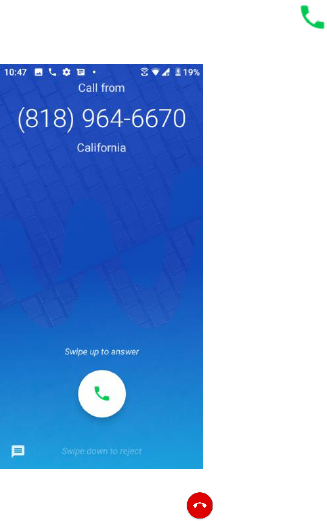
48
access to satellite signals, it may take up to 30 seconds or more to determine and report your
approximate location.
Important: Always report your location to the 9-1-1 operator when placing an emergency call.
Some designated emergency call takers, known as Public Safety Answering Points (PSAPs),
may not be equipped to receive GPS location information from your phone.
Answer phone calls
The following information lets you know how to answer incoming calls, mute the ringer on
incoming calls, reject incoming calls, and more.
When you receive a phone call from a contact, the Incoming call screen appears and displays
the caller ID icon, name, and phone number of the calling party. When you receive a phone call
from someone who is not stored in People, only the default caller ID icon and phone number
appear on the Incoming call screen.
Note: If your phone is turned off, all calls automatically go to voicemail.
Answer an incoming call
1. When a call arrives, swipe the up to answer it.
2. To end the call, tap .

49
Mute the ringing sound
To mute the ringer without rejecting the call, you can do either of the following:
1. Press the Volume down key.
2. Place the phone face down on a level surface.
Reject an incoming call
1. When a call arrives, swipe the down to reject it.
2. The ringtone or vibration will stop and the call will be sent directly to voicemail.
Reject a call and send a text message
You can reject an incoming call and automatically send a text message to the caller.

50
1. When a call arrives, tap from the bottom left corner of the screen.
The ringtone or vibration will stop and you will see a list of preset text messages.
2. Tap one of the messages to send it to the caller.
You can edit the reject messages through the call settings menu. From the phone app, tap
Menu > Settings > Quick responses and edit or create the reject messages.
In-call screen layout and operations
While you’re on a call, you will see a number of on screen options.
In-call screen layout
Tap options to activate them during a call.
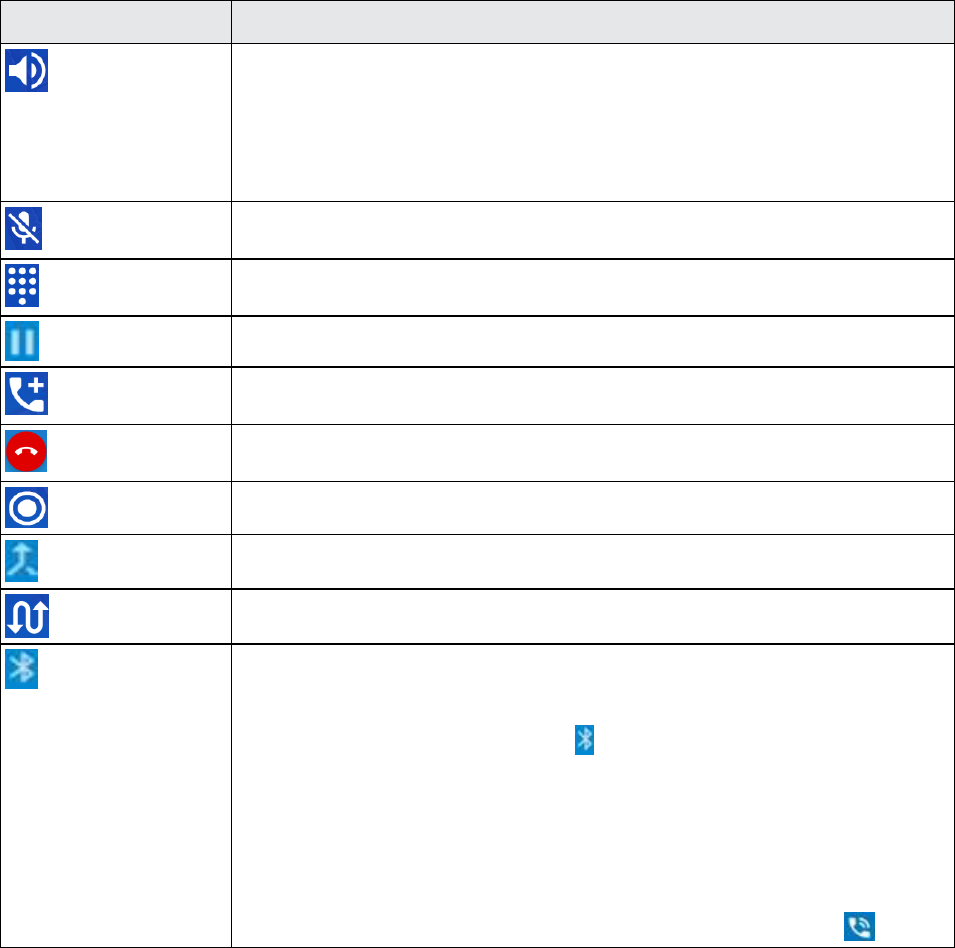
51
Item
Description
Speaker
Route the phone’s audio through the speaker (On) or through the
earpiece (Off).
Activate Speaker to route the phone’s audio through the speaker.
Deactivate Speaker to use the phone’s earpiece.
Warning: Because of higher volume levels, do not place the phone near
your ear during speakerphone use.
Mute
Mute the microphone during an active call. Tap again to unmute the
microphone.
Keypad/Hide
Toggle the appearance of the onscreen keypad. Show the keypad to
enter additional numbers, for example, an extension or access code.
On hold
Tap to hold the current call.
Add call
Tap to initiate a conference call (3-way call)
End call
End the current call.
Start recording
Record the current call.
Merge
Join two currently active calls (conference).
Swap
Swap the calls.
Bluetooth
Route the phone’s audio through a connected Bluetooth headset (On) or
through the speaker (Off).
When the call is routed to a Bluetooth headset, the current call area
shows the Bluetooth call icon ( ).
Note: The Headset button is activated to show the current call is routed
to the connected Bluetooth headset.
To route the current call back to the phone, tap Headset to
temporarily use the phone. Tap it again to route the call back to the
connected Bluetooth headset.
When Bluetooth or the Bluetooth headset is turned off, the call is
routed through either the earpiece or speaker and shows ( ).

52
Place a call from Contacts
You can place phone calls directly from entries in your Contacts list.
1. From home, tap Phone .
2. Tap Contacts to display the Contacts list.
3. Tap a contact.
4. Tap Call next to the number you want to call. The call begins when the other party
answers.
5. To end the call, tap .
Call from recents
The recents list lets you quickly place calls to recent incoming, outgoing, or missed numbers.
1. From home, tap Phone .
2. Tap Recents to display the call log list.

53
3. Tap Call to the right side of the entry you want to call.
You can tap a contact in call history to display more options.
• Send a message: to send a message to the contact/number.
• Block number: to block this contact/number.
• Call details: to view detailed call information.
The call begins when the other party answers.
4. To end the call, tap .

54
Voicemail
The following topics describe how to set up and use your phone's voicemail and visual
voicemail features.
Voicemail setup
Follow the instructions below to set up voicemail on your phone. You should set up your
voicemail and personal greeting as soon as your phone is activated. Always use a passcode to
protect against unauthorized access. Your phone automatically transfers all unanswered calls to
your voicemail, even if your phone is in use or turned off.
1. From home, tap Phone > Keypad .
2. Touch and hold to dial your voicemail number.
3. Follow the system prompts to:
• Create your passcode.
• Record your name announcement.
• Record your greeting.
Important: Voicemail passcode – It is strongly recommended that you create a passcode
when setting up your voicemail to protect against unauthorized access. Without a passcode,
anyone who has access to your phone is able to access your voicemail messages.

55
Optional calling services
The following topics outline additional voice-related services available with your phone,
including call services and more.
Caller ID blocking
Caller ID identifies a caller before you answer the phone by displaying the number of the
incoming call. If you do not want your number displayed when you make a call, follow these
steps.
1. From home, tap Phone > .
2. Tap .
3. Enter a phone number.
4. Tap .
Your caller information will not appear on the recipient’s phone.
To permanently block your number, call Wiko Customer Service.
Call waiting
When you’re on a call, Call Waiting alerts you to incoming calls by sounding two beeps. Your
phone’s screen informs you that another call is coming in and displays the caller’s phone
number (if it is available).
To respond to an incoming call while you’re on a call:
• Swipe the up. (This puts the first caller on hold and answers the second call.)
To switch back to the first caller:
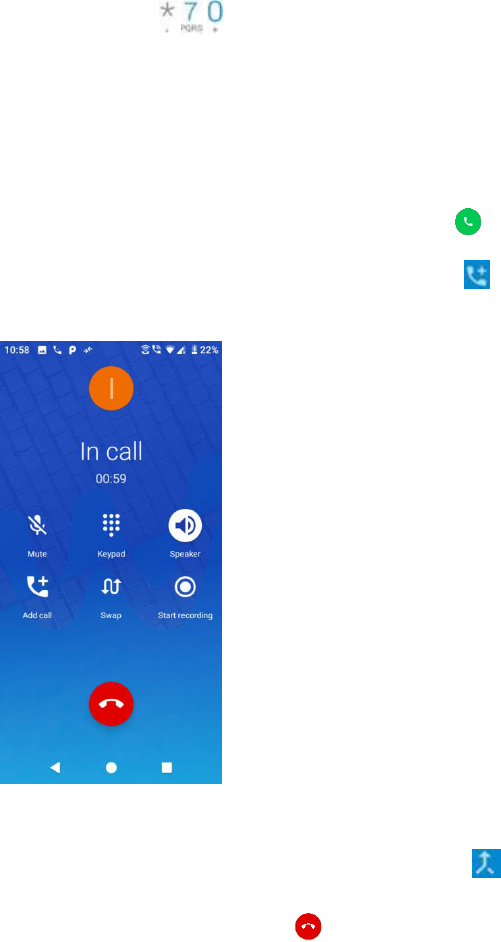
56
• Tap On hold.
Note: For those calls that you don’t want to be interrupted, you can temporarily disable Call
waiting by pressing before placing your call. Call waiting is automatically reactivated
once you end the call.
Conference calling
With conference calling, also known as 3-way calling, you can talk to two people at the same
time. When using this feature, the normal airtime rates will be charged for each of the two calls.
1. On the Phone screen, enter a number and tap (or place a call from Log or Contacts).
2. Once you have established the connection, tap , and dial the second number (or place
the call from Log or Contacts).
This puts the first caller on hold and dials the second number.
3. When you’re connected to the second party, tap . Your conference call is now in session.
4. To end the three-way call, tap .
Note: If one of the people you called hangs up during your call, you and the remaining caller
stay connected. If you initiated the call and are the first to hang up, all callers are disconnected.
Call forwarding
Call Forwarding lets you forward all your incoming calls to another phone number – even when
your phone is turned off. You can continue to make calls from your phone when you have
activated Call Forwarding.
Note: You are charged a higher rate for calls you have forwarded.
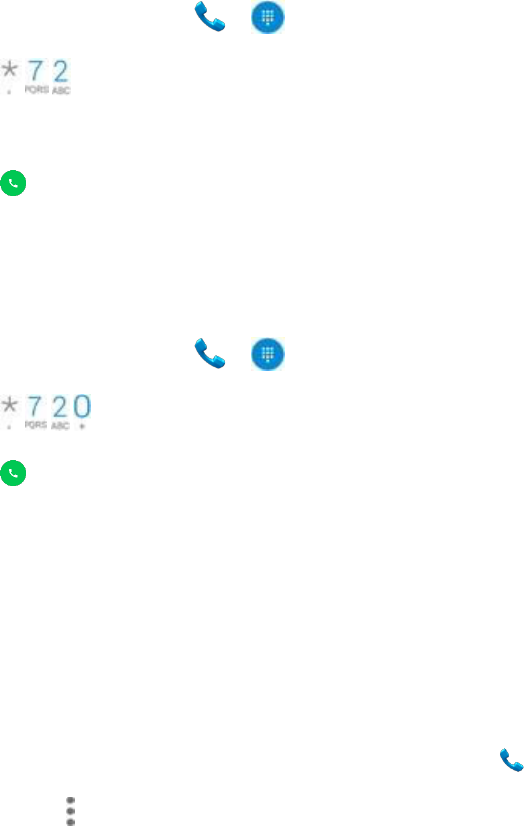
57
To activate Call Forwarding:
1. From home, tap Phone > .
2. Tap .
3. Enter the area code and phone number to which you want your calls forwarded.
4. Tap .
You will hear a tone to confirm the activation of Call Forwarding. All calls to your wireless
number will be forwarded to the designated phone number.
To deactivate Call Forwarding:
1. From home, tap Phone > .
2. Tap .
3. Tap .
You will hear a tone to confirm the deactivation.
Call settings
Your phone’s settings menu lets you configure your voicemail options and a number of other
settings for the phone application.
Call settings options
1. From home, swipe up to access Apps, and tap Phone .
2. Tap Menu > Settings.
3. Configure your options.
• Tap a menu item to display its options.
• Select your options and follow the prompts to set them.
Use the Settings menu to adjust the following settings:
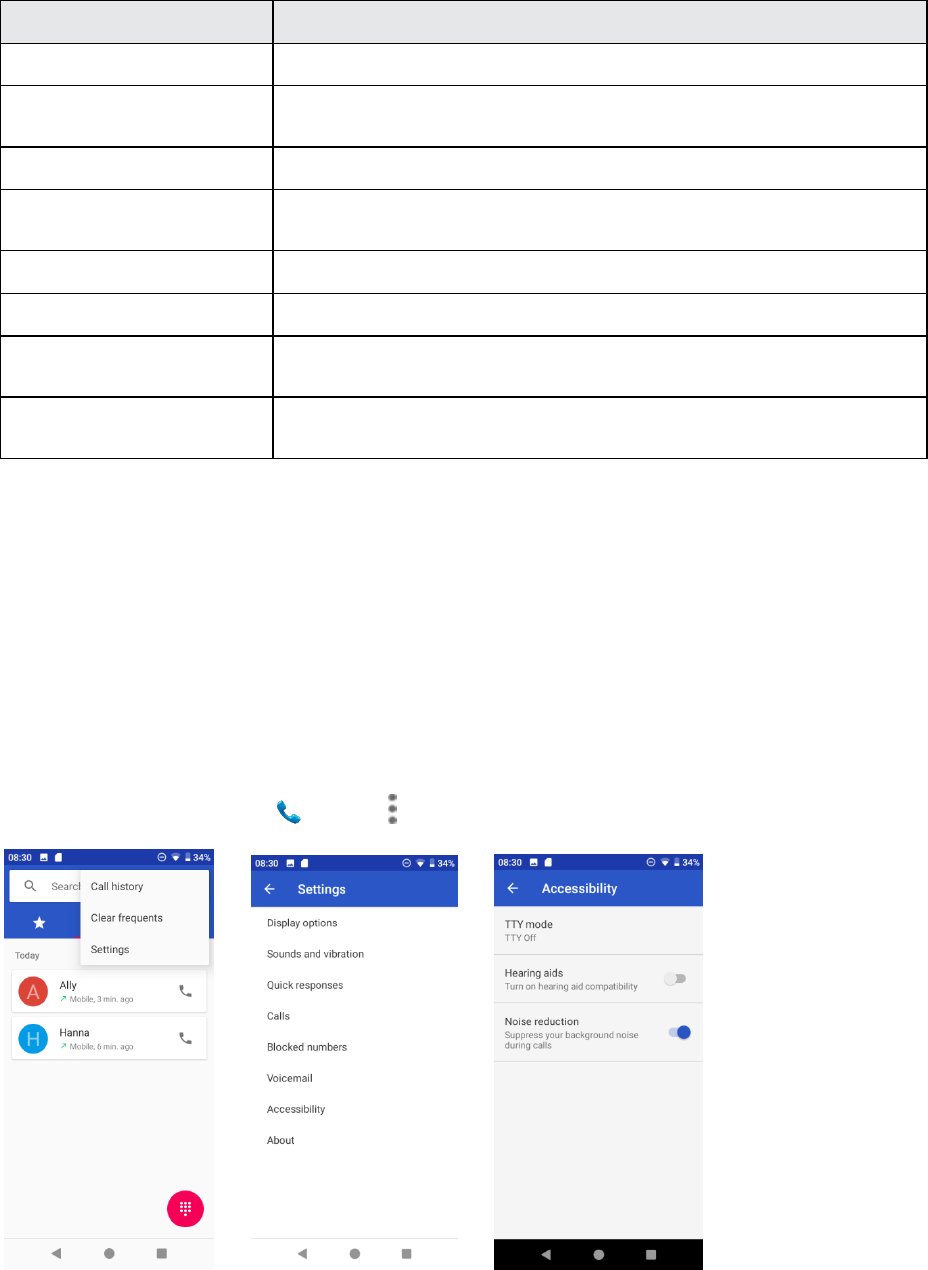
58
Setting
Description
Display options
Tap to set all display name and order.
Sounds and vibration
Tap to set all ringtone, enable or disable vibration and keypad
tones.
Quick response
Tap to view messages for quick response.
Calls
Tap to set call forwarding and call waiting, enable or disable
enhanced privacy mode.
Blocked numbers
Tap to add blocking numbers.
Voicemail
Tap to set up voicemail.
Accessibility
Tap to set TTY mode, enable or disable Hearing aids and Noise
reduction mode.
About
Tap to know more about the build version, licenses, privacy policy,
and terms of service.
TTY mode
A TTY (teletypewriter, also known as a TDD or Text Telephone) is a telecommunications device
that allows people who are deaf, hard of hearing, or who have speech or language disabilities,
to communicate by telephone.
Your phone is compatible with select TTY devices. Please check with the manufacturer of your
TTY device to ensure that it supports digital wireless transmission. Your phone and TTY device
will connect using a special cable that plugs into your phone’s headset jack. If this cable was
not provided with your TTY device, contact your TTY device manufacturer to purchase the
connector cable.
To turn TTY Mode on or off:
1. From home, tap Phone > Menu > Settings > Accessibility > TTY mode.
59
2. Tap TTY Full, TTY HCO, or TTY VCO to turn TTY mode on.
Tap TTY Off to turn TTY mode off.
Note: When enabled, TTY mode may impair the audio quality of non-TTY devices connected to
the headset jack.
Warning: 9-1-1 emergency calling
It is recommended that TTY users make emergency calls by other means, including
Telecommunications Relay Services (TRS), analog cellular, and landline communications.
Wireless TTY calls to 9-1-1 may be corrupted when received by public safety answering points
(PSAPs), rendering some communications unintelligible. The problem encountered appears
related to TTY equipment or software used by PSAPs. This matter has been brought to the
attention of the FCC, and the wireless industry and the PSAP community are currently working
to resolve this.

60
Contacts
The Contacts application lets you store and manage contacts from a variety of sources,
including contacts you enter and save directly in your phone as well as contacts synchronized
with your Google Account, your PC, compatible email programs (including Exchange Server),
and your Facebook friends.
Contacts cautions
Information saved in Contacts may be lost or changed if the battery is removed for a long
period or left uncharged. Accident or malfunction may also cause loss or change to
information. It is recommended that you keep a separate copy of contacts and other
important information. Wiko is not responsible for any damages from lost or changed
contacts.
Add a contact
You can add contacts from your phone’s Phone application. Enter details such as name, phone
numbers, email addresses, mailing addresses, and more.
1. From home, swipe up to access Apps, and tap Contacts .
2. Tap to add a contact.
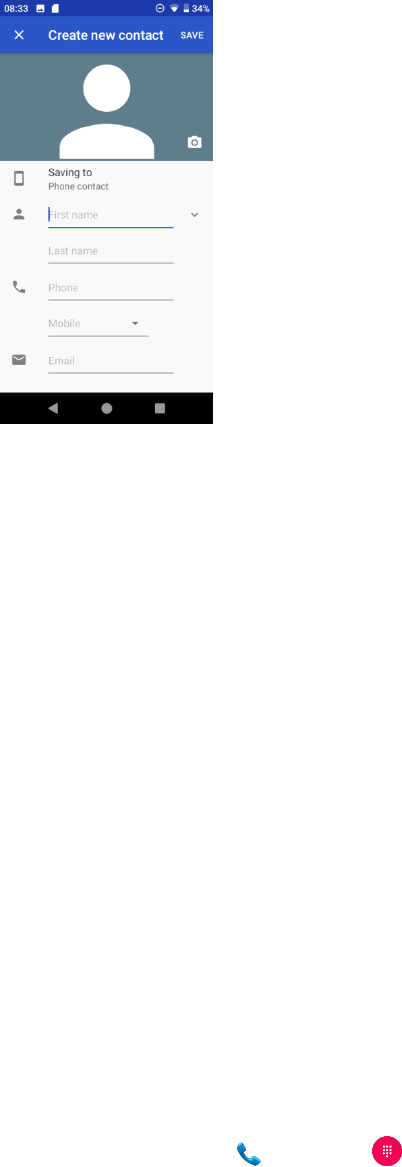
61
3. If you have multiple account types associated with your phone, select a contact type.
• Select Google if you want to save contacts to your Google Account; these will be
synced automatically with your Google Account online.
• Select Phone contact as the sync account if you want your contacts on your phone
only; they will not be synced with your Google Account.
4. Use the keyboard to enter as much information as you want.
• Photo: Tap the photo icon to assign a picture to the contact.
• Name
• Phone
• Email
• Add another field: Tap More fields to include additional information such as Address,
IM, Notes, Nickname, Website, etc.
Note: To select a type (label) for a phone number, email address, or postal address (such as
Mobile, Home, Work, etc.), tap the type to the left of the field and select the appropriate type.
5. When you have finished adding information, tap SAVE.
Save a phone number
You can save a phone number to Contacts directly from the phone keypad.
1. From home, tap Phone > Keypad .
2. Enter a phone number and tap Create new contact to add a new contact or tap Add to a
contact to add the number to an existing contact.
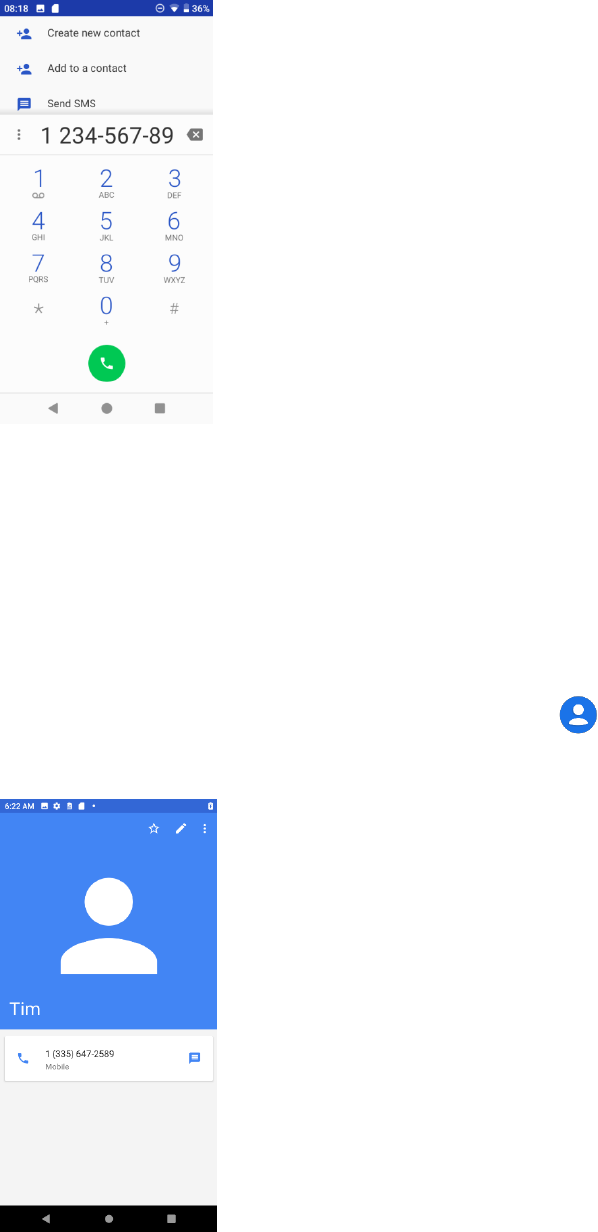
62
3. To add the number to an existing contact, tap the target contact you want to update, and
select a number type for the new number. To add a new contact, enter the name and any
additional information.
4. Tap SAVE.
View contacts
View a contact’s details by displaying a contact entry.
1. From home, swipe up to access Apps, and tap Contacts .
2. Tap a contact to view its details.

63
Contacts screen layout
The following illustration show’s your Contacts app layout and describes the various features.
Item
Description
Favorites
Show favorite contacts.
Contact
Tap to show contact’s details.
Contact image
Tap to show thumbnail of contact entry. Tap an icon to place a call, send
a message, etc.
Search
Search contacts.
Index
Browse contacts by letter.
Add new
Add a new contact.
Edit a contact
Once you’ve added a contact, you can add or edit any of the information in the entry, assign a
caller ID picture, customize with a unique ringtone, and more.
1. From home, swipe up to access Apps, and tap Contacts .
2. Tap a contact to view its details
Search
Favorites
Index
Contact image
Contact name
Add new
Menu

64
3. Tap Edit .
4. Tap any field you want to change or add.
5. Add or edit the information, and then tap SAVE.
Note: To select a type (label) for a phone number, email address, or postal address (such as
Mobile, Home, Work, etc.), tap the type to the left of the field.
Delete a contact
You can delete a contact from the contacts details page.
1. From home, swipe up to access Apps, and tap Contacts .
2. Tap a contact to view its details.
3. Tap Menu > Delete.

65
4. Tap DELETE.
Share a contact
You can quickly share contacts using Bluetooth, Gmail, or text messaging.
1. From home, swipe up to access Apps, and tap Contacts .
2. Tap a contact and tap Menu > Share.
3. Select a method to share.

66
• Messages to send the information via messages. You can select an existing message
conversation or create a new message to send it. For more information about sending
messages, see Send a multimedia message (MMS).
• Bluetooth to send the information via Bluetooth. See Bluetooth for information on
pairing and sending via Bluetooth.
• Gmail to send the information as a Gmail attachment. Address the message, add a
subject and a message, and then tap Send. See Create and send a Gmail message for
details.
• Save to Drive
4. Complete the required steps as prompted for the selected method.
Import contacts
Your phone offers a couple of options for importing contacts from installed SD cards or external
devices via USB.
Before importing contacts from an SD card
You will need to have installed an SD card with previously backed up contacts information into
your phone before you can import contacts. See SD card for SD card information.
Import contacts from an SD card or USB storage
1. From home, swipe up to access Apps, and tap Contacts .
2. Tap Menu > Settings > Import.
3. Select copy contacts from Internal shared storage or SD card, and tap NEXT.
4. Select a destination for the imported contacts.
5. Follow the onscreen instructions to complete the import.
Back up contacts
If you are saving contacts to an account that does not automatically back them up via the
Cloud, you can manually back them up to an optional installed SD card for re-import if needed.
Before backing up contacts to an SD card
You will need to have installed an SD card with previously backed up contacts information into
your phone before you can back up your contacts.
Back up contacts to your SD card
1. From home, swipe up to access Apps, and tap Contacts .

67
2. Tap Menu > Settings > Export.
3. Tap Export to .vcf file, all contacts will be saved in format of .vcf at Files > Downloads.
4. Tap Share all contacts to export contacts and go to Notification panel to share contacts via
Messages, Bluetooth, Gmail, etc.

68
Messages
With wireless service and your phone’s messaging capabilities, you have the opportunity to
share information through many different channels and accounts, including Gmail (Google),
personal and corporate email, and text and multimedia messaging.
Text and multimedia messages
With text messaging (SMS), you can send and receive instant text messages between your
wireless phone and another messaging-ready phone.
Multimedia messages, or MMS, can contain text and pictures, recorded voice, audio or video
files, picture slideshows, contact cards (vCard).
See your service plan for applicable charges for messaging.
Send a text message
Quickly compose and send text messages on your phone.
1. From home, swipe up to access Apps, and tap Messages .
2. Tap Compose .
3. Enter a contact name or mobile number in the To field.
• Enter phone numbers directly in the To field. If you’re sending the message to several
phone numbers, separate the phone numbers with a comma. As you enter information,
any matching phone numbers from your contacts list are displayed. Tap a match to enter
that number or address directly.
• Scroll the screen down to find and select the contacts to whom you want to send the
message. You can also select contact groups as recipients.
4. Tap the “Text message” box and then start composing your message.

69
Note: A counter appears above the Send to tell you how many characters you have entered
and how many characters are left. If you exceed the limit, your text message will be delivered
as one but will be charged as more than one message.
5. When done, tap Send to send the text message.
Note: Your text message automatically becomes a multimedia message if you enter an email
address as the recipient, attach an item, or compose a very long message.
Send a multimedia message (MMS)
When you need to add a little more to a text message, you can send a multimedia message
(MMS) with pictures, voice recordings, audio or video files, contact cards (vCard).
1. From home, swipe up to access Apps, and tap Messages .
2. Tap Compose . The Compose screen opens.
3. Fill in one or more recipients. You can:
• Enter phone numbers directly in the To field. If you’re sending the message to several
phone numbers, separate the phone numbers with a comma. As you enter information,
any matching phone numbers from your contacts list are displayed. Tap a match to enter
that number or address directly.
• Scroll the screen down to find and select the contacts to whom you want to send the
message. You can also select contact groups as recipients.
• Enter an email address.
4. Tap the “Text message” box, and then start composing your message.

70
5. Tap Add to the left side of the enter text bar.
6. Select one item to add.
• Emoji : Insert an emoji to the text message.
• Sticker : Choose an animated sticker to the multimedia message.
• Picture : Select Camera to take a picture to attach or select a stored picture to
attach.
• Payment : Send money or request money through Google Pay.
• Location : Share your location with your contact.
• Audio : Select Record audio to make a voice recording and attach it or select a
stored audio to attach.
• Contact :Share a contact to the contact.
• Attach file :Share attach file to the contact.
Depending on different conditions, there may be more options to select from.
7. After adding an attachment, tap it to view, and tap to delete the attachment.
8. Tap Send to send the MMS message.
Save and resume a draft message
While composing a text or multimedia message, tap Back button to automatically save your
message as a draft.
To resume composing the message:
1. From home, swipe up to access Apps, and tap Messages .
2. Tap the message to resume editing it.
3. When you finish editing the message, tap Send .
New messages notification
Depending on your notification settings, the phone will play a ringtone, vibrate, or display the
message briefly in the status bar when you receive a new text or multimedia message. To
change the notification for new text and multimedia messages, see Text and MMS Options for
details.

71
A new message icon ( ) also appears in the notifications area of the status bar to notify you of
a new text or multimedia message. The Messages application icon (if shown on the home
screen) also displays new messages .
To open the message, drag the status bar down to open the notification panel. Tap the new
message to open and read it. For information on reading and replying to messages, see
Manage message conversations.
Manage message conversations
Text and multimedia messages that are sent to and received from a contact (or a number) are
grouped into conversations or message threads in the Messaging screen. Text or MMS
conversations let you see exchanged messages (similar to a chat program) with a contact on
the screen.
Read a text message
• On the Messaging screen, tap the text message or conversation to open and read it.
• If you have a new message notification, drag the status bar down to open the notification
panel. Tap the new message to open and read it.
To return to the Messaging screen from a conversation, tap Back button .
View a multimedia message (MMS)
1. From home, swipe up to access Apps, and tap Messages .
2. Tap a multimedia message or conversation to open.
3. Tap the attachment to open it.
• If the attachment is a vCard contact, it is imported to your phone’s contacts list. For
more information, see Contacts.
• If the attachment is a vCalendar file, you can choose the calendar where you want to
save the event. For more information on using Calendar, see Calendar.
4. To save the attachment to device memory or an SD card, touch and hold the sender’s
name or number, and then tap SAVE on the options menu.
Note: When Auto-retrieve in MMS settings is disabled, only the message header is
downloaded. To download the entire message, tap the Download button on the right side of the
message. For more details, see Text and MMS options.
If you are concerned about the size of your data downloads, check the multimedia message
size before you download it.

72
Reply to a message
1. From home, swipe up to access Apps, and tap Messages .
2. Tap a conversation to open it.
3. Tap the text box at the bottom of the screen, enter your reply message, and then tap Send
.
Note: To reply to a text message with a multimedia message, open the text message, and tap
Add to add a picture, location, audio, etc. The text message is automatically converted into
a multimedia message.
Archive a message
1. From home, swipe up to access Apps, and tap Messages .
2. Tap a conversation.
3. Touch and hold the message that you want to archive.
4. Tap Archive .
Delete conversations
1. From home, swipe up to access Apps, and tap Messages .
2. Select the conversations you want to delete, touch and hold the message.
3. Tap .
4. Tap DELETE to confirm. Any locked messages will not be deleted unless you select the
Delete locked messages check box.
Tip: You can also delete a conversation while you're viewing it. While viewing a conversation,
tap Menu > , and then tap DELETE to confirm. Any locked messages in the conversation
will not be deleted unless you select the Delete locked messages checkbox.
Delete a single message
1. While viewing a conversation, touch and hold the message that you want to delete.
If the message is locked, tap > Unlock on the options menu and hold the message to
display the options menu again.
2. Tap on the options menu.
3. Tap DELETE to confirm.

73
View contact information from a message
When you have received a message from someone in your stored contacts, you can tap the
contact’s picture or icon in the conversation to open a menu of options. Depending on the
stored contact information, you can view the contact details, place a phone call or send an
email message to the contact, and more.
Text and MMS options
The messages settings menu lets you control options for your text and MMS messages
including message limits, size settings, and notifications.
1. From home, swipe up to access Apps, and tap Messages .
2. Tap Menu > Settings. You can set the following:
• Default SMS app: Tap to set the default SMS app.
• Notifications: Tap to enable or disable notification, set importance, and enable or
disable the display of notification dot on Messages app icon when new messages
received.
• Hear outgoing message sounds: Slide the switch to the On position to activate.
• Your current country: Tap to set your current country.
• Advanced:
Group messaging: Tap to send an SMS reply to all recipients and get individual replies
(mass text), or send an MMS reply to all recipients (group MMS).
Auto-download MMS: Slide the switch to the On or Off position to enable or
disable MMS downloading automatically. When enabled, the multimedia message
header plus the message body and attachments will automatically download to your
phone. If disabled, only the multimedia message header will be retrieved and shown in
your Messaging screen.
Auto-download MMS when roaming: Slide the switch to the On or Off
position to enable or disable MMS downloading automatically when roaming. When
enabled, it may incur significant phone charges.
Use simple characters: Slide the switch to the On or Off position to enable or
disable the use of simple characters.
Get SMS delivery reports: Slide the switch to the On or Off position to get or
not get SMS delivery reports.
SIM card messages: Tap to view SIM card messages.
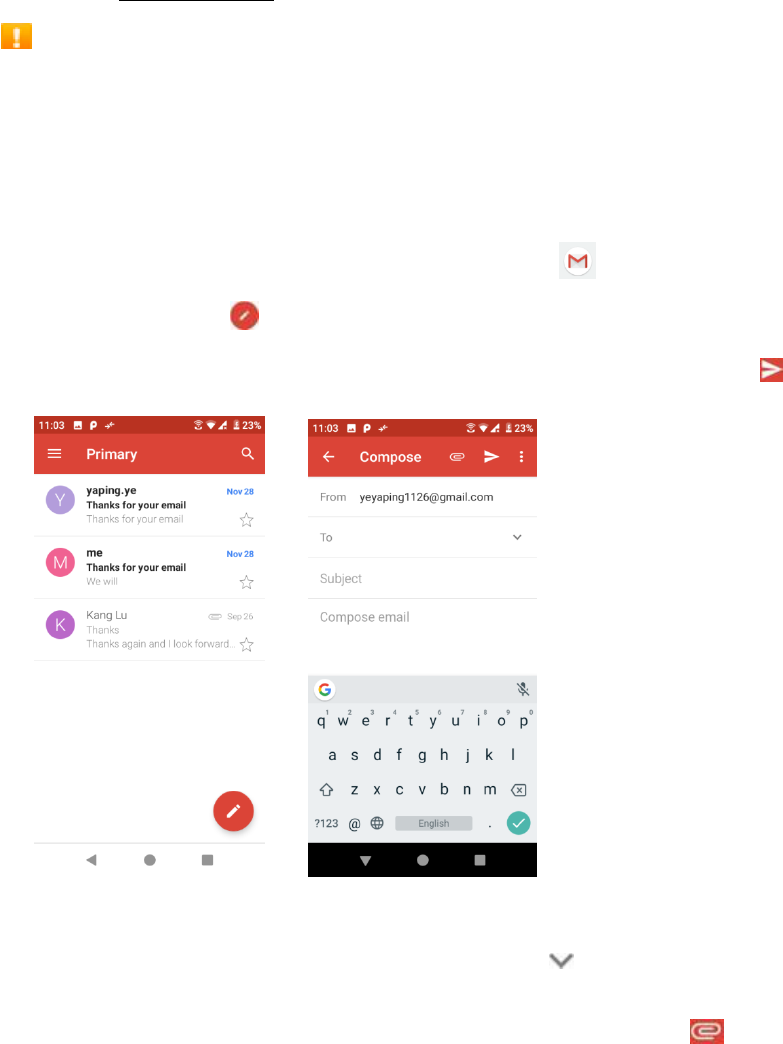
74
Phone number: View your phone number.
Gmail
Use Google’s Gmail service and your Google Account to send, receive, and manage your
Gmail messages. Before using Gmail, you must register a Google (Gmail) Account on your
phone. See Google Account for details.
Gmail cautions
Gmail is handled as email from a PC. Restricting email from PCs on your phone prevents
your phone from receiving Gmail.
Create and send a Gmail message
Use your phone to create and send Gmail messages.
1. From home, swipe up to access Apps, and tap Gmail .
2. From the inbox, tap to compose a new Gmail message.
3. Enter the message recipient(s), subject, and message, and then tap Send .
Gmail composition options
• Adding Cc/Bcc: In the mail composition window, tap near To bar, and then add
recipients.
• Attaching pictures or videos: In the mail composition window, tap > Attach file.
Locate and then tap the picture or video you want to attach.
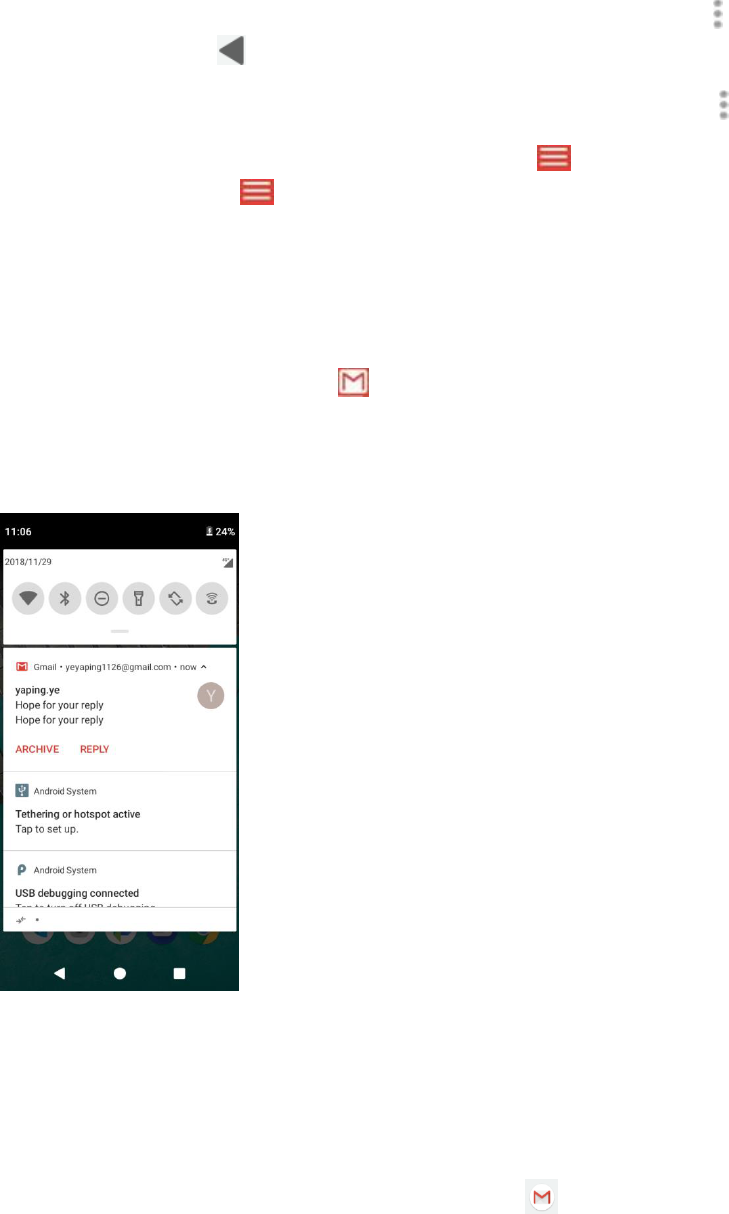
75
• Save as a draft (Send later): While composing your message, tap Menu > Save draft, or
press the Back button to save as a draft.
• Delete mail being composed: In the mail composition window, tap Menu > Discard.
Note: To view your draft email messages, in the inbox, tap > Drafts. To view your sent
messages, in the inbox, tap > Sent.
Check received Gmail messages
Your phone allows you to access, read, and reply to all your Gmail messages.
Open Gmail messages from notifications
When new Gmail arrives, you will see in the status bar.
1. Drag the status bar down to display the notification panel.
2. Tap the new message from the notification panel.
If you have two or more new Gmail messages, tapping the notification opens the Gmail
inbox.
Open Gmail messages from the inbox
You can also read and reply to all your Gmail messages from the Gmail inbox.
1. From home, swipe up to access Apps, and tap Gmail .
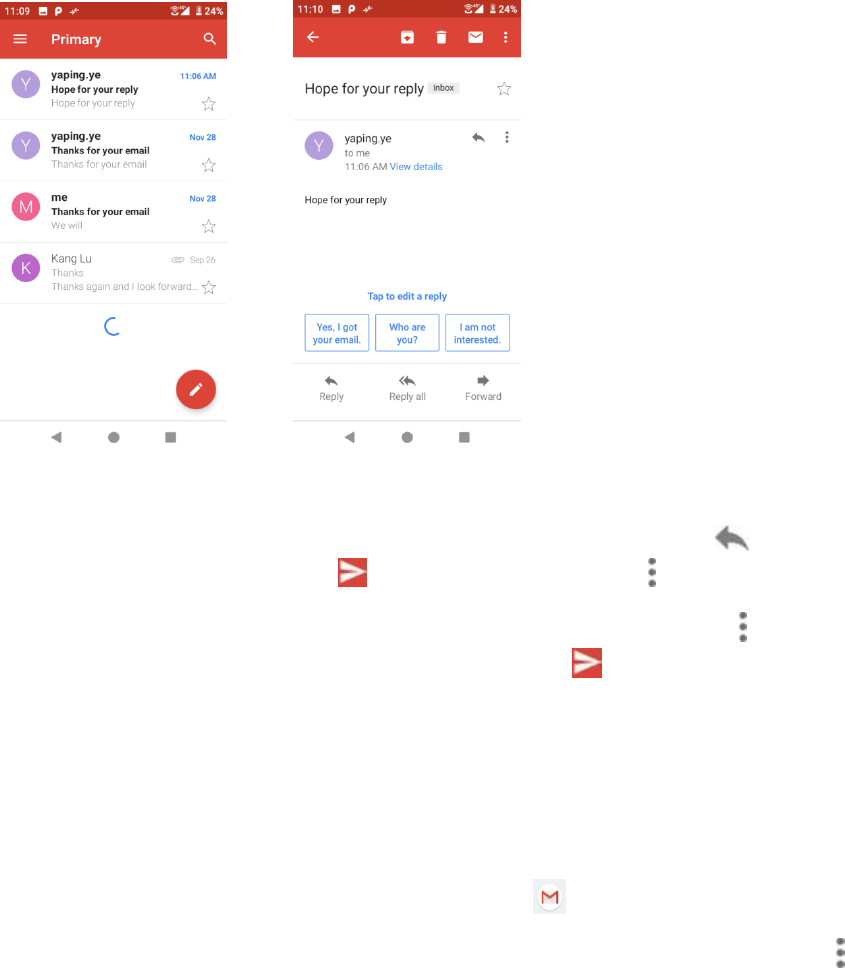
76
2. Tap the message thread you want to view.
Options when reviewing Gmail messages
• Replying to Gmail messages: With the Gmail message open, tap Reply , compose
your reply message, and tap Send . To reply to all, tap Options > Reply all.
• Forwarding Gmail messages: With the Gmail message open, tap Options > Forward,
enter a recipient and an additional message, and tap Send .
Use Gmail labels
Gmail saves all mail in one box, but you can add labels that allow you to sort your Gmail
conversation threads. For example, when a new thread starts with a received mail, the label
"Inbox" is automatically added to the thread. By then adding the label "travel," all threads with
"travel" are shown in a list.
1. From home, swipe up to access Apps, and tap Gmail .
2. Touch and hold a conversation thread to add a checkmark to it, and then tap Options >
Change labels.

77
3. Tap a label for the thread.
Archive Gmail threads
Remove sent and received Gmail threads so they do not appear in the inbox. When replies
arrive for archived threads, they appear in the inbox again.
1. From home, swipe up to access Apps, and tap Gmail .
2. Touch and hold a conversation thread to add a checkmark to it, and then tap Archive .
Mute Gmail threads
If registered on a mailing list, there will be threads with always-continuing conversations. For
long threads that are not important, mute the threads and they will no longer appear in the
inbox. When mail arrives that includes user's address as a recipient or in Cc, mail will again
appear in the inbox.
1. From home, swipe up to access Apps, and tap Gmail .
2. Touch and hold a conversation thread to add a checkmark to it, and then tap Options >
Mute. The thread is now hidden.
Delete Gmail threads
If you no longer wish to keep a Gmail conversation thread, you can simply delete it from the
inbox.
1. From home, swipe up to access Apps, and tap Gmail .

78
2. Touch and hold a conversation thread to add a checkmark to it, and then tap Delete >
OK.
Search Gmail messages
If you need to find a specific message or message thread, you can search Gmail from the
inbox.
1. From home, swipe up to access Apps, and tap Gmail .
2. Tap .
3. Enter your search text and tap .
Report spam or phishing Gmail
You can report spam or phishing Gmail messages from your phone’s Gmail inbox.
1. From home, swipe up to access Apps, and tap Gmail .
2. Touch and hold a conversation thread to add a checkmark to it, and then tap Options >
Report spam or Report phishing. The selected message is reported as spam or phishing
Gmail.
Add another Google (Gmail) Account
If you have multiple Gmail accounts you wish to view on your phone, you can add them from
the Settings > Accounts menu.
1. From home, swipe up to access Apps, and tap Settings

79
2. Tap Accounts > Add account.
3. Tap Google, and then tap Enter your email.
4. Enter your Gmail username and password, and then tap NEXT.
5. After your phone connects with the Google servers, select the items you would like to sync
with your phone and then tap Sync now.
6. Tap Finish setup.
You are signed in to your Google Account, and you can access both of your Gmail accounts
from the Gmail app.
Note: You can also sign up for a new Gmail account from the Settings menu. In step 2 above,
tap Or create a new account and follow the prompts.
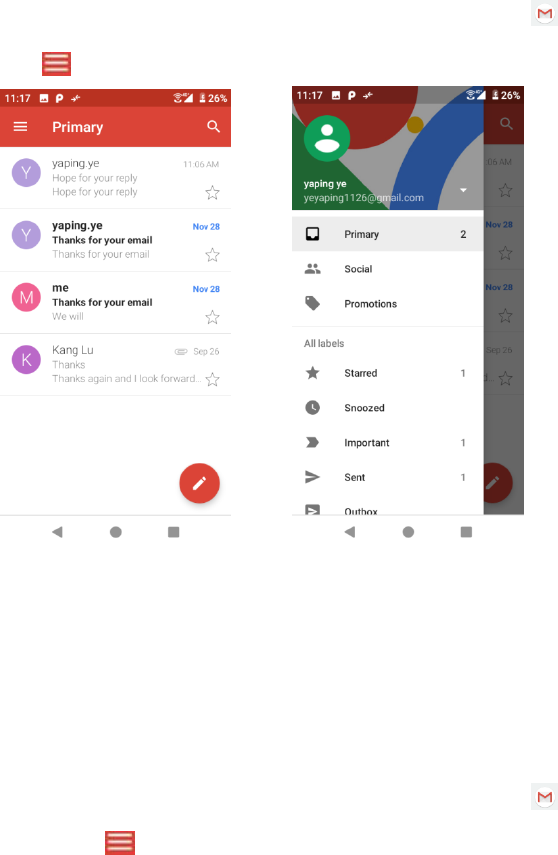
80
Switching between Gmail Accounts
If you have more than one Gmail account set up, you can switch between them in the Gmail
app.
1. From home, swipe up to access Apps, and tap Gmail .
2. Tap .
3. Tap the account you want to view from the list at the top of the menu.
The selected account inbox is displayed.
Gmail settings
You can access settings for the Gmail app and for your individual Gmail accounts from the
Gmail Settings menu.
1. From home, swipe up to access Apps, and tap Gmail .
2. Tap Menu > Settings.

81
3. Tap General settings to access settings for all accounts or tap an account name to
configure settings for a specific Gmail account.
• General settings: Gmail default action, Conversation view, Swipe actions, Sender
image, Reply all, Auto-fit messages, Auto-advance, Confirm before deleting, Confirm
before archiving, and Confirm before sending.
• Account settings: Inbox type, Inbox categories, Notifications, Inbox sound & vibrate,
Signature, Vacation responder, Sync Gmail, Days of mail to sync, Manage labels,
Download attachments, and Images.
Note: Available settings are subject to change.

82
Internet and social networking
The following topics describe how to connect to and use the Internet on your phone, and how to
access popular social networking sites such as Facebook, Twitter, Duo, and more.
Chrome browser
If you are signed in with a Google Account, the Chrome browser will import all your bookmarks
and other Web preferences for use on your phone.
1. From home, swipe up to access Apps, and tap Chrome .
2. Tap the addresses bar at the top and enter search words (for a Google search) or a Web
address (URL). The search results will appear or a Web page opens.
Viewing Web pages
When opening a website, you can navigate on Web pages by sliding your finger on the screen
in any direction to locate the information you want to view.
Pinch/Spread your finger on the screen to zoom out/in of the Web page. To quickly zoom into a
section of a Web page, double tap on the section you want to view. To return to the normal
zoom level, double tap again.
To manage a link, phone number or address displayed on a Web page
Link
Tap the link to open the Web page.
Touch and hold the link to open options for further operation, like open in
new window, save link, share link, copy link, etc.
Phone number
Tap to call the phone number.
Address
Tap to open Google Maps and locate the address.
To view Chrome browser history
1. From home, swipe up to access Apps, and tap Chrome .
2. Tap to access options menu.
3. Tap History to view Chrome browser history.
To bookmark a Web page
1. From home, swipe up to access Apps, and tap Chrome .
2. Open the Web page you want to bookmark.
3. Tap to display menu options and tap to add it to Bookmarks.

83
4. On the screen prompted at the bottom, tap EDIT to edit the bookmark name and select
folder of the bookmark to store to. Or you can access edit screen by tapping > .
To open a bookmark
1. From home, swipe up to access Apps, and tap Chrome .
2. Tap to access options menu and tap Bookmarks.
3. Tap the bookmark you want to open.
4. You can also touch and hold the bookmark to select, tap on the upper right corner of the
screen, and touch Open in new tab or Open in incognito tab.
To edit a bookmark
1. From home, swipe up to access Apps, and tap Chrome .
2. Tap to access options menu and tap Bookmarks.
3. Touch and hold the bookmark you want to edit.
4. Tap to access edit screen.
Chrome support
1. From home, swipe up to access Apps, and tap Chrome .
2. Tap Menu > Help & feedback.
Tip: For more information, visit: google.com/intl/en/chrome/browser/mobile/.
Facebook
Post updates, read what your friends are up to, upload pictures and check-ins, and more with
on-the-go Facebook access.
Sign in to your Facebook account or create a new account
1. From home, swipe up to access Apps, and tap Facebook .
2. Enter your mobile number or email and password and tap Log In, or tap Create New
Account to join Facebook by following a few easy steps.
3. Once completed, your Facebook account is added to your phone.

84
Use Facebook
Once you’ve either created an account or signed in, you can post and read updates, upload
pictures, tag locations, and more, all from your phone.
1. From home, swipe up to access Apps, and tap Facebook .
2. Tap Status and type an update, tap Photo and upload a picture from the gallery, tap Check
In to share your location, “Like” and comment on friends’ posts, and more.
Twitter
Tweet (post messages) and view other people's tweets on Twitter. Login may be required to
use Twitter. For more details about Twitter, visit twitter.com.
Install the Twitter app on your phone
Before you can use Twitter on your phone, you have to download and install the app from
Google Play.
1. From home, swipe up to access Apps, and tap Play Store .
2. Tap Search icon and search for "twitter".
3. Tap Twitter from the results list.
4. Tap Install, and then tap Accept. The app will be downloaded and installed on your phone.
5. When the download has completed, tap Open.
To open the app from the home screen, swipe up to access Apps, and tap Twitter .
Tweet on Twitter
Read Twitter feeds, follow your friends, and tweet your own updates right from your phone.
1. From home, swipe up to access Apps, and tap Twitter .
If this is the first time you’ve used Twitter on your phone, tap Login to sign in to an existing
account or tap Create my account or Sign up a different account to set up a new Twitter
account.
2. Tap the “What’s happening?” text box, type a tweet, and tap TWEET. The tweet is sent and
appears on your Twitter feed.

85
Connectivity
The following topics address your phone’s connectivity options, including USB file transfer, Wi-
Fi, Bluetooth, IR connectivity, and more.
Transfer files between your phone and a computer
You can use the supplied USB cable to connect your phone directly to your computer and
transfer music, pictures, and other content files.
For example, if you have a music album stored on your computer that you want to listen to on
your phone with any of the music apps, just attach your phone to the computer and copy the
files to the music folder.
File transfer tips
• If you want to save data to an SD card on your phone, make sure the SD card is installed
and active. For more information, see SD card.
• Avoid removing the battery or SD card while transferring data.
• Data exchange may use the methods outlined in the following table:
Method
Description
Media Device (MTP)
Transfer files between your phone and PC such as pictures, videos,
and music.
Camera (PTP)
Transfer picture and video files between your phone and PC.
Transfer files between the phone and a computer
1. Connect your phone to your computer using the supplied USB/charging cable.
• Insert the end of the cable to the charger/accessory jack at the bottom of the phone.
• Insert the USB end of the cable into an available USB port on your computer. You may
need to remove the USB cable from the charging head to access it.

86
2. Drag the status bar down to display the notification panel. You will see USB debugging
connected.
3. To transfer files from your phone to your computer:
• From home, swipe up to access Apps, and tap Settings .
• Tap Connected devices > USB.
• Tap Transfer files. You can also select other options available.
4. On your computer, navigate to the detected device (such as through the My Computer
menu) and open it.
5. If available, select a drive (Internal shared storage or SD card).
6. Select a folder and copy files from your computer to your phone or from your phone to your
computer.
7. When done, disconnect your phone from your computer.
Wi-Fi
Wi-Fi provides wireless Internet access over distances of up to 300 feet. To use your phone’s
Wi-Fi, you need access to a wireless access point or “hotspot.”
The availability and range of the Wi-Fi signal depends on several factors, including
infrastructure and other objects through which the signal passes.
Turn Wi-Fi on and connect to a wireless network
Use the wireless and Network setting menu to enable your phone’s Wi-Fi radio and connect to
an available Wi-Fi network.
1. From home, swipe up to access Apps, and tap Settings .

87
2. Tap Network & Internet > Wi-Fi.
3. Slide the Wi-Fi switch to the On position.
• Wi-Fi is enabled. You will see the names and security settings of in-range Wi-Fi
networks.
• To disable Wi-Fi, slide the Wi-Fi switch to the Off position.
4. Tap a Wi-Fi network to connect, enter the password (if it’s not an open network), and then
tap Connect.
Your phone is connected to the Wi-Fi network. You will see ( ) in the status bar.
• The password, for a household wireless LAN router, is sometimes found on a sticker on
the router (WEP, WPA, KEY, etc.). Contact the router manufacturer for information. For
password for a public wireless LAN, check with user's service provider.
• Entering a password is not required if an access point is not security protected.
Note: The next time your phone connects to a previously accessed secured wireless network,
you will not be prompted to enter the password again, unless you reset your phone to its
factory default settings or you instruct the phone to forget the network.
Note: Wi-Fi networks are self-discoverable, which means no additional steps are required for
your phone to connect to a Wi-Fi network. It may be necessary to provide a user name and
password for certain closed wireless networks.
Wi-Fi settings
Use the Wi-Fi settings menu to manually set your Wi-Fi connection options.
1. From home, swipe up to access Apps, and tap Settings .
2. Tap Network & Internet > Wi-Fi.
3. Slide the Wi-Fi switch to the On position.
• Wi-Fi is enabled. You will see the names and security settings of in-range Wi-Fi
networks.
• To disable Wi-Fi, slide the Wi-Fi switch to the Off position.
4. Tap Wi-Fi preferences on the bottom of the Wi-Fi screen.
5. Configure your Wi-Fi settings.
Disconnect Wi-Fi
You may wish to disconnect from a connected Wi-Fi network without turning Wi-Fi off.
1. From home, swipe up to access Apps, and tap Settings .

88
2. Tap Network & Internet > Wi-Fi.
3. Tap the name of the connected access point and then tap FORGET.
After disconnecting from an access point, you may need to re-enter the password to
reconnect.
Wi-Fi Direct
Use Wi-Fi Direct to connect directly to other Wi-Fi Direct devices simply via Wi-Fi, without an
access point or via the Internet.
1. From home, swipe up to access Apps, and tap Settings .
2. Tap Network & Internet > Wi-Fi.
3. Slide the Wi-Fi switch to the On position.
• Wi-Fi is enabled. You will see the names and security settings of in-range Wi-Fi
networks.
4. Tap Wi-Fi preference on the bottom of the Wi-Fi screen.
5. Tap Advanced > Wi-Fi Direct.
• Wi-Fi Direct and Wi-Fi are available at the same time.
6. Tap a device with which to connect.
a) If connected via Wi-Fi, you will see a confirmation. Follow the onscreen
instructions.
7. Accept the connection on the other device.
The phone is connected via Wi-Fi Direct.
a) If a connection is not accepted after a certain period, the connection request is
canceled.
b) To stop a connection, tap the connected device name, tap OK to confirm
disconnection.
Bluetooth
Bluetooth is a short-range communications technology that allows you to connect wirelessly to
a number of Bluetooth devices, such as headsets and hands-free car kits, and Bluetooth-
enabled handhelds, computers, printers, and wireless phones. The Bluetooth communication
range is usually approximately 30 feet.
Bluetooth hints
Question: Can’t use Bluetooth?

89
Answer: Is your phone in airplane mode? Bluetooth is unavailable in airplane mode.
Bluetooth function cautions
Information may not appear correctly on connected devices depending on the transferred data.
Bluetooth information
Bluetooth is a technology that enables wireless connection with PCs, Bluetooth devices with
handsfree features, etc.
Function
Description
Audio output
Wirelessly listen to music, podcasts, etc.
Hands-free calls
Call hands-free, using Bluetooth-capable hands-free devices and
headsets.
Data exchange
Exchange data with Bluetooth devices.
Enable the Bluetooth feature
Use the settings menu to enable or disable your phone’s Bluetooth capabilities.
• Wireless connection to all Bluetooth functions is not guaranteed for the phone.
• The phone may not connect properly depending on the other device.
• Noise may be experienced with wireless calls and hands-free calls depending on the
conditions.
To enable Bluetooth:
1. From home, swipe up to access Apps, and tap Settings .
2. Tap Connected devices > Connection preferences > Bluetooth.
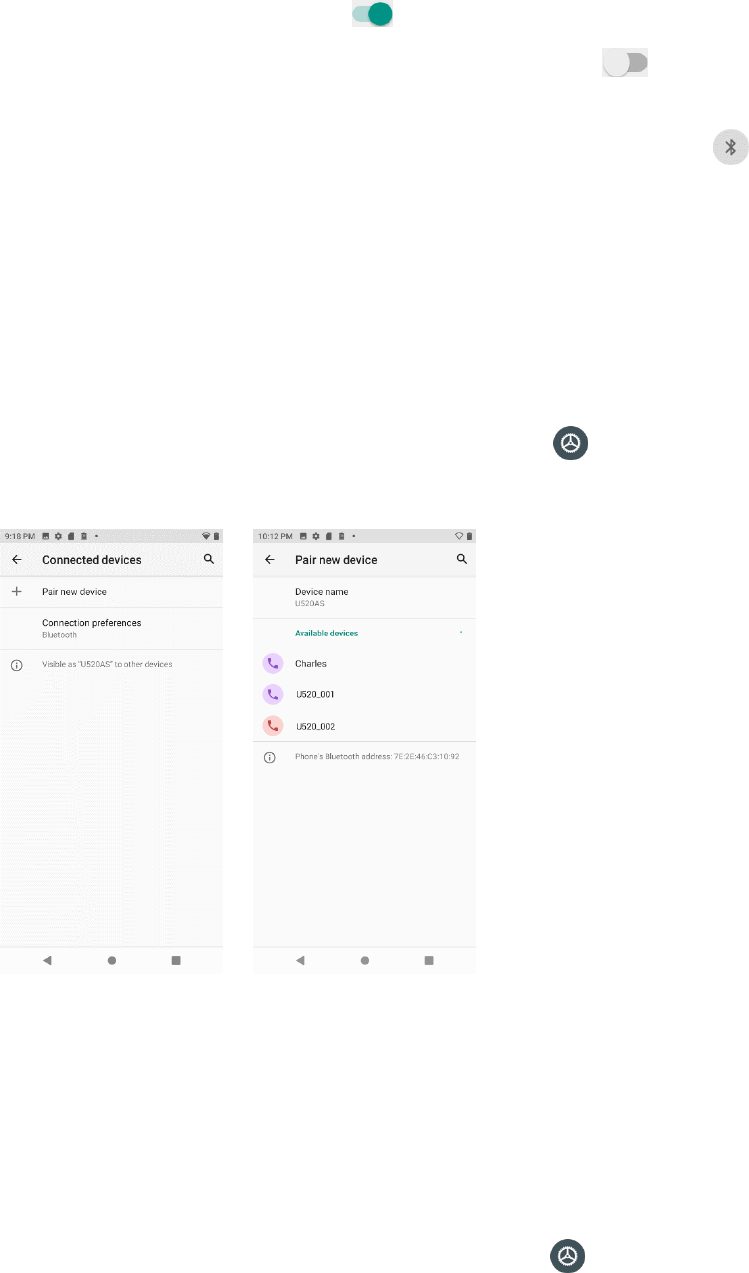
90
3. Slide the Bluetooth switch to the On position.
To disable Bluetooth, slide the Bluetooth switch to the Off position.
Tip: You can also turn Bluetooth on or off with the toggle menu in the notification panel. Drag
the status bar down to display the Notification panel and then tap Bluetooth to turn it on.
Note: Turn off Bluetooth when not in use to conserve battery power, or in places where using a
wireless phone is prohibited, such as aboard an aircraft and in hospitals.
Pair Bluetooth devices
Search for and pair nearby Bluetooth devices. Registered Bluetooth devices can be connected
simply. Enable the Bluetooth function on the Bluetooth devices being paired beforehand.
To pair Bluetooth devices
1. From home, swipe up to access Apps, and tap Settings .
2. Tap Connected devices > Pair new device.
• Nearby devices appear in the “Available devices” list.
• If a target device is not detected, tap Refresh to search again.
3. Tap a device from the “Available devices” list and follow the onscreen instructions to pair
with the device.
Methods to accept a Bluetooth connection differ depending on the devices used.
To forget from a paired device
1. From home, swipe up to access Apps, and tap Settings .
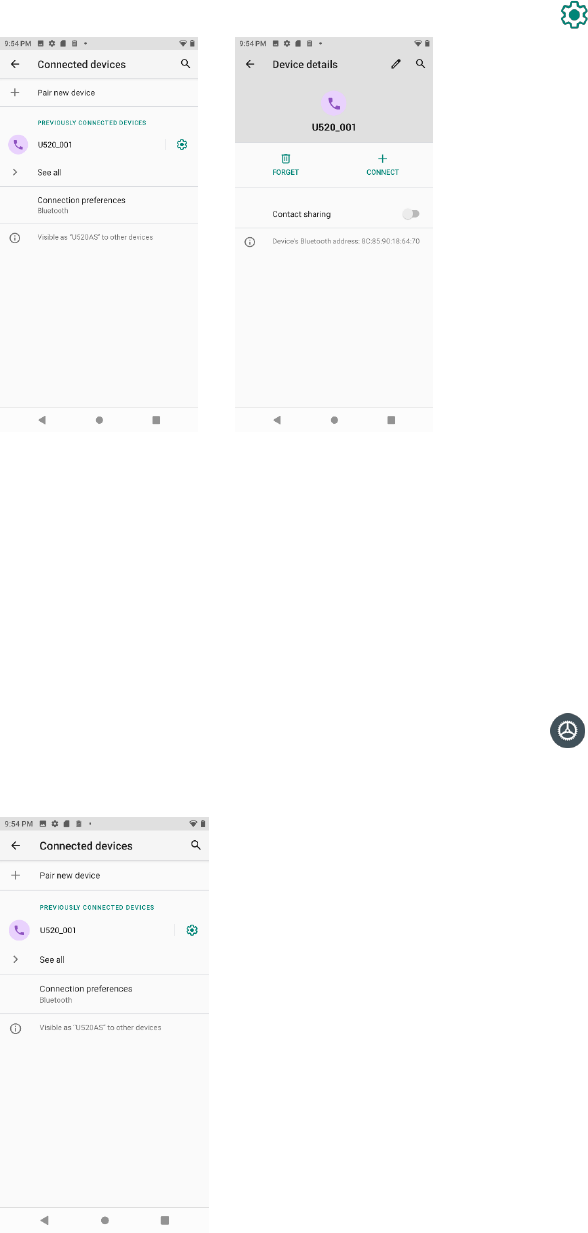
91
2. Tap Connected devices.
3. Tap the paired device you wish to forget and tap Settings next to the paired device.
4. Tap FORGET.
The device is unpaired from your phone. To make another connection with the device, you
will need to pair again.
Connect to a paired Bluetooth device
You can listen to music over a Bluetooth stereo headset, or have hands-free conversations
using a compatible Bluetooth headset or car kit. It’s the same procedure to set up stereo audio
and hands-free devices.
1. From home, swipe up to access Apps, and tap Settings .
2. Tap Connected devices.

92
3. Tap a connected device.
Your phone connects to the paired device.
The pairing and connection status is displayed below the device’s name in the Bluetooth
devices section. When the device is connected to your phone, the Bluetooth paired icon is
displayed in the status bar. Depending on the type of device you have connected, you can then
start using the headset or car kit to listen to music or make and receive phone calls.
Note: Due to different specifications and features of other Bluetooth-compatible devices,
display and operations may be different, and functions such as transfer or exchange may not
be possible with all Bluetooth-compatible devices.
Send information using Bluetooth
You can use Bluetooth to transfer information between your phone and another Bluetooth-
enabled device such as a phone or notebook computer.
Types of data you can send via Bluetooth
You can send the following types of information, depending on the device you are sending to:
• Images and videos
• Calendar events
• Contacts
• Audio files
In the instructions below, Contacts data is being used as an example.
Sending contacts data via Bluetooth
1. From home, swipe up to access Apps, and tap Contacts .
2. Tap a contact to send.
3. Tap Menu > Share > Bluetooth.

93
4. Tap a paired device to receive the data.
The contact information is sent.
Receive information via Bluetooth
Your phone is capable of receiving a wide variety of file types with Bluetooth, including pictures,
music tracks, and documents such as PDFs.
1. When another device attempts to send a file to your phone via Bluetooth, you will see a
request to accept the file.
2. Tap ACCEPT.
Your phone has received the file.
• When your phone receives a file, you will see a notification. To open the file
immediately, drag the status bar down to display the notification panel, and then tap the
notification.
• When you open a received file, what happens next depends on the file type:
o Media files and documents are usually opened directly in a compatible application.
For example, if you open a music track, it starts playing in the Music application.
o For a vCalendar file, select the calendar where you want to save the event, and then
tap Import. The vCalendar is added to your Calendar events. For more information
on using Calendar, see Calendar.
o For a vCard contact file, if there are multiple vCard files on your storage card, you
can choose to import one, several, or all of those contacts to your contacts list.

94
Apps and entertainment
The topics in this section will explore the features that make your phone so much more than a
phone, from the camera and productivity apps to music, entertainment, and more.
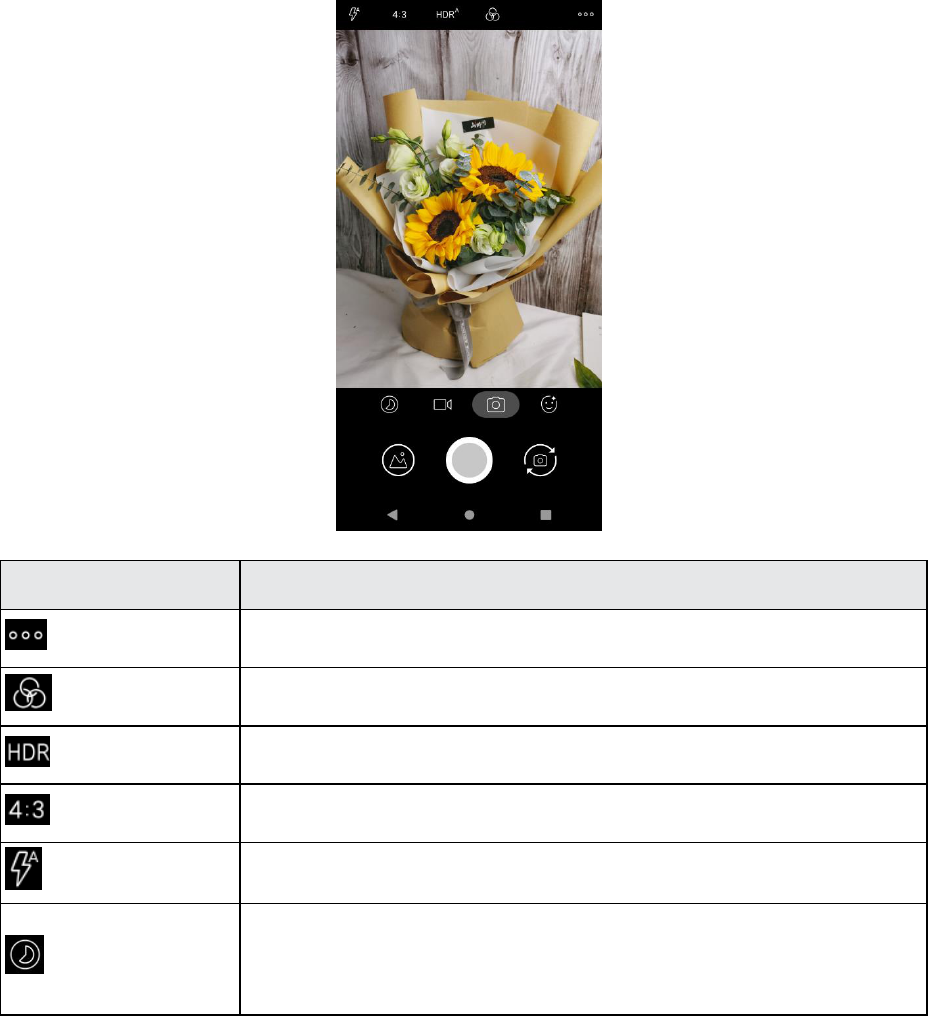
95
Camera and video
You can use the camera or video camera to take and share pictures and videos. Your phone
comes with a 8 megapixel camera that lets you capture sharp pictures and videos.
Camera overview
The camera's viewfinder screen lets you view your subject and access camera controls and
options.
Menu
Function/Service
Options menu
Tap to select camera mode and settings options.
Filter
Tap to select filter mode.
HDR boost
Tap to activate or deactivate HDR boost mode.
Picture size ratio
Tap to set the photo quality and aspect ratio.
Flash
Tap to select flash modes.
Time lapse
Tap to activate Time lapse mode to create a video. Time lapse mode
just appears in video mode and it has 5 classes: X5, X10, X60, X180,
X300.
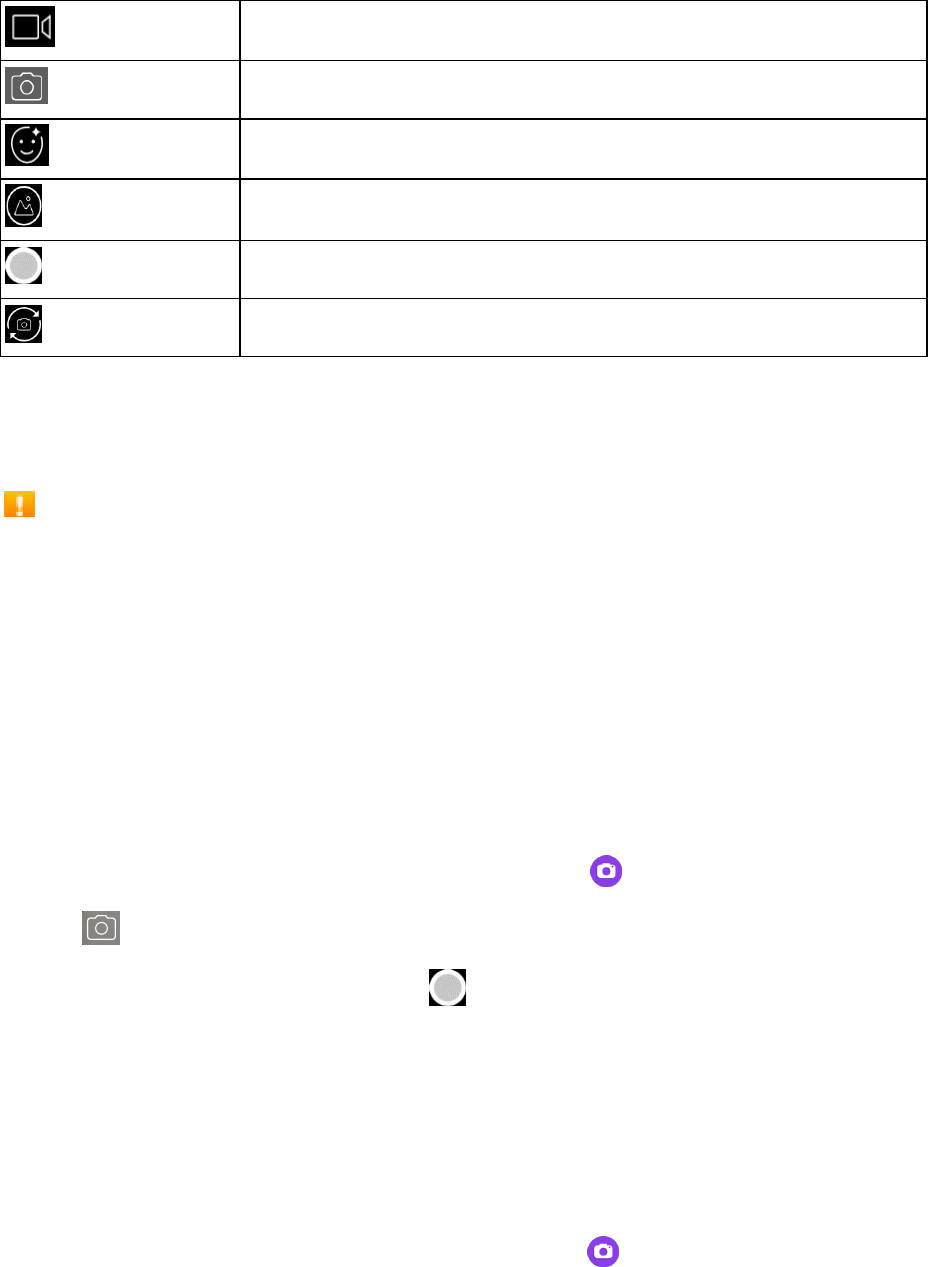
96
Video mode
Tap to access Video mode.
Photo mode
Tap to access Photo mode.
Face Beauty
Tap to access Face Beauty mode to make your photo more beautiful.
Pictures
View the last photo or video taken.
Capture
Capture a photo.
Switch
Switch between the front and main cameras.
Take pictures and record videos
The following topics teach you how to take pictures and record videos with your phone’s
camera.
Camera cautions
If Lens becomes dirty: Fingerprints/smudges on lens prevent capturing of clear still
images/videos. Wipe lens with a soft cloth beforehand.
Avoid exposure to direct sunlight: Be careful not to expose lens to direct sunlight for long
periods. May discolor color filter and affect color of images.
Take a picture
You can take pictures using your phone’s camera.
Note: If you have an SD card installed, pictures and videos are stored on the SD card. If no
card is installed, pictures and videos are saved to your phone’s memory.
1. From home, swipe up to access Apps, and tap Camera .
2. Tap to switch to Photo mode.
3. Aim the camera at your subject and tap to take the picture.
The shutter clicks and the picture is captured and saved to your phone or SD card.
Record videos
You can record high-quality videos with your phone’s video camera.
Note: If you have an SD card installed, pictures and videos are stored on the SD card. If no
card is installed, pictures and videos are saved to your phone’s memory.
1. From home, swipe up to access Apps, and tap Camera .
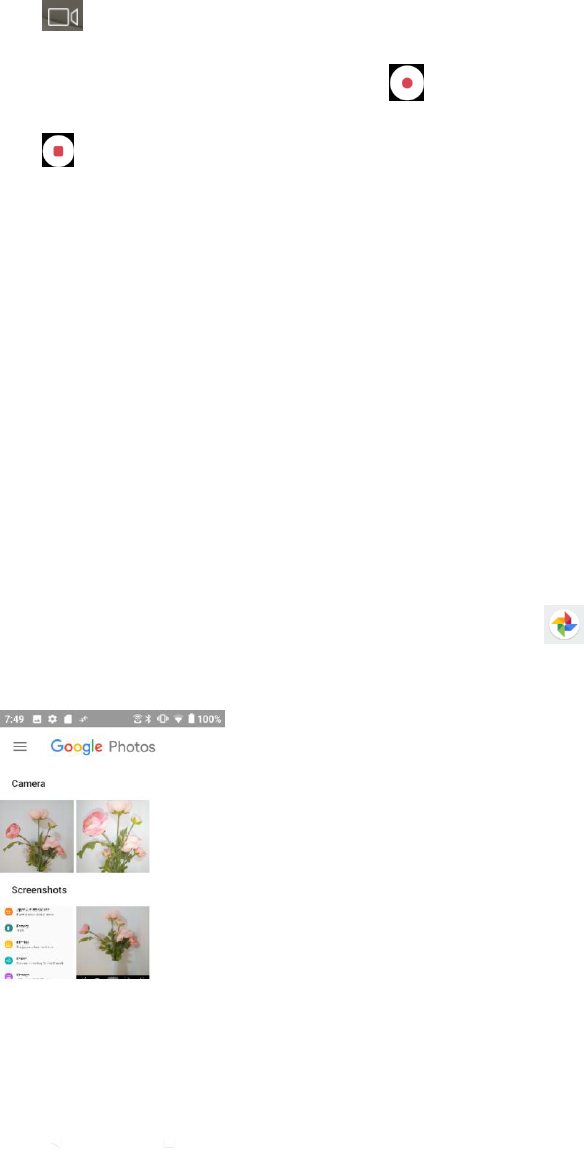
97
2. Tap to switch to Video mode.
3. Aim the camera at your subject and tap to start to record a video.
4. Tap again to stop recording.
The camera stops recording and the video is captured and saved to your phone or SD card.
View pictures and video using Photos
Using the Photos application, you can view pictures and watch videos that you’ve taken with
your phone’s camera, downloaded, or copied onto your storage card or phone memory. You
can also take a look at your pictures and your friends’ pictures that are on your social
networks.
For pictures that are on your storage card or phone memory, you can do basic editing such as
rotating and cropping. You can also easily assign a picture as your contact picture or wallpaper
and share pictures with your friends.
View pictures and videos
You can access and view all your stored pictures and videos from your phone’s Gallery.
1. From home, swipe up to access Apps, and tap Photos .
2. Tap an album.
3. Tap an image or a video to view.

98
Pictures and videos: review screen
After capturing a picture or video, from the camera screen, tap the thumbnail image at the
bottom left corner of the screen to see the item in the review screen. From there, you can
access options such as save, view, send, or delete the picture or video.
Pictures and videos: options while viewing
• Zoom in or out on a picture or video: Tap the screen twice or pinch the screen to zoom in
or out on a picture or video.
• Viewing videos: Use the onscreen controls to play, pause, or stop the video playback.
After selecting an album from the Albums tab, you can browse through the pictures and videos
of that album. Tap a picture or video to view it in full screen. By default, the pictures and videos
in an album are displayed in grid view.
Note: When viewing pictures, you can touch and hold on a picture or video to open a selection
menu and choose what to do with the picture or video.
Time Lapse mode
Time-lapse mode just appears in video mode and it has 5 classes: 5s, 10s, 60s, 180s, 300s,
which means user captures video for every second and then system extracts 5/30, 10/30,
60/30… to play.
1. From home, swipe up to access Apps, and tap Camera .
2. Tap to switch to Time Lapse mode.
3. Aim the camera at your subject and tap to start to record a video.
4. Tap again to stop recording.
Edit pictures
Whether you’re browsing pictures in filmstrip or grid view in the Gallery application, you can
touch and hold on a picture to open a selection menu and choose to delete the picture, rotate or
crop it, and more.
Rotate and save a picture
1. From home, swipe up to access Apps, and tap Photos .
2. Tap an album.
3. Tap the picture you want to rotate.
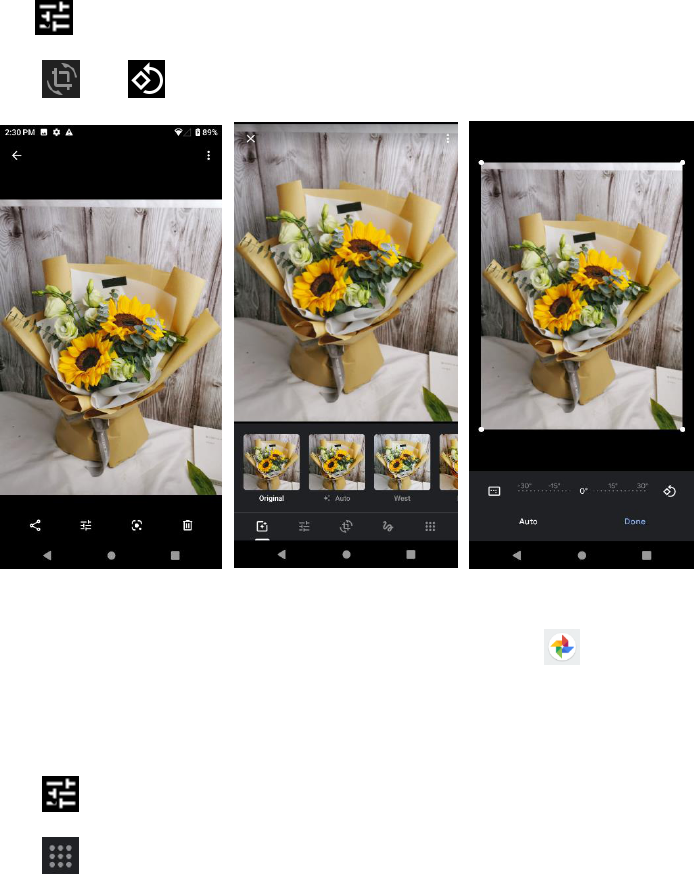
99
4. Tap to access Edit screen.
5. Tap and to rotate the picture. When done, tap DONE to save.
Crop a picture
1. From home, swipe up to access Apps, and tap Photos .
2. Tap an album.
3. Tap the picture you want to crop.
4. Tap to access Edit screen.
5. Tap . Tap Crop document, a crop box appears on the picture.
6. To adjust the crop box size, drag directional arrows inward or outward to resize the crop
box.

100
To move the crop box to the part of the picture that you want to crop, drag the crop box to the
desired size and position.
7. Tap DONE to apply the changes to the picture and save.
The cropped picture is saved in the album as a copy. The original picture remains unedited.
Share pictures and videos
The Photos application lets you send pictures and videos using email or multimedia messages.
You can share pictures on your social networks (such as Facebook, Flickr, Picasa, and Twitter)
and share videos on YouTube. You can also send them to another phone or your computer
using Bluetooth.
Send pictures or videos by Email
You can send several pictures, videos, or both in a Gmail message. They are added as file
attachments in your email. For more information about using Gmail, see Create and send a
Gmail message.
1. From home, swipe up to access Apps, and tap Photos .
2. Tap an album.
3. Tap the pictures or videos you want to share.
To select multiple items, touch and hold an image to turn on multiple select mode. Tap
all the items you want to share.
4. Tap Share , and tap Gmail to send.

101
Follow onscreen prompts to complete and send the message.
Note: If you selected Mail and you have multiple email accounts, the default email account will
be used.
For more information about using email and Gmail, see Create and send a Gmail message.
Send a picture or video by multimedia message
Multimedia Messaging (MMS) lets you send pictures and videos using your phone’s messaging
app. Although you can send several pictures or videos in a multimedia message, it may be
better to just send one at a time, especially if the files are large in size.
1. From home, swipe up to access Apps, and tap Photos .
2. Tap an album.
3. Tap the pictures or videos you want to share.
To select multiple items, touch and hold an image to turn on multiple select mode. Tap all
the items you want to share.
4. Tap Share , and tap Messages to send.

102
Follow the onscreen prompts to complete and send the message.
For more information about sending multimedia messages, see Send a multimedia message
(MMS).
Send pictures or videos using Bluetooth
You can select several pictures, videos, or both and send them to someone’s phone or your
computer using Bluetooth.
1. From home, swipe up to access Apps, and tap Photos .
2. Tap an album.
3. Tap the pictures or videos you want to share.
To select multiple items, touch and hold an image to turn on multiple select mode. Tap all
the items you want to share.
4. Tap Share , and tap Bluetooth to send.

103
Follow the onscreen prompts to complete and send the files.
For more information, see Bluetooth.
Share pictures or videos via additional apps or social media
From Photos, you can share your pictures and videos from a variety of apps and social media
sites, such as Facebook, Twitter, Instagram, YouTube, and more. Available apps will vary
depending on what you have installed on your phone.
1. From home, swipe up to access Apps, and tap Photos .
2. Tap an album.
3. Tap the pictures or videos you want to share.
To select multiple items, touch and hold an image to turn on multiple select mode. Tap all
the items you want to share.
4. Tap Share to access Share via menu and tap the app you want to send.

104
5. Follow the prompts to complete and post or share your pictures or videos.
Share videos via YouTube
From Gallery, you can share your videos from YouTube.
1. From home, swipe up to access Apps, and tap Photos .
2. Tap an album.
3. Tap the videos you want to share.
To select multiple items, touch and hold an image to turn on multiple select mode. Tap all
the items you want to share.
4. Tap Share , and tap YouTube to send.
5. Follow the prompts to complete and share your videos.
Camera settings
You can adjust your camera’s settings using the icons on the main camera screen and the full
camera settings menu.
Set camera functions
You can configure your camera’s settings to fit any situation and event.
1. From home, swipe up to access Apps, and tap Camera .
2. Tap > Settings.

105
Menu
Function/Service
Picture size
Tap to set picture size.
Touch shot
Tap to enable the starting of capturing picture or recording video by
tapping on any places on the viewfinder screen.
Self-timer
Tap to set countdown time.
Shutter sound
Tap to activate sound when taking a picture.
Geo tagging
Tap to add location info to your picture taken.
Framing lines
Tap to activate framing lines.
Anti-flicker
Tap to select anti-flicker mode.
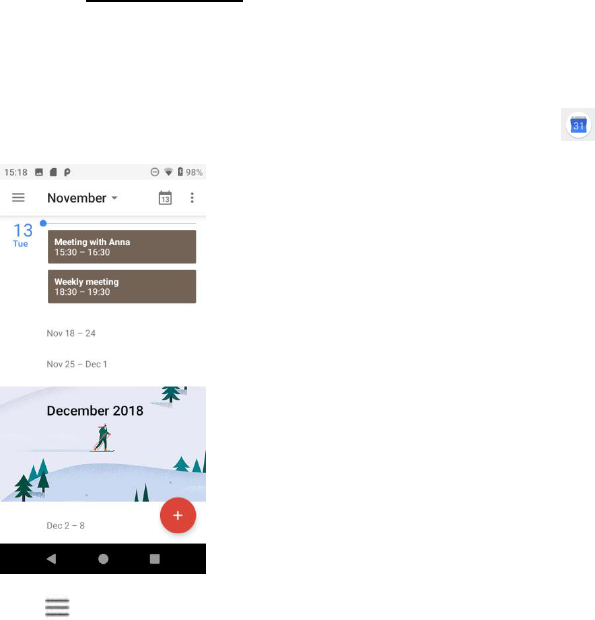
106
Productivity
Use your phone to stay ahead of the game with calendar, navigation, alarm, office, and more
productivity apps.
Calendar
Use Calendar to create and manage events, meetings, and appointments. Your Calendar helps
organize your time and reminds you of important events.
In order to sync with your Google calendar, you must sign in to a Google Account on your
phone. See Google Account.
Calendar view
There are several ways the calendar can be viewed.
1. From home, swipe up to access Apps, and tap Calendar .
2. Tap .
• Schedule: Display all plans.
• Day: Display today’s schedule by hour. Slide the screen to the left and right to display
the previous and the next day.
• 3 Days: Display the previous day, today, and the next day. Slide the screen to the left
and right to view previous and next three days.
• Week: Display the current week. Slide the screen to the left and right to view the
previous and the next week.

107
• Month: Display the current month. Slide the screen to the left and right to view the
previous and the next month.
Add an event
Use your Calendar to create events.
1. From home, swipe up to access Apps, and tap Calendar .
2. Tap Add to add an event.
3. Enter an event title, start date/time, end date/time, etc., and then tap SAVE.

108
View calendar events
1. From home, swipe up to access Apps, and tap Calendar .
2. Tap a date and tap an event to view the details.
Edit an event
1. From home, swipe up to access Apps, and tap Calendar .
2. Tap a date and tap an event to view the details.
3. Tap to edit the event.
4. When done, tap SAVE.
Delete an event
1. From home, swipe up to access Apps, and tap Calendar .
2. Tap a date and tap an event to view the details.
3. Tap to access Options menu, and tap Delete to delete the event.
Selecting a calendar
If you have more than one calendar, select a calendar in which to add events:
• Select My Calendar to create an event that will appear only on your phone.
• Select your Google Account to create a Google Calendar event. If you have several
Google Calendars on the Web, select one in which to add your event.
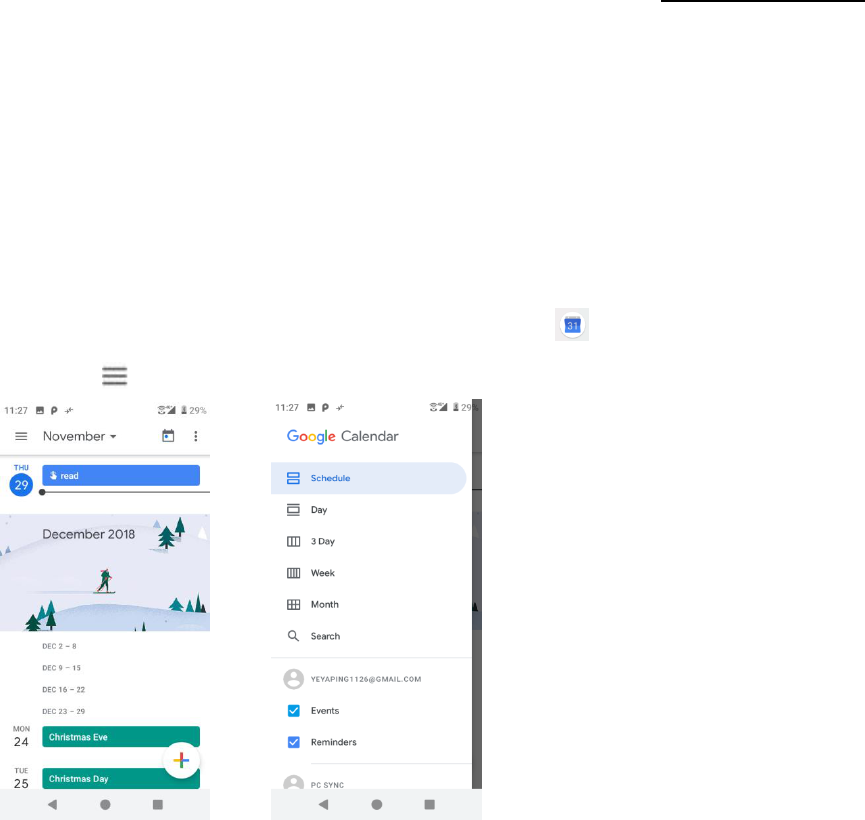
109
You can create multiple Google Calendars only in Google Calendar on the Web. After
creating them in Google Calendar on the Web, you’ll be able to see them in the
Calendar application on your phone. For more information about creating and
managing multiple Google Calendars, visit the Google website: calendar.google.com.
• If you have synchronized your phone with an Exchange ActiveSync account or Outlook
on your computer, you can also select these calendars.
• Select PC Sync to create an Outlook Calendar event to sync with your computer.
• Select Exchange to create an Exchange ActiveSync calendar event.
Sync calendars
You can select which calendars you’d like to sync on your phone, along with what types of
information you want to sync.
1. From home, swipe up to access Apps, and tap Calendar .
2. Tap Menu > Calendars.
3. Select sync options by adding or removing check marks from the items.

110
The sync settings have been updated.
Calendar settings
Use Calendar Settings to customize your calendar.
1. From home, swipe up to access Apps, and tap Calendar .
2. Tap Menu to access Options menu.
3. Tap Settings > General
4. Tap an option and follow the prompts.
Navigation apps
Your phone offers a number of location-based navigation programs to help you figure out where
you are and get you where you’re going.
Enable location services on your phone
Before using any location-based services, you must enable your phone’s location feature. For
information about setting your phone’s location options, see Location.
Google Maps
Use the Google Maps app to determine your location, find directions, browse local businesses
and attractions, rate and review places, and more.
View maps of specified places
Use Google Maps to locate and map a specific address or destination.
1. From home, swipe up to access Apps, and tap Maps .

111
If prompted, follow the onscreen instructions to accept terms of use.
2. Tap Search .
3. Enter an address, city, facility name, etc., and then tap a candidate in the results list.
A map of the specified location opens.
Google Maps operations
• Viewing current location: From the Maps app, tap .
• Obtain useful area information for current location: From the Maps app, tap the search
bar, enter the information you’re looking for, and then tap a result to view it.
• View traffic information, aerial photos, etc., in Maps : From the Maps app, tap Menu
and then tap Traffic, Satellite, Google Earth, etc.
• Check route to destination: From the Maps app, tap , enter your current location and
your destination, tap a method of transport (car, public transit, or on foot).
• Route candidates appear in a list.
• Check Detailed Operation for Maps: From the Maps app, tap Menu > Help.
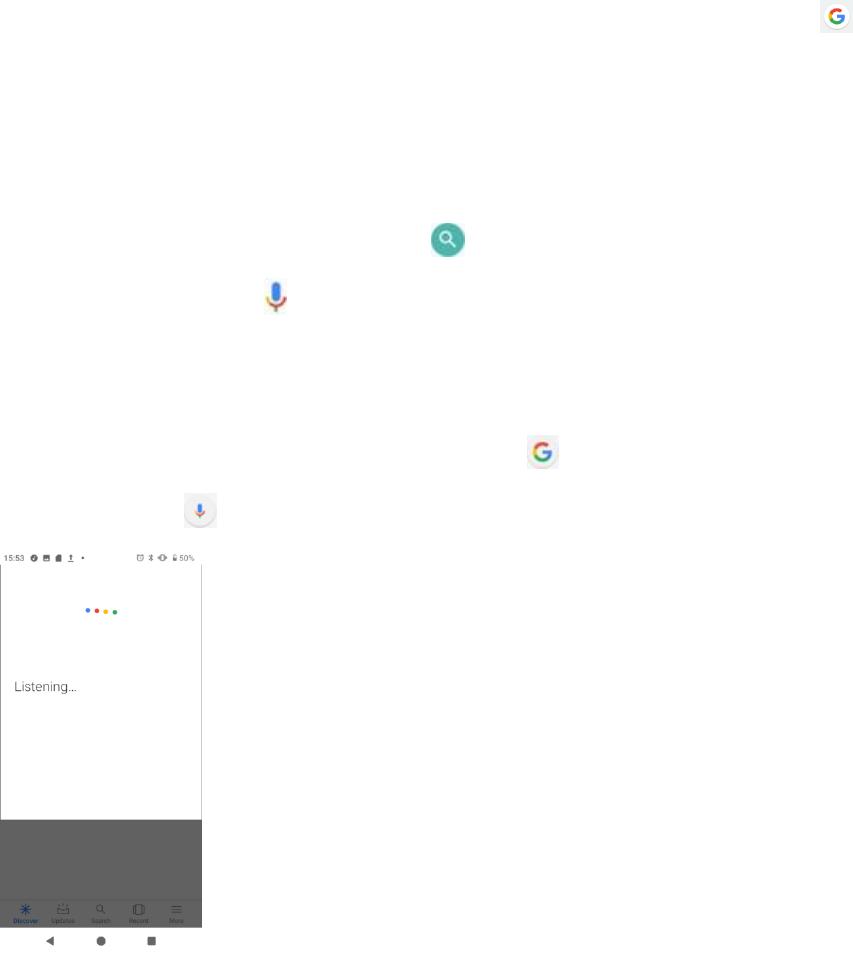
112
Google Search
Search information saved on the phone and in phone applications as well as on the Internet.
Use Google Search
Type search terms in the Google Search bar to find information on your phone and around the
globe.
1. From home, tap the Google search bar, or swipe up to access Apps and tap Google .
The Search window opens.
• If confirmation appears, follow onscreen instructions.
• If a description for Google Now appears, tap Next and read information. Tap Enable on
the last page if you want to use Google Now.
2. Type your search keywords and tap Search .
• To search by voice, tap in the search bar and speak your search terms.
Use Google voice search
Use your voice to search instead of typing, with Google Voice Search.
1. From home, swipe up to access Apps and tap Google .
2. Tap Voice Search
3. Speak your search terms.
Search results appear.

113
Calculator
Your phone’s convenient built-in calculator lets you perform basic mathematical equations.
1. From home, swipe up to access Apps, and tap Calculator .
2. Enter the first number.
3. Tap an arithmetic function key and enter the second number.
4. Tap = to view the result.
5. Tap C to clear the results.

114
View calculator history
You can view and clear your calculator history.
1. From home, swipe up to access Apps, and tap Calculator .
2. Tap to access Options menu.
3. Tap History to view calculator history.
• To return to the calculator, swipe up the screen or tap Back button .
• To clear the calculator history, tap , and tap Clear.
Scientific calculator
1. From home, swipe up to access Apps, and tap Calculator .
2. Turn the device to landscape view more functions.

115
3. Or on the portrait mode, you can tap on the right edge of the screen to view more
advanced functions.
Clock
Your phone has a clock app that lets you set alarms, view time in time zones around the world,
use a stopwatch, set a timer, and use your phone as a desk clock.
Set the date and time
Your phone automatically receives the current date and time from the wireless network. You
can set the date and time manually.
1. From home, swipe up to access Apps, and tap Clock .
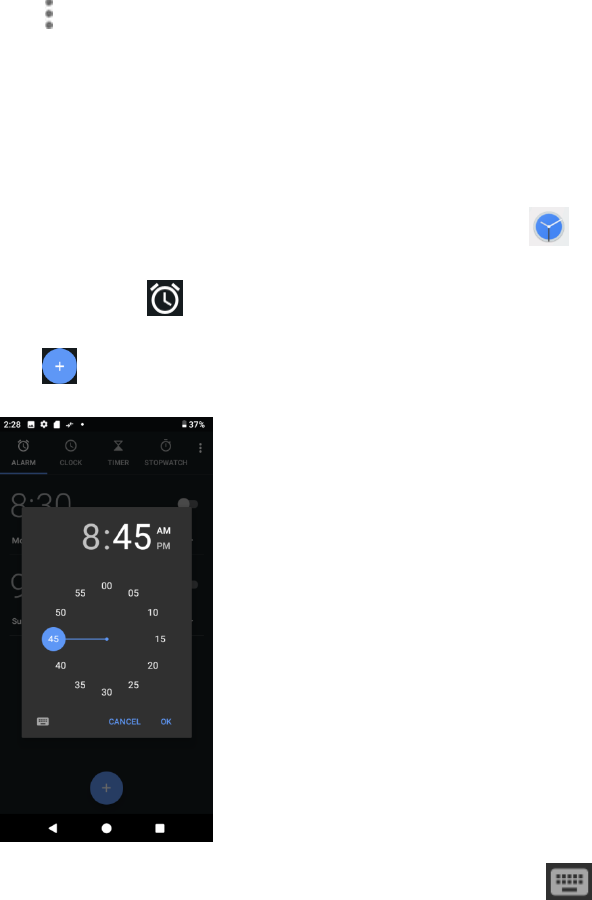
116
2. Tap to access Options menu.
3. Tap Settings > Change date & time.
Set alarms
You can set multiple alarms using your phone’s Clock app.
1. From home, swipe up to access Apps, and tap Clock .
2. Tap the Alarm .
3. Tap .
4. Set the time for the alarm and tap OK. You can also tap to enter time directly.
5. On the screen prompted, there are more options to set.

117
Feature
Description
Repeat
Select the days to repeat the alarm.
Alarm sound
Select a sound to play for the alarm.
Vibrate
Mark the checkbox to activate vibration alert.
Label
Enter a name for the alarm.
Dismiss
Dismiss the current alarm.
Delete
Delete the current alarm.
Turn off alarm
At the set alarm time, the phone sounds the alarm and/or vibrates.

118
1. To stop an alarm, drag the alarm to the dismiss .
2. To postpone the alarm, drag the alarm to the snooze .
Delete an alarm
You can delete an alarm created.
1. From home, swipe up to access Apps, and tap Clock .
2. Tap the alarm you want to delete from the alarm list.
3. Tap Delete.
Additional clock features
Your phone’s clock app provides additional useful features including world clock, stopwatch,
and timer functions.
World clock
The world clock lets you keep track of the current time in multiple cities around the globe.
1. From home, swipe up to access Apps, and tap Clock .
2. Tap to access World clock screen.

119
3. Locate the cities you want to add and mark the checkbox .
• To remove a city, unmark the checkbox .
Stopwatch
The stopwatch lets you time events down to the hundredth of a second.
1. From home, swipe up to access Apps, and tap Clock .
2. Tap to access Stopwatch screen.
3. Enter the length of the stopwatch time.

120
4. Tap to begin timing.
5. Tap to stop timing.
• To resume timing, tap again.
• To reset the Stopwatch to zero, tap RESET.
• To delete the timer, tap DELETE.
• To add a timer, tap ADD TIMER. Swipe up and down to view other timers.
Timer
The timer provides a countdown timer for up to 99 hours, 59 minutes, and 59 seconds.
1. From home, swipe up to access Apps, and tap Clock .
2. Tap to access Timer screen.

121
3. Tap to begin the timer.
4. Tap to stop the timer.
• To resume timing, tap again.
5. Tap RESET to reset the Timer.
6. Tap SHARE to share the Timer.
Clock settings
You can set a batch of settings on Clock, Alarms, and Timers.
1. From home, swipe up to access Apps, and tap Clock .
2. Tap to access options menu.
3. Tap Settings.
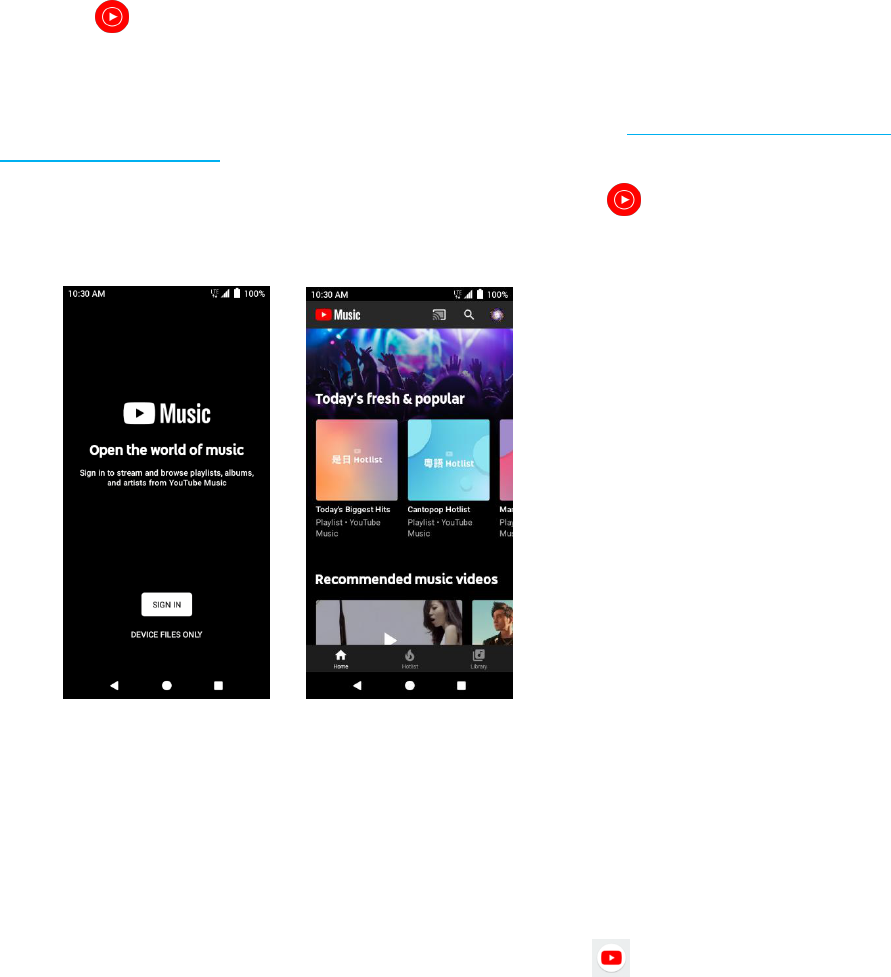
122
Entertainment and activities
The following topics provide an overview of your phone’s entertainment apps, from music
players, YouTube, and more.
YT Music app
YT Music is the official YouTube app built just for music. Find what you’re looking for and
discover new music. Get playlists and recommendations based on your tastes and what’s
trending around you.
Note: For information about loading music onto your phone, see Transfer files between your
phone and a computer.
1. From home, swipe up to access Apps, and tap YT Music .
2. SIGN IN your account.
YouTube
View videos uploaded to YouTube and upload your own videos to your YouTube account.
View YouTube videos
You can use the YouTube app to view videos on YouTube even if you aren’t signed in to a
YouTube account.
1. From home, swipe up to access Apps, and tap YouTube .

123
• If you’re prompted to provide confirmation to use the site, follow the onscreen
instructions to continue.
2. Search through the YouTube channels and tap a video you want to see.
3. The video plays on your phone screen.
• Tap the screen to pause or resume play while watching.
Post a video to YouTube
You can post videos to your YouTube account from your phone. Before posting, you must set
up a YouTube account and sign in to it on your phone.
1. From home, swipe up to access Apps, and tap YouTube .
2. Tap Options > Uploads.
3. Select a video to upload. Enter a title, description, and tags, and select a privacy setting.
4. Tap . The video is uploaded to your YouTube channel.

124
Settings
The topics in this section will cover your phone’s settings menus and options.

125
Basic settings
From the home screen, swipe up to access Apps, and tap Settings to access your phone’s
settings menu. You can also access Settings from the status bar. Drag the status bar down
twice and tap Settings .
The table below outlines the top-level settings categories.
Category
Description
Network & Internet
Set Wi-Fi, mobile network, Hotspot, VPN, airplane mode, and view
data usage.
Connected devices
Manage the settings on connected devices, like Bluetooth, Cast,
USB, etc.
Apps & notifications
View your recently opened Apps, manage the settings on
notifications, permissions, etc.
Battery
Monitor your phone’s battery usage.
Display
Set wallpaper, brightness, font size, etc.
Sound
Set ringtone, operation tones, etc.
Storage
Manage internal storage on your phone and provides menu
choices for an optional SD card (not included).
Privacy
Set permission manager,password,lock screen to protect your
data, and keep your privacy.
Location
Set location access options, screen lock method, password
visibility, encryption & credential storage options, etc.
Security
Set screen lock method, password visibility, encryption & credential
storage options, etc.
Accounts
Manage all your email, social networking, and picture and video
sharing accounts.
Accessibility
Set accessibility options such as screen magnification, hearing aid
compatibility, etc.
Digital wellbeing &
parental controls
Set screen time,app timers,bedtime schedules,etc.
Google
Check and set Google service options.
System
Set language and time, manage reset options, enable backup,
check phone updates, and view more important information about
your phone.
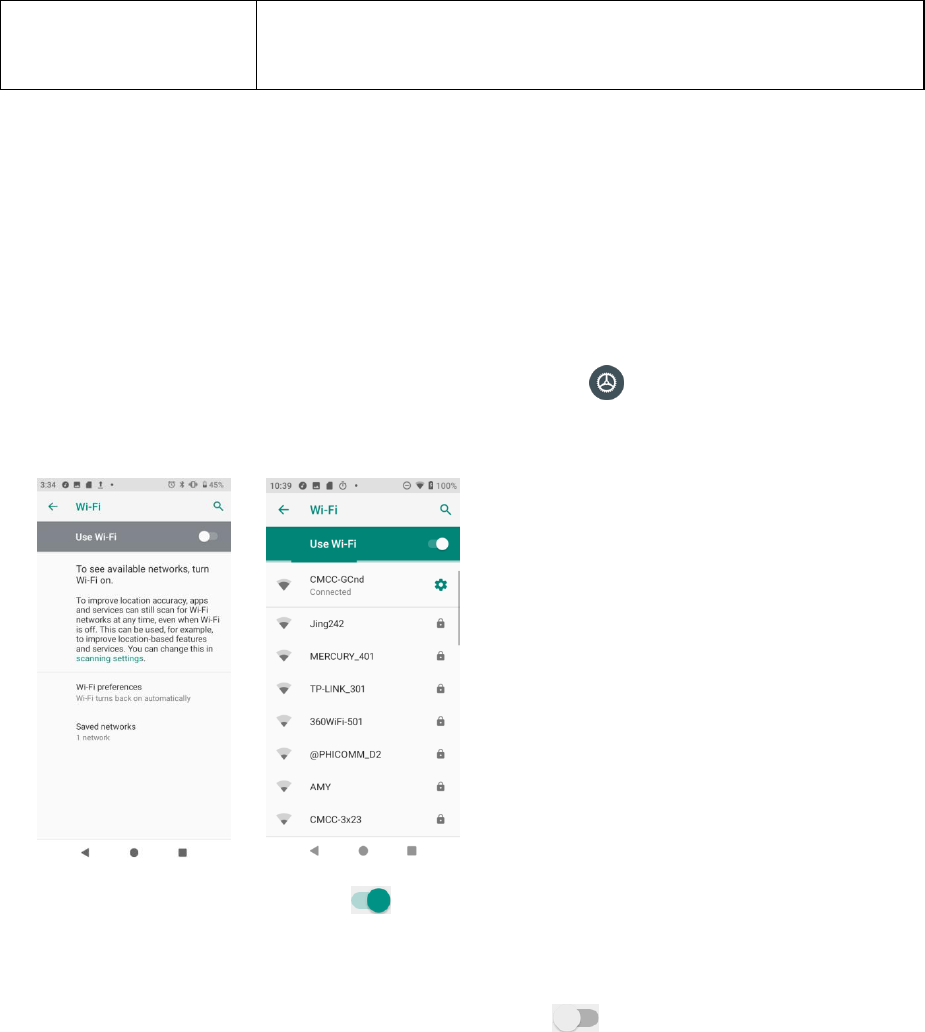
126
About phone
Lets you access important phone information, search for and apply
updates, view legal and safety, and view Quick Start Guide
information.
Network & Internet
Manage connections between your phone and a variety of network and other devices.
Wi-Fi
The Wi-Fi settings menu lets you turn Wi-Fi on or off, set up and connect to available Wi-Fi
networks, and configure advanced Wi-Fi options.
Connect your device to a Wi-Fi network
1. From home, swipe up to access Apps, and tap Settings .
2. Tap Network & Internet > Wi-Fi.
3. Slide the Wi-Fi switch to the On position.
Your phone will automatically search for available networks and you can see the names and
security settings of in-range Wi-Fi networks.
• To disable Wi-Fi, slide the Wi-Fi switch to the Off position.
4. Tap the Wi-Fi network you want to connect to, enter a password, and tap CONNECT. Your
phone is connected to the selected Wi-Fi network.
5. Configure your Wi-Fi settings.

127
• The password, for a household wireless LAN router, is sometimes found on a sticker on
the router (WEP, WPA, KEY, etc.). Contact the router manufacturer for information. For
password for a public wireless LAN, check with user's service provider.
• Entering a password is not required if an access point is not security protected.
Manually connect to a Wi-Fi network
1. From home, swipe up to access Apps, and tap Settings .
2. Tap Network & Internet > Wi-Fi.
3. Slide the Wi-Fi switch to the On position to turn it on.
4. Tap Add network from the bottom of the Wi-Fi screen.
5. Enter the required information about the Wi-Fi network.
• Network name: Enter the SSID or scan QR code to join Wi-Fi.
• Security: Select a security option and enter your password.

128
• Advanced options: Show advanced options, such as IP settings and Proxy settings.
Wi-Fi preferences
The advanced Wi-Fi settings menu lets you set up and manage wireless access points.
Turn on Wi-Fi automatically
1. From home, swipe up to access Apps and tap Settings .
2. Tap Network & Internet > Wi-Fi.
3. Tap Wi-Fi preferences from the bottom of Wi-Fi screen.
4. Slide the Turn on Wi-Fi automatically switch to the On position.
• To turn on Wi-Fi automatically, firstly you need to turn on Wi-Fi scanning.
• Wi-Fi will be turned on automatically when you are near high-quality saved networks,
like your home network.
Open network notification
1. From home, swipe up to access Apps and tap Settings .
2. Tap Network & Internet > Wi-Fi.
3. Tap Wi-Fi preferences from the bottom of Wi-Fi screen.
4. Slide the Open network notification switch to the On position.
• The setting is available when Wi-Fi is turned on.
• Slide the switch to the Off position to turn notification off.
Install certificates
1. From home, swipe up to access Apps and tap Settings .
2. Tap Network & Internet > Wi-Fi.
3. Tap Wi-Fi preferences from the bottom of Wi-Fi screen.
4. Tap Advanced > Install certificates and follow the prompts to finish the setting.
Set network rating provider
1. From home, swipe up to access Apps and tap Settings .
2. Tap Network & Internet > Wi-Fi.
3. Tap Wi-Fi preferences from the bottom of Wi-Fi screen.

129
4. Tap Advanced > Network rating provider.
5. Select your preferred network rating provider, like Google, or None.
Wi-Fi Direct
1. From home, swipe up to access Apps and tap Settings .
2. Tap Network & Internet > Wi-Fi.
3. Tap Wi-Fi preferences from the bottom of Wi-Fi screen.
6. Tap Advanced > Wi-Fi Direct and follow the prompts to finish the setting.
Check MAC address
1. From home, swipe up to access Apps and tap Settings .
2. Tap Network & Internet > Wi-Fi.
3. Tap Wi-Fi preferences from the bottom of Wi-Fi screen.
4. Tap Advanced > MAC address.
Check IP address
1. From home, swipe up to access Apps and tap Settings .
2. Tap Network & Internet > Wi-Fi.
3. Tap Wi-Fi preferences from the bottom of Wi-Fi screen.
4. Tap Advanced > IP address.
Wi-Fi Calling
The Wi-Fi Calling menu lets you set up and manage Wi-Fi Calling service.
1. From the Home screen, swipe up to access Apps and tap Settings .
2. Tap Network & Internet > Wi-Fi Calling.
5. Wi-Fi Calling: Slide the switch to the On or Off position to enable or disable Wi-Fi
Calling.
a) To switch on Wi-Fi Calling, you will follow the set up flow to fill the emergency address
and confirm to start the service provisioning.
b) After the provisioning is finished successfully, you will see the Wi-Fi Calling icon
shown on the status bar.
6. About Wi-Fi Calling: Tap to view the introduction information for Wi-Fi Calling.

130
7. Emergency Address: Tap to update your emergency address to help emergency services
find you if you call 911.
Note: You must have an active Wi-Fi connection to send or receive calls and messages with
Wi-Fi Calling.
Mobile network
Set your phone’s access to networks and mobile data service.
1. From home, swipe up to access Apps and tap Settings .
2. Tap Settings > Network & Internet > Mobile networks.
• Mobile data: Slide the Mobile data switch to the On or Off position to enable
or disable the data access using mobile network.
• Roaming:Slide the Roaming switch to the On or Off .
• App data usage: Tap to view the data used on mobile network.
• VoLTE calls: Slide the VoLTE calls switch to the On or Off .
• Preferred network type: Change the network mode.
• Automatically select network: choose network default is On
• Access Point Names: Select or add APNs.
Data usage
The data usage menu lets you view your phone’s mobile and Wi-Fi data usage, set data limits,
restrict hotspot usage, and more.
1. From home, swipe up to access Apps, and tap Settings .
2. Tap Network & Internet > Data usage.
Mobile data
Monitor mobile data used.
1. From home, swipe up to access Apps, and tap Settings .
2. Tap Network & Internet > Data usage > Mobile.
3. Slide the Mobile data switch to the On position to enable mobile data service.
4. Tap App data usage to view the mobile data usage of each app.

131
5. Tap Data warning & limit, you will see the following options:
• App data usage cycle: Set the day of the month to start the bill cycle for your phone.
• Set data warning: Enable alerts when your mobile data usage reaches the amount
you set.
• Data warning: Set data amount for alert. Data usage measured by your phone is an
approximate amount, and it may differ from the actual amount.
• Set data limit: Enable data limit by sliding the switch to the On position.
• Data limit: Set data limit. Your phone will turn off mobile data when it reaches the limit
you set.
Wi-Fi data
Monitor Wi-Fi data used.
1. From home, swipe up to access Apps, and tap Settings .
2. Tap Network & Internet > Data usage > Wi-Fi.
3. Tap Wi-Fi data usage to view the Wi-Fi data usage of each app.
Hotspot & tethering
Share your phone’s internet connection to other devices.
Wi-Fi hotspot
1. From home, swipe up to access Apps and tap Settings .
2. Tap Network & Internet > Hotspot & tethering > Wi-Fi hotspot.
3. Slide the Wi-Fi hotspot switch to the On position to turn on Wi-Fi hotspot.
• Hotspot name: Tap to set the hotspot name.
• Security: Tap to select security mode.
• Hotspot password: Tap to set hotspot password.
• Turn off hotspot automatically: Slide the switch to the On position to turn off
hotspot automatically if no devices are connected.
• Turn off hotspot time: Tap to set turn off hotspot time.
• Maximum connections: Tap to set the numbers of maximum connection users.
• Connected users: View your connected users.
• Blocked users: View your blocked users.

132
USB tethering
Share your phone’s internet connection via USB. Use a USB cable to connect your phone and
your computer.
1. From home, swipe up to access Apps, and tap Settings .
2. Tap Network & Internet > Hotspot & tethering > USB tethering.
3. Slide the USB tethering switch to the On position to turn on USB tethering.
Bluetooth tethering
1. From home, swipe up to access Apps, and tap Settings .
2. Tap Network & Internet > Hotspot & tethering > Bluetooth tethering.
3. Slide the Bluetooth tethering switch to the On position to turn on Bluetooth tethering.
Airplane mode
Activate Airplane mode
1. From home, swipe up to access Apps and tap Settings .
2. Tap Network & Internet > Airplane mode.
3. Slide the Airplane mode switch to the On or Off position to turn Airplane mode on
or off.
VPN (Virtual Private Networks)
You need to set a lock screen PIN or password before you can use a VPN.
Add VPN profile
1. From home, swipe up to access Apps and tap Settings .
2. Tap Network & Internet > Advanced > VPN.
3. Tap on the top right corner of the VPN screen to add VPN profile.
4. Follow the prompts to finish the settings of your VPN.
Edit and delete a VPN
1. From home, swipe up to access Apps and tap Settings .
2. Tap Network & Internet > Advanced >VPN.
3. Tap next to a VPN.
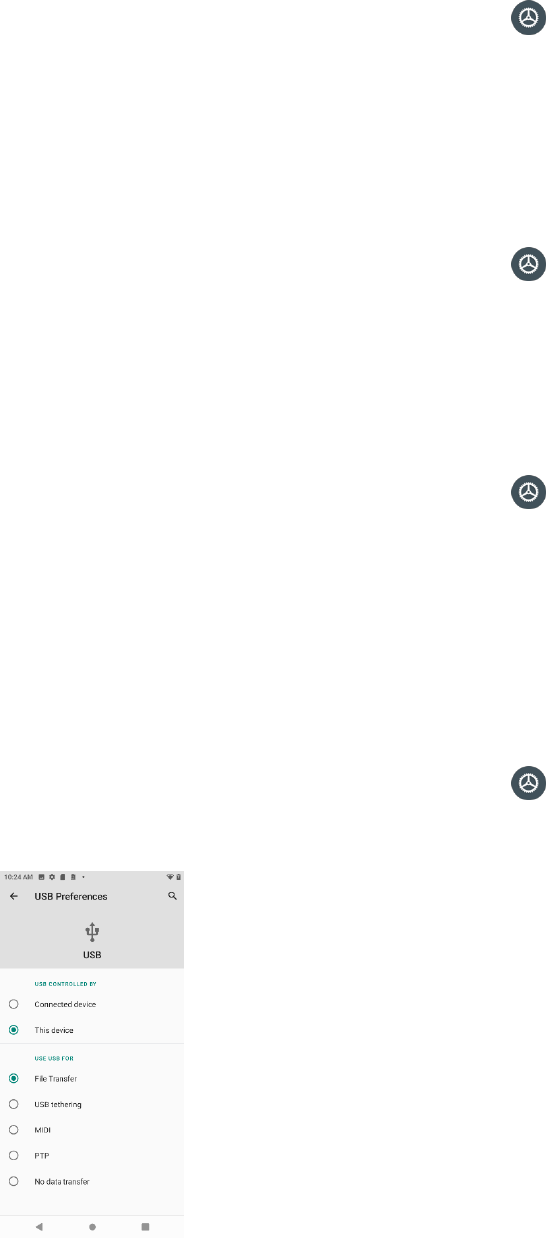
133
4. Edit the VPN and tap SAVE.
5. Tap FORGET to delete the VPN.
Connect to a VPN
1. From home, swipe up to access Apps, and tap Settings .
2. Tap Network & Internet > Advanced >VPN.
3. Tap a VPN, enter your login information and tap CONNECT.
• To disconnect, tap the VPN, and tap DISCONNECT.
Private DNS
1. From home, swipe up to access Apps, and tap Settings .
2. Tap Network & Internet > Advanced > Private DNS.
3. Select Private DNS mode. You can set private DNS mode as off or turn on automatically.
You can also enter and edit the hostname of DNS provider.
Wireless Emergency alerts
1. From home, swipe up to access Apps, and tap Settings .
2. Tap Network & Internet > Wireless Emergency alerts.
Connected devices
USB
You can connect your phone with your computer using a USB cable. When connected, you
need to choose from the following settings before use.
1. From home, swipe up to access Apps and tap Settings .
2. Tap Connected devices > USB.
134
• USB controlled by:
Connected device:
Set USB controlled by the connected device.
This device: Set USB controlled by this device.
• Use USB for:
File transfer: Select to transfer files between your phone and your computer.
USB tethering: Select to set USB tethering mode.
MIDI: Select to set this device as MIDI.
PTP: Select to transfer PTP photos.
No data transfer: Select to set no data transfer mode.
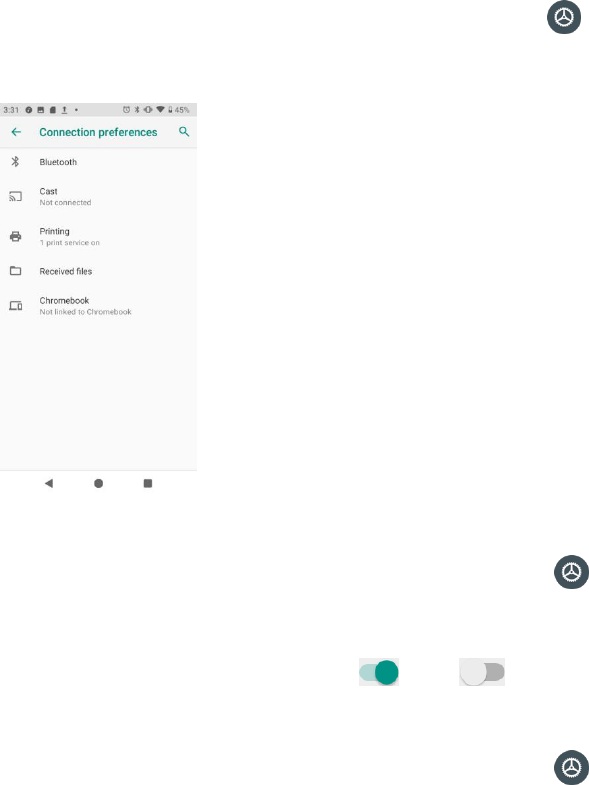
135
Connection preferences
Bluetooth
Your phone’s Bluetooth capabilities let you use wireless headsets, send and receive pictures
and files, and more.
1. From home, swipe up to access Apps and tap Settings .
2. Tap Connected devices > Connection preferences > Bluetooth.
Enable Bluetooth
1. From home, swipe up to access Apps and tap Settings .
2. Tap Connected devices > Connection preferences > Bluetooth.
3. Slide the Bluetooth switch to the On or Off position to turn it on or off.
Pair a Bluetooth device
1. From home, swipe up to access Apps and tap Settings .
2. Tap Connected devices > Connection preferences > Bluetooth.
3. Tap Pair new devices, select the device you want to connect in available devices list, and
follow the prompts to connect. Make sure the devices you want to connect are set to be
discovered.
• Depending on the device, you may be required to enter or accept a passkey.
• If the target device does not appear, tap Refresh to search again.
• This setting is available when Bluetooth is enabled.

136
Rename a paired device
1. From home, swipe up to access Apps and tap Settings .
2. Tap Connected devices > Connection preferences > Bluetooth.
3. Tap Settings next to a paired device name, enter a new name, and tap OK to save.
• Emoji cannot be used in a device name.
• This setting is available when Bluetooth is enabled.
Unpair from a device
1. From home, swipe up to access Apps and tap Settings .
2. Tap Connected devices > Connection preferences > Bluetooth.
3. Tap Settings next to a paired device name, and tap FORGET.
• This setting is available when Bluetooth is enabled.
Enable service from a paired device
1. From home, swipe up to access Apps and tap Settings .
2. Tap Connected devices > Connection preferences > Bluetooth.
3. Tap Settings next to a paired device name and mark the checkbox next to Internet
access.
Search for other devices
1. From home, swipe up to access Apps and tap Settings .
2. Tap Connected devices > Connection preferences > Bluetooth.
3. Tap Pair new device.
• All the devices searched out are listed under Available devices.
• This setting is available when Bluetooth is enabled.
Receive data with Bluetooth
When a device attempts to send a file to your phone using Bluetooth, you will see a request
screen displayed for accepting.
1. Tap Accept.
2. To view the file received, drag the status bar down and tap File received. Or you can locate
the file from Bluetooth settings menu.

137
Check received files
1. From home, swipe up to access Apps, and tap Settings .
2. Tap Connected devices > Connection preferences.
3. Tap Received files.
Cast
Scan for nearby devices to connect to and set them up. A notification will appear when there
are available devices to connect to.
1. From home, swipe up to access Apps and tap Settings .
2. Tap Connected devices > Connection preferences > Cast.
3. Tap to access options menu.
4. Tap Enable wireless display.
5. Tap a device to connect.
Printing
Connect your device to a printer on the same Wi-Fi network.
Default print service
1. From home, swipe up to access Apps and tap Settings .
2. Tap Connected devices > Connection preferences > Printing.
3. Tap Default print service and slide the switch to the On position to turn it on.
4. Tap a printer to connect.
Add printer
1. From home, swipe up to access Apps and tap Settings .
2. Tap Connected devices > Connection preferences > Printing.
3. Tap Default print service and tap .
4. Tap Add printer.
Files received via Bluetooth
1. From home, swipe up to access Apps and tap Settings .
2. Tap Connected devices > Connection preferences > Files received via Bluetooth.

138
Chromebook
1. From home, swipe up to access Apps and tap Settings .
2. Tap Connected devices > Connection preferences > Chromebook.

139
Apps & notifications
You can view currently running applications, manage the settings of notifications, permissions,
and more.
1. From home, swipe up to access Apps and tap Settings .
2. Tap Apps & notifications
Recently opened apps
View and manage your recently opened apps.
1. From home, swipe up to access Apps and tap Settings .
2. Tap Apps & notifications.
3. Tap an App > App info.
4. View the detailed information. Tap DISABLE to disable this app, and tap FORCE STOP to
stop this app.
Notifications
Manage your phone’s notification settings.
1. From home, swipe up to access Apps, and tap Settings .
2. Tap Apps & notifications > Notifications.
See all form last 7 days: Tap to see which applications showed notifications in the last
days.

140
Notifications on lockscreen: Tap to select Show alerting and silent notifications,
Show alerting notification only or Don’t show notifications on the lock screen.
Allow notification snoozing:Slide the switch to the On position to allow the display
of notification snoozing.
Allow notification dots: Slide the switch to the On position to allow the display of
notification dots on app icon.
Blink light:Slide the switch to the On position to allow the blink light on.
Default notification sound: Tap to select a default notification sound. You can also
customize your own ringtone by tapping .
Do Not Disturb: Tap to set Do Not Disturb behavior, exceptions, schedule, and turn it on or
off.
Default apps
Manage your phone’s default apps.
1. From home, swipe up to access Apps and tap Settings .
2. Tap Apps & notifications > Default apps.
3. Tap to set default app for browser, phone, SMS, etc. And you can also set default apps for
opening links.
Permission manager
Manage your phone’s app permissions.
1. From home, swipe up to access Apps and tap Settings .
2. Tap Apps & notifications > Advanced> permission manager.
3. Tap a function to view the current allowed apps.
• Slide the switch to the On or Off position to modify the permissions.
Special app access
Manage your phone’s app permissions.
1. From home, swipe up to access Apps and tap Settings .
2. Tap Apps & notifications > Advanced>Special app access.
3. Tap to view app access for special functions, such as unrestricted data, usage access,
install unknown apps, display over other apps, picture-in-picture, etc.
141
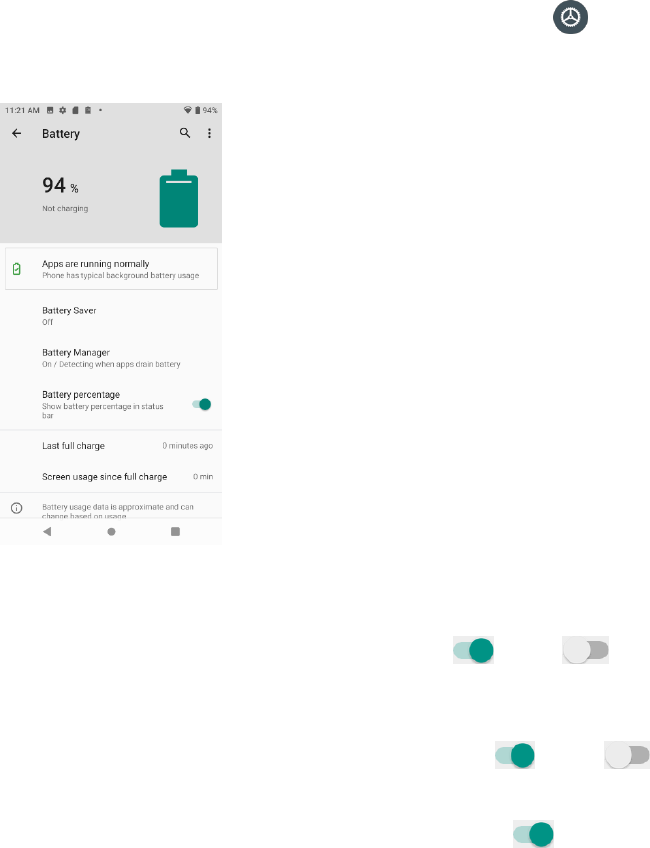
142
Battery
Monitor your phone’s battery usage through this settings menu. Check the battery consumption
and percentage.
1. From home, swipe up to access Apps and tap Settings .
2. Tap Battery.
• Apps are running normally: Indicate that your apps are using a normal amount of
battery.
• Battery saver: Slide the switch to the On or Off position to turn the battery
saver on or off. You can set automatic turn on battery saver by tapping Battery saver >
Turn on automatically.
• Battery Manager: Slide the switch to the On or Off position to turn the Use
Battery Manager function on or off.
• Battery percentage: Slide the switch to the On position to show battery
percentage in status bar.
• Last full charge: View the time of last full charge.
• Screen usage since full charge: View the time screen used since last full charge.

143
Display
Use the phone's display settings menu to adjust items such as wallpaper, brightness, screen
timeout, and more.
1. From home, swipe up to access Apps and tap Settings .
2. Tap Display.
• Brightness level: Tap to adjust brightness level. Drag the slider towards right or left to
manually set brightness level.
• Night light: Tap to set night light schedule, intensity, and enable or disable turn on until
sunrise.
• Adaptive brightness: Slide the switch to the On or Off position to turn the
adaptive brightness mode on or off. When it is turned on, your phone will automatically
adjust screen brightness based on the lighting conditions.
• Wallpaper: Tap to choose a picture to set as wallpaper.
• Dark theme: System theme color changed to dark theme.
• Screen timeout: Tap to set sleep duration. When set,your screen will be turned off
after the sleep duration.
• Auto-rotate screen: Slide the switch to the On or Off position to turn the auto-
rotate screen on or off.
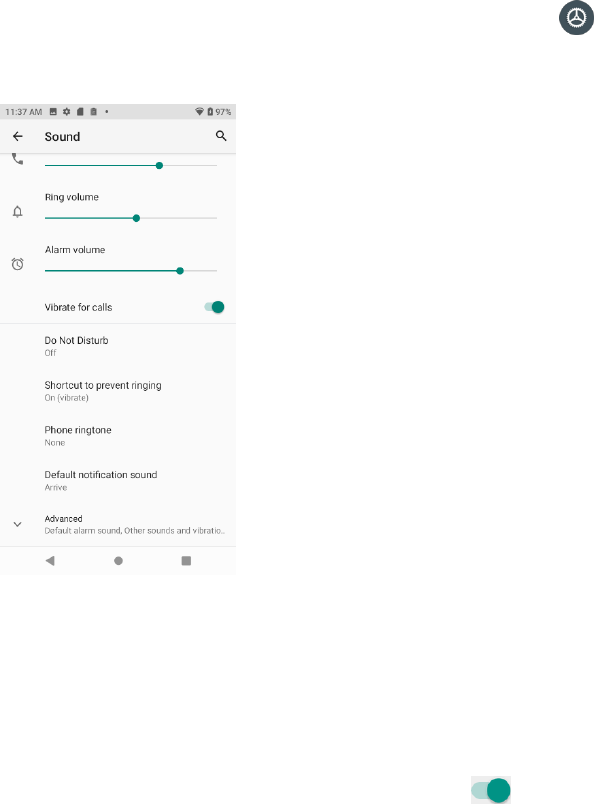
144
• Font size: Drag the slider towards right or left to set font size. You can view sample text
for reference.
• Display size: Drag the slider towards right or left to set the screen item display size. You
can take the display of preview window for reference.
• Screen saver: Tap to select current screen saver, adjust screen saver settings, and set
the time to start screen saver.
• Lock screen display: Manage whether to display all notifications content on the lock
screen, add lock screen message.
Sound
The sound settings menu lets you control your phone’s audio, from ringtones and alerts to tap
tones and notifications.
1. From home, swipe up to access Apps, and tap Settings .
2. Tap Sound.
• Media volume: Drag the slider towards right or left to set the strength of media volume.
• Call volume: Drag the slider towards right or left to set the strength of call volume.
• Ring volume: Drag the slider towards right or left to set the strength of ring volume.
• Alarm volume: Drag the slider towards right or left to set the strength of alarm volume.
• Vibrate for calls: Slide the switch to the On position to activate vibration for calls.

145
• Do Not Disturb: Tap to manage Do Not Disturb settings. Some notifications will be
silenced when Do Not Disturb is turned on.
Calls: Tap to set the contacts who are allowed to call you while your device is in Do Not
Disturb mode.
SMS, MMS, and Messaging apps: Tap to set if SMS, MMS, and messages are allowed
while your device is in Do Not Disturb mode.
See all exceptions: Tap to set which items you allow,when Do Not Disturb is on.
Restrict notifications: tap to set No sound form notifications, No visuals or sound
form notifications, or Custom.
Default duration: Tap to set Do Not Disturb duration.
Schedules: Configure event and time rule for Do Not Disturb schedule.
• Shortcut to prevent ringing: Tap to set key pressing mode to prevent ringing.
• Phone ringtone: Tap to select a ringtone for incoming phone calls. You can customize
your own ringtone by tapping Add ringtone.
• Default notification sound: Tap to select default notification sound. You can customize
your own notification sound by tapping .
• Default alarm sound: Tap to select default alarm sound. You can customize your own
notification sound by tapping .
• Other sounds and vibrations: Tap to set other sounds and vibrations, such as dial pad
tones, screen locking sounds, charging sound, touch sounds, touch vibration, etc.
Storage
The storage settings menu lets you manage internal storage on your phone and provides menu
choices for an optional SD card (not included).
1. From home, swipe up to access Apps and tap Settings .
2. Tap Storage.

146
• Internal shared storage:
Tap to view storage amount used by each app.
You can free up some space by tapping FREE UP SPACE.
Storage manager: Storage manager removes backed up photos and videos from your
device. Slide the switch to the On or Off position to turn storage manager on
or off.
• SD card:
Tap SD card to view files stored on your SD card.
Tap to unmount the card to allow for safe removal.
Tap SD card > MOUNT to mount the card and make it available for use.
Tap SD card > > Storage settings > Format to format your SD card.
Privacy
The location settings will help you to secure your device, protect your data, and keep your
privacy.
1. From home, swipe up to access Apps and tap Settings .
2. Tap Privacy.

147
Permission manager
1. From home, swipe up to access Apps, and tap Settings .
2. Tap Privacy > Permission manager.
3. To control apps permission that using microphone, contacts, and storage.
Show passwords
1. From home, swipe up to access Apps, and tap Settings .
2. Tap Privacy > Show passwords.
3. Slide the Show passwords switch to the On or Off position to display characters
briefly as you type.
Lock screen
1. From home, swipe up to access Apps and tap Settings .
2. Tap Privacy > Lock screen.
3. Tap to set Show all notification content or Don’t show notification at all.
Auto-fill service for google
1. From home, swipe up to access Apps and tap Settings .
2. Tap Privacy > Auto-fill service for Google.
3. Tap to create an account.

148
Advanced
Google Location History: Tap to view your location history.
Activity controls: Choose the activities and info you allow Google.
Ads: Tap to control advertising ID and personalization.
Usage & diagnostics: Slide the switch to the On or Off
Location
The location settings will help you to secure your device, protect your data, and keep your
privacy.
3. From home, swipe up to access Apps and tap Settings .
4. Tap Location.
5. Slide the use location switch to the On position to turn location services on.
Recent location requests
You can view a list of apps requested location access in recent.
App permissions
Tap to view which apps have permission to access location services.
Wi-Fi and Bluetooth scanning
Wi-Fi scanning: Improve location by allowing system apps and services to detect Wi-
Fi networks at any time. Slide the switch to the On position to turn it on.

149
Bluetooth scanning: Improve location by allowing system apps and services to detect
Bluetooth devices at any time. Slide the switch to the On position to turn it on.
Advanced
1. Location services
Emergency Location Service
Slide the switch to the On , when you call or text an emergency number ,your
device uses ELS to automatically send its location to emergency responders.
Google Location Accuracy: Slide the improve location accuracy switch to the On
position to use GPS, Wi-Fi, Bluetooth, mobile networks, and sensors to determine your
location.
Google Location History: Tap to view your location history.
Google Location Sharing: Tap to share your location.
Network Data Analytics
.
Security
The security and location settings will help you to secure your device, protect your data, and
keep your privacy.
6. From home, swipe up to access Apps and tap Settings .
7. Tap Security.
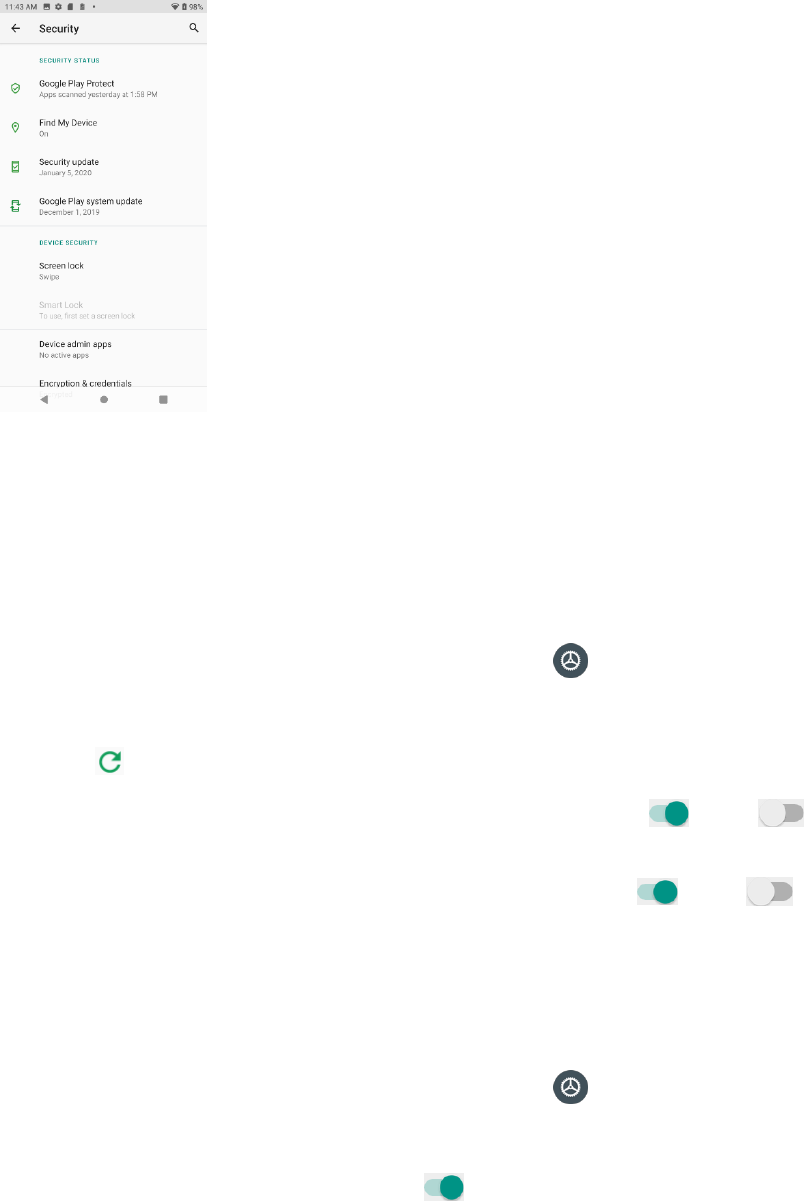
150
Security status
View current security status.
Google Play Protect
Google will regularly check your device and prevent/warn about potential harm. Only apps from
Play Store will be checked.
1. From home, swipe up to access Apps and tap Settings .
2. Tap Security > Google Play Protect.
• Tap to start full scanning on your device.
• Slide the Scan device for security threats switch to the On or Off position
to enable or disable regular scanning on your device for security threats.
• Slide the Improve harmful app detection switch to the On or Off position
to send or not send unknown apps to Google for better detection.
Find My Device
Find My Device helps you locate the device remotely, keep your data safe when your device is
lost.
1. From home, swipe up to access Apps and tap Settings .
2. Tap Security > Find My Device.
3. Slide the Find My Device switch to the On position to activate Find My Device
function.

151
4. Tap Find My Device won’t work to get some help if needed.
5. There are several ways available for your selection to locate your device.
Security update
Check if there is a new update to your system or to your security patch.
1. From home, swipe up to access Apps and tap Settings .
2. Tap Security > Security update.
3. Tap Check for update to start checking.
Device security
You can set a screen lock to protect your phone from others.
Screen lock
1. From home, swipe up to access Apps and tap to Settings .
2. Tap Security > Screen lock.
• None: Don’t set any screen lock.
• Swipe: Tap to set swipe as the screen lock.
• Pattern: Tap to set a lock pattern. Follow the prompts to finish the settings.
• PIN: Tap to set a PIN code as the screen lock.
• Password: Tap to set a password as the screen lock.
Important: To protect your phone and data from unauthorized access, it is recommended that
you use the highest security level available (Password protection). It is also recommended you
frequently change your password to ensure the safety of your phone and personal data. If you

152
failed to enter the correct pattern, PIN, or password, after five attempts, you will be prompted to
wait for 30 seconds before you can try again.
3. Tap next to Screen lock to adjust some settings on screen lock.
• Make pattern visible: Slide the switch to the On position to make pattern visible.
• Automatically lock: Tap to set automatically lock time.
• Power button instantly locks: Slide the switch to the On position to activate
instant lock by the Power button.
• Lock screen message: Tap to set lock screen message.
Smart lock
Unlock your device automatically on some conditions. For more information about Smart lock,
tap to access Options menu, and tap How it works or Help.
1. From home, swipe up to access Apps and tap Settings .
2. Tap Security & location > Smart lock.
3. Tap On-body detection and slide the switch to the On position to activate it. Your
device will now be kept unlocked while it’s on you.
Device admin apps
1. From home, swipe up to access Apps and tap Settings .
2. Tap Security > Device admin apps.
View device admin apps, and mark or unmark the checkbox to enable or disable it
SIM card lock
1. From home, swipe up to access Apps and tap Settings .
2. Tap Security & location > Advanced > Lock SIM card.
3. Slide the Lock SIM card switch to the On or Off position turn SIM car lock on or
off. It requires PIN to use your device.
4. Tap Change SIM PIN to change PIN code.
Encryption & credentials
1. From home, swipe up to access Apps, and tap Settings .

153
2. Tap Security & location > Encryption & credentials.
Encrypt phone: Your phone is encrypted.
Storage type: Your phone’s credential storage type is hardware-backed.
Trusted credentials: Tap to view trusted CA certificates.
User credentials: Tap to view and modify stored credentials.
Install from SD card: Tap to install certificates from SD card.
Clear credentials: Tap to remove all certificates.
Trust agents
1. From home, swipe up to access Apps, and tap Settings .
2. Tap Security > Trust agents.
3. View your trusted agents. Slide the switch to the On or Off position to turn it on
or off.
Screen pinning
1. From home, swipe up to access Apps, and tap Settings .
2. Tap Security > Advanced > Screen pinning.
3. Slide the switch to the On or Off position to turn it on or off. When turned on, you
can use screen pinning to keep the current screen in view until you unpin.
Accounts
You can set up and manage all your accounts here, including your Google Account, other social
networking accounts, etc.
Add account
1. From home, swipe up to access Apps and tap Settings .
2. Tap Accounts > Add account.
3. Tap one of the account types.
4. Follow the prompts to enter your credentials and set up the account.
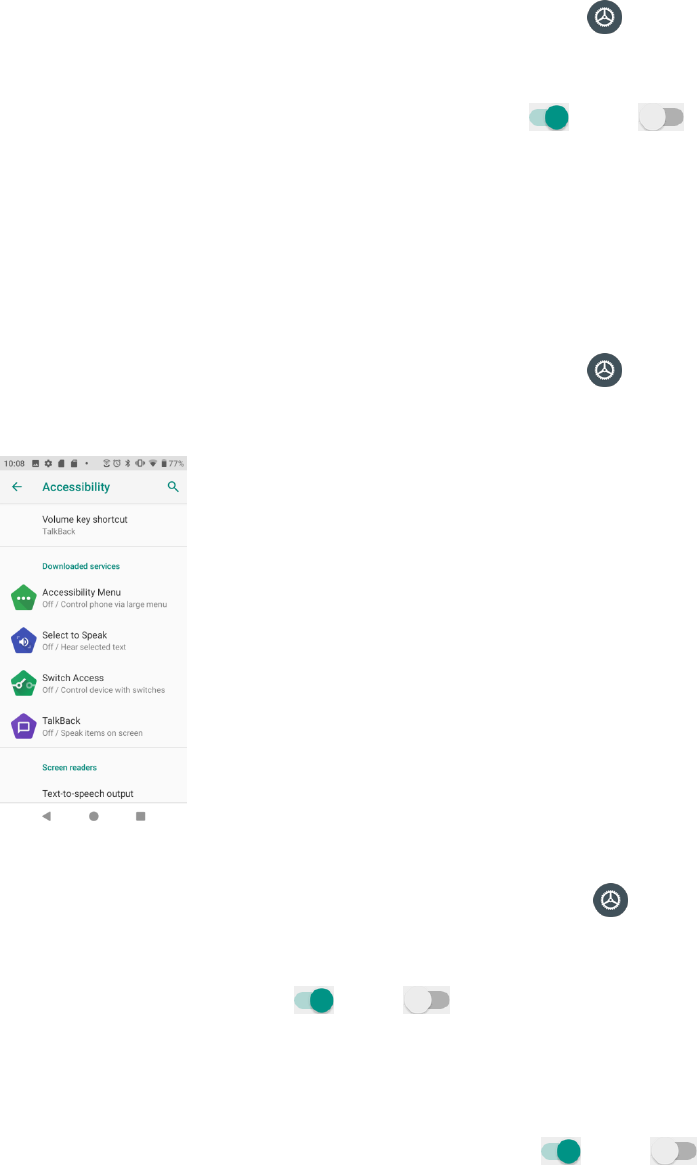
154
Automatically sync data
1. From home, swipe up to access Apps and tap Settings .
2. Tap Accounts > Automatically sync data.
3. Slide the automatically sync data switch to the On or Off position to turn it on or
off.
Accessibility
The accessibility menu lets you enable and manage accessibility-related applications.
Accessibility services are special features to make device easier to use for those with certain
physical disabilities.
1. From home, swipe up to access Apps and tap Settings .
2. Tap Accessibility.
Volume key shortcut
1. From home, swipe up to access Apps, and tap Settings .
2. Tap Accessibility > Volume key shortcut.
3. Slide the switch to the On or Off position to turn it on or off. When the shortcut
function is turned on, you can press both volume keys for 3 seconds to start an accessibility
feature.
4. Tap Shortcut service to select a downloaded service as a volume key shortcut function.
5. Slide the Allow from lock screen switch to the On or Off position to turn this
function on or off.

155
Downloaded services
1. From home, swipe up to access Apps, and tap Settings .
2. Tap Accessibility.
3. View downloaded services.
• Accessibility Menu
• Select to Speak
• Switch Access
• TalkBack
Screen readers
Text-to-speech output
1. From home, swipe up to access Apps, and tap Settings .
2. Tap Accessibility > Text-to-speech output.
• Preferred engine: Tap to set Text-to-speech engine. Tap to manage TTS settings.
Language: Tap to set the language for using this function.
Speech rate: Drag the slider to the right or left to adjust the speech rate.
Pitch: Drag the slider to the right or left to adjust the pitch.
Install voice data: Tap to select a language and download the language voice data.
Use Wi-Fi only: Slide the switch to the On position to enable using only Wi-Fi to
download voices data.
Amplify speech volume: Slide the switch to the On position to make spoken text
louder than normal.
Intonation: Tap to set intonation options.
Number processing: Slide the switch to the On position to enable number
processing, which will affect how dates and times are spoken.
Language detection: Tap to set language detection as Off, Conservative, or
Aggressive.

156
Anonymous usage reports: Slide the switch to the On position to activate
anonymous usage reports function, which will help to better understand the performance of
Text-to-speech function on your device.
Feedback: Tap to write your feedback about this function.
• Tap PLAY to play the example.
• Tap RESET to reset all Text-to-speech settings to the default settings.
Display
Font size
1. From home, swipe up to access Apps and tap Settings .
2. Tap Accessibility > Font size.
3. Drag the slider to the right or left to adjust the font size.
Display size
1. From home, swipe up to access Apps and tap Settings .
2. Tap Accessibility > Display size.
3. Tap or to make the items on your screen smaller or larger.
Dark theme
1. From home, swipe up to access Apps and tap Settings .
2. Tap Accessibility > Dark theme.
3. Slide the switch to the On or Off to set theme.
Magnification
1. From home, swipe up to access Apps and tap Settings .
2. Tap Accessibility > Magnification.
• Magnify with triple-tap: Slide the switch to the On or Off position to enable
or disable magnify with triple-tap.
• Magnify with button: Slide the switch to the On or Off position to enable or
disable quickly magnify by accessibility button at the bottom of the screen.

157
Color correction
1. From home, swipe up to access Apps and tap Settings .
2. Tap Accessibility > Color correction.
3. Slide the switch to the On or Off position to enable or disable color correction
function. It may affect device performance.
• Correction mode: Tap to select color correction mode.
Color inversion
1. From home, swipe up to access Apps and tap Settings .
2. Tap Accessibility > Color inversion.
3. Slide the switch to the On or Off position to enable or disable color inversion
mode. It may affect device performance.
Large mouse pointer
1. From home, swipe up to access Apps and tap Settings .
2. Tap Accessibility > Large mouse pointer.
3. Slide the switch to the On or Off position to enable or disable large mouse pointer
function.
Remove animations
1. From home, swipe up to access Apps and tap Settings .
2. Tap Accessibility > Remove animations.
3. Slide the switch to the On or Off position to turn it on or off.
Interaction controls
Dwell timing
1. From home, swipe up to access Apps, and tap Settings .
2. Tap Accessibility > Dwell timing.
3. Slide the switch to the On or Off position to enable or disable click automatically
after pointer stops moving.

158
Power button ends the call
1. From home, swipe up to access Apps and tap Settings .
2. Tap Accessibility > Power button ends call.
3. Slide the switch to the On or Off position to enable or disable Power button ends
call function.
Auto-rotate screen
1. From home, swipe up to access Apps and tap Settings .
2. Tap Accessibility > Auto-rotate screen.
3. Slide the switch to the On or Off position to enable or disable screen to
automatically rotate.
Touch & hold delay
1. From home, swipe up to access Apps and tap Settings .
2. Tap Accessibility > Touch & hold delay.
3. Tap to set touch & hold delay as Short, Medium, or Long.
Time to take action
(
Accessibility timeout
)
1 .From home, swipe up to access Apps and tap Settings .
2. Tap Accessibility > Time to take action.
3 Tap to set to Time to take action as Default, 10seconds ;30seconds;1minutes;2minutes.
Vibration & haptic strength
1 .From home, swipe up to access Apps and tap Settings .
2. Tap Accessibility > Vibration & haptic strength.
Ring vibration: Slide the switch to the On or Off
Notification vibration: Slide the switch to the On or Off
Touch feedback: Slide the switch to the On or Off

159
Audio & on-screen text
Mono audio
1. From home, swipe up to access Apps, and tap Settings .
2. Tap Accessibility > Mono audio.
3. Slide the switch to the On or Off position to enable or disable Mono audio
function.
Audio balance
1. From home, swipe up to access Apps, and tap Settings .
2. Tap Accessibility > Sound balance.
3. Drag the slider to the right or left to adjust the sound balance.
Caption preferences
1. From home, swipe up to access Apps, and tap Settings .
2. Tap Accessibility > Caption preferences.
3. Slide the switch to the On or Off position to enable or disable captions function.
4. You can also set caption display language, text size, and caption style.
Experimental options
High contrast text
1. From home, swipe up to access Apps and tap Settings .
2. Tap Accessibility > High contrast text.
3. Slide the switch to the On or Off position to enable or disable high contrast text
display.
Google
Configure your device’s Google settings. Available options depend on your Google account.
1. From home, swipe up to access Apps and tap Settings .
2. Tap Google.
3. Select an option to customize.
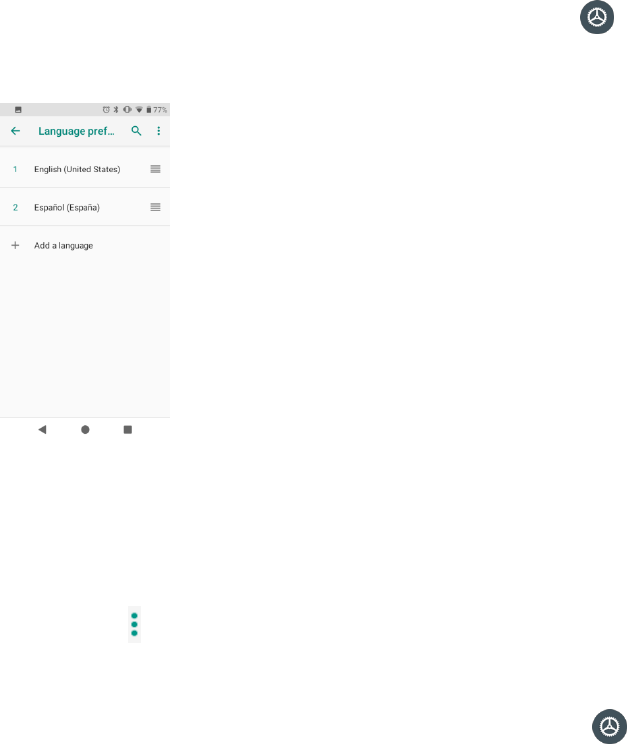
160
System
The following topics detail your phone’s system settings options, including language and input
settings, battery and storage, date and time, activation, system update, and device information.
Languages & input
Your phone’s language and input settings let you select a language for the phone’s menus and
keyboards, select and configure keyboard settings, configure speech input settings, and set
your phone’s mouse/trackpad options.
Languages
1. From home, swipe up to access Apps and tap Settings .
2. Tap System > Language & input > Languages.
• View currently selected languages. When there is more than one language selected,
you can drag one language up to the first position to set as the default display
language.
• Tap Add a language to add a language from system language list.
• Tap to access options menu, and tap Remove to remove languages.
Keyboard
1. From home, swipe up to access Apps, and tap Settings .
2. Tap System > Language & input > Advanced > Keyboards.
• Virtual keyboard: Tap to view current visual keyboards.
Manage keyboards: Tap to activate or deactivate current visual keyboards.

161
• Physical keyboard: Tap to view physical keyboard settings.
Show virtual keyboard: Slide the switch to the On or Off position to enable
or disable the display of virtual keyboard while physical keyboard is active.
Keyboard shortcuts helper: Tap to set keyboard shortcuts.
Tools
1. From home, swipe up to access Apps, and tap Settings .
2. Tap System > Language & input > Advanced > Tools.
• Spell checker: Slide the switch to the On or Off position to enable or disable
spell checker function.
Default spell checker: Tap to select default spell checker.
• Autofill service: Tap to activate or deactivate autofill function.
• Personal dictionary: Tap to maintain your own dictionary. Tap to add a word to the
dictionary.
• Pointer speed: Tap to set the speed of the pointer for a mouse/trackpad
• Text-to-speech output: Tap to manage settings on Text-to-speech function.
Gestures
Jump to camera
Jump to camera is a function to quickly open Camera.
1. From home, swipe up to access Apps, and tap Settings .
2. Tap System > Gestures > Jump to camera.
3. Slide the switch to the On or Off position to enable or disable Jump to camera
function. When enabled, press the Power key twice to quickly open Camera. It works from
any screen.
Swipe up on Home button
1. From home, swipe up to access Apps and tap Settings .
2. Tap System > Gestures > Swipe up on Home button.
3. Slide the switch to the On or Off position to enable or disable Swipe up on Home
button function. When enabled, swipe up on the Home button to switch apps, and swipe up
again to see all apps. It works from any screen.

162
Prevent ringing
1. From home, swipe up to access Apps and tap Settings .
2. Tap System > Gestures > Prevent ringing.
3. Tap to assign Vibrate, Mute, or Do nothing to the action of pressing Power and Volume
Up key together.
Date & time
1. From home, swipe up to access Apps and tap Settings .
2. Tap System > Date & time.
• Use network-provided time: Tap to set how automatic date & time was provided. You
can select Use network-provided time or Use GPS-provided time. Or you can select
Off to turn this function off.
• Set date: Tap to set date manually. This option available only when automatic date &
time function is turned off.
• Set time: Tap to set time manually. This option available only when automatic date &
time function is turned off.
• Automatic time zone: Slide the switch to the On or Off position to enable or
disable this function.
• Select time zone: Tap to select your time zone. This option available only when
automatic time zone function is turned off.
• Use locale default: Slide the switch to the On or Off position to activate or
deactivate Automatic 24-hour format.
• Use 24-hour format: Slide the switch to the On or Off position to activate or
deactivate 24-hour format.
Backup
Your phone’s Backup settings lets you back up your phone’s data and settings to Google
servers before resetting your phone to the original factory settings.
1. From home, swipe up to access Apps and tap Settings .
2. Tap System > Back up.
• Slide the Back up to Google Drive switch to the On or Off position to turn it
on or off. Backup includes Apps data, Call history, Contacts, Messages, device
settings, etc.

163
Reset options
1. From home, swipe up to access Apps and tap Settings .
3. Tap System > Advanced > Reset options.
• Reset Wi-Fi, mobile & Bluetooth: This reset mode will reset all network settings,
including Wi-Fi, Mobile data, and Bluetooth. Tap RESET SETTINGS to perform the
reset.
• Reset app preferences: This reset mode will reset all app preferences, including
disabled apps, disabled app notifications, default apps, background data restrictions,
etc. Tap RESET APPS to perform the reset.
• Erase all data (factory reset): This reset mode will erase all data from your phone’s
internal storage. Tap RESET PHONE to perform the reset.
Tip: Before performing a factory data reset on your phone, you may want to unmount an
installed SD memory card to avoid losing any data you may have stored on it.
Multiple users
You can share this device with other people by creating additional users. Each user has their
own space, which they can customize with apps, wallpaper, and so on. Users can also adjust
device settings like Wi-Fi that affect everyone.
Edit profile info
1. From home, swipe up to access Apps and tap Settings .
2. Tap System > Advanced > Multiple users.
3. Tap You (Owner).
4. Enter a name.
5. Tap to add a photo.

164
6. Tap OK to confirm.
Add new users
1. From home, swipe up to access Apps and tap Settings .
2. Tap System > Advanced >Multiple users.
3. Tap Add user and finish the later steps.
Switch users
1. From home, swipe up to access Apps and tap Settings .
2. Tap System > Multiple users.
3. Tap the name of the user you want to switch to.
Remove users
1. From home, swipe up to access Apps and tap Settings .
2. Tap System > Advanced > Multiple users.
When you are at owner/admin mode, tap by the side of other user’s name, and tap
Remove user to remove.
When you are not at owner’s mode, tap Remove [name of the user] to remove.
Note that all apps and data of this removed user will be deleted.
System updates
1. From home, swipe up to access Apps and tap Settings .
2. Tap System > Advanced > System updates.
• Update PRL: Tap to update the preferred roaming list.
• System update: Tap to check for system update.
• UICC unlock: Your phone is locked to a Sprint SIM only, so this function is not
available to set.
About phone
The about phone menu lets you access important phone information, search for and apply
updates, view legal and safety,and view Quick Start Guide information.
1. From home, swipe up to access Apps, and tap Settings .
165
2. Tap About phone.
• Device name: Tap to edit your phone’s display name.
• Phone number: Display your phone number.
• Emergency information: Adding medical information and emergency contacts can
help first responders in an emergency. Anyone can read this information from your lock
screen, and dial your contacts by tapping their names, without unlocking your phone.
• Legal information: Tap to view your device’s legal information, including third-party
licenses, Google legal, system WebView licenses, etc..
• Regulatory & Safety: Tap to view your device’s regulatory & safety information.
• SIM status: Tap to view your SIM status information, like network, phone number on
SIM, Mobile network state, etc.
• ICCID: Display your device’s ICCID.
• IMSI: Display your device’s IMSI.
• MEID: Tap to view your device’s MEID information.
• Model & hardware: Display your device’s model and hardware information.
• IMEI: Display your device’s IMEI.
• Android version: Tap to view your device’s Android version and other relevant
information, like Baseband version, Kernel version, Build number, etc.
• IP address: Display your device’s IP address.
• Wi-Fi MAC address: Display your device’s Wi-Fi MAC address.
• Bluetooth address: Display your device’s Bluetooth address.
• Brand: Display your device’s brand information.
• Build number: Display your device’ s build number.
• Software version: Display your device’s software version.
• Hardware version: Display your device’s hardware version.
• View Quick Start Guide: Display your device’s quick start guide.

Getting help
The topics in this section will cover troubleshooting tips, phone specifications, and how to
contact customer service.

For assistance
Troubleshooting
Check the questions and answers below for troubleshooting solutions for common phone
issues.
Check here first
Question: Phone freezes/operation is unstable.
Answer: Turn the phone on again. If you are unable to turn the phone off, remove and
replace the Battery, and then turn the phone on again. Data that was being edited is
erased after your phone is powered on again.
Question: Operation is unstable after a new application was installed.
Answer: The newly installed application may be the cause. Uninstall the application in
Safe mode. See Uninstall an App. To turn the phone on in Safe mode:
• Press and hold the Power key > touch and hold Power off, read the disclaimer for safe
mode, and then tap OK.
o After turning the phone on in Safe mode, "Safe Mode" appears at the lower left.
o After restarting in Safe mode, your phone can be powered on as usual.
o Before turning the phone on in Safe mode, it is recommended that you back up
important data.
o By powering the phone on in Safe mode, added widgets may be deleted.
Question: Cannot use phone, mail, or Internet.
Answer 1: Check to see if your signal is weak or you are out of the service area.
Answer 2: Power the phone on again.
Answer 3: Is the phone in Airplane mode? Check if the Airplane mode is switched off:
• From home, swipe up to access Apps, and tap Settings > Network & Internet >
Airplane mode.
Answer 4: Is data communication disabled? To check that data communication is enabled:
• From home, swipe up to access Apps, and tap Settings > Network & Internet >
Mobile network.
Question: Battery level goes down quickly.

Answer: Are you where signal is weak or have been out of service area for a long period?
Calling where signal is weak or being out of service area uses a lot of Battery.
Question: Cannot install applications.
Answer: Applications cannot be installed with only a little free space on the phone or SD
card. To check free space, see Storage settings. Applications not supported by your phone
cannot be installed.
Question: Cannot unlock screen.
Answer: Power the phone on again. If you are unable to turn the phone off, remove and
replace the Battery, and then power the phone on again. Data that was being edited is
erased after the phone is powered on again.
Specifications
The following tables list your phone’s and battery’s specifications.
Phone specifications
Item
Description
Weight
Approx. 112g
Continuous talk time
Approx. 15 hours
Continuous standby time
2G: Approx. 400 hours
3G: Approx. 450 hours
4G: Approx. 400 hours
Charging time
Approx. 3.5 hours
Dimensions (W x H x D)
Approx. 71.8×148.9×8.7mm
Display
5.5"(5.45") HD+, IPS 18:9 1440×720
Processor
4 x2.0GHz, Quad-Core 64bit
Cameras
Rear:8M AF, Front: 5M FF
Memory
32GB ROM + 2GB RAM
Carrier Aggregation
Yes
Maximum output
2G: 2 W
3G: 0.25W
LTE: 0.2 W
Communication speed
2G: EDGE (384 Kbit/s )
3G: EVDO (3.1M bit/s DL,1.8 Mbit/s UL)
3G: WCDMA (42.2M bit/s DL,11.5 Mbit/s UL)

4G: Cat 7 (300Mbit/s DL, 150Mbit/s UL)
Android version
Android Q
Battery specifications
Item
Description
Voltage
4.35V
Type
Lithium-ion
Capacity
Typical capacity: 2550 mA
Rated capacity: 2500 mAh
Dimensions (W x H x D)
Approx. 60 mm x 77 mm x 4.45 mm
Customer Service information
For questions concerning your WIKO phone, or warranty claims, please contact the WIKO
support center via our website (http://www.wiko.us) or by calling (855) 945-6872.
Copyright information
Google, Android, Google Play and other marks are trademarks of Google LLC. All other
trademarks are the property of their respective companies.
©2020 American Network Solutions LLC. All rights reserved.
©2020 Wiko SAS. All rights reserved.

Safety and use
The topics in this section will introduce the safety and use information.
Please read before proceeding
THE BATTERY IS NOT FULLY CHARGED WHEN YOU TAKE IT OUT OF THE BOX. DO NOT
REMOVE THE BATTERY PACK WHEN THE PHONE IS CHARGING. YOUR WARRANTY IS
INVALIDATED IF YOU DISASSEMBLE OR ATTEMPT TO DISASSEMBLE THE DEVICE.
Privacy restrictions
Some countries require full disclosure of recorded telephone conversations, and stipulate that
you must inform the person with whom you are speaking that the conversation is being
recorded. Always obey the relevant laws and regulations of your country when using the
recording feature of your phone.
Disclaimers
ANY WEATHER, STOCK, OR OTHER INFORMATION, DATA, OR DOCUMENTATION
(“ACCESSED INFORMATION”) ARE PROVIDED “AS IS” AND WITHOUT ANY WARRANTY
OR ANY TECHNICAL SUPPORT. TO THE MAXIMUM EXTENT PERMITTED BY
APPLICABLE LAW, WIKO USA AND ITS AFFILIATES expressly disclaim any and all
representations and warranties, arising by law or otherwise, related to the Accessed
Information, including without limitation any express or implied representation or warranty of
merchantability, fitness for a particular purpose, non-infringement, quality, accuracy,
completeness, effectiveness, reliability, or usefulness. Without limiting the foregoing, it is
further understood that WIKO USA and its Affiliates are not responsible for any use of the
Accessed Information or the results arising from such use and that you use such information at
your own risk.
To obey relative USA law or state law if the laws stipulate inconsistently with the above
provision.
Limitation of damages
TO THE MAXIMUM EXTENT PERMITTED BY APPLICABLE LAW, IN NO EVENT SHALL
WIKO USA OR ITS AFFILIATES BE LIABLE TO YOU, ANY USER, OR THIRD PARTY FOR
ANY INDIRECT, SPECIAL, CONSEQUENTIAL, INCIDENTAL OR PUNITIVE DAMAGES OF
ANY KIND, ARISING IN CONTRACT, TORT, OR OTHERWISE, INCLUDING, BUT NOT
LIMITED TO, INJURY, LOSS OF REVENUE, LOSS OF GOODWILL, LOSS OF BUSINESS
OPPORTUNITY, LOSS OF DATA, AND/OR LOSS OF PROFITS, REGARDLESS OF THE
FORESEEABILITY THEREOF OR WHETHER WIKO USA OR ITS AFFILIATES HAVE BEEN
ADVISED OF THE POSSIBILITY OF SUCH DAMAGES. AND IN NO EVENT SHALL THE
TOTAL LIABILITY OF WIKO USA OR ITS AFFILIATES EXCEED THE AMOUNT RECEIVED
FROM YOU, REGARDLESS OF THE LEGAL THEORY UNDER WHICH THE CAUSE OF
ACTION IS BROUGHT. THE FOREGOING DOES NOT AFFECT ANY STATUTORY RIGHTS
WHICH MAY NOT BE DISCLAIMED.
To obey relative USA law or state law if the laws stipulate inconsistently with the above
provision.
Important health information and safety
precautions
When using this product, the safety precautions below must be taken to avoid possible legal
liabilities and damages. Retain and follow all product safety and operating instructions.
Observe all warnings in the operating instructions on the product.
To reduce the risk of bodily injury, electric shock, fire and damage to the equipment, observe
the following precautions.
Electrical safety
This product is intended for use when supplied with power from the designated battery or
power supply unit. Other usage may be dangerous and will invalidate any approval given to
this product.
Safety precautions for proper grounding installation
Warning: Connecting to improperly grounded equipment can result in an electric shock
to your device.
This product is equipped with a USB Cable for connecting with desktop or notebook computer.
Be sure your computer is properly grounded (earthed) before connecting this product to the
computer. The power supply cord of a desktop or notebook computer has an equipment
grounding conductor and a grounding plug. The plug must be plugged into an appropriate
outlet which is properly installed and grounded in accordance with all local codes and
ordinances.
Safety precautions for power supply unit
Use the correct external power source
A product should be operated only from the type of power source indicated on the electrical
ratings label. If you are not sure of the type of power source required, consult your authorized
service provider or local power company. For a product that operates from battery power or
other sources, refer to the operating instructions that are included with the product.
This product should be operated only with the following designated power supply unit(s).
Travel charge: Input: 100-240V, 50/60Hz, 0.15A. Output: 5V, 1000mA
Handle battery packs carefully
This product contains a Lithium-ion polymer or Lithium-ion battery. There is a risk of fire and
burns if the battery pack is handled improperly. Do not attempt to open or service the battery
pack. Do not disassemble, crush, puncture, short external contacts or circuits, dispose of in
fire or water, or expose a battery pack to temperatures higher than 140°F (60°C). The
operating temperature for the phone is -4°F (-20°C) to 113°F (45°C). The charging
temperature for the phone is 32°F (0°C) to 113°F (45°C).

Warning: Danger of explosion if battery is incorrectly replaced.
To reduce risk of fire or burns, do not disassemble, crush, puncture, short external contacts,
expose to temperature above 113°F (45°C), or dispose of in fire or water. Replace only with
specified batteries. Recycle or dispose of used batteries according to the local regulations or
reference guide supplied with your product.
Take extra precautions
• Do not disassemble or open crush, bend or deform, puncture or shred.
• Do not short circuit a battery or allow metallic conductive objects to contact battery
terminals.
• The phone should only be connected to products that bear the USB-IF logo or have
completed the USB-IF compliance program.
• Do not modify or remanufacture, attempt to insert foreign objects into the battery, immerse
or expose to water or other liquids, expose to fire, explosion or other hazard.
• Battery usage by children should be supervised.
• Only use the battery for the system for which it is specified.
• Only use the battery with a charging system that has been qualified with the system per
CTIA Certification Requirement for Battery System Compliance to IEEE1725. Use of an
unqualified battery or charger may present a risk of fire, explosion, leakage or other
hazard.
• Replace the battery only with another battery that has been qualified with the system per
this standard, IEEE-Std-1725. Use of an unqualified battery may present a risk of fire,
explosion, leakage or other hazard.
• Promptly dispose of used batteries in accordance with local regulations.
• Avoid dropping the phone or battery. If the phone or battery is dropped, especially on a
hard surface, and the user suspects damage, take it to a service center for inspection.
• Improper battery use may result in a fire, explosion or other hazard.
• If the battery leaks:
o Do not allow the leaking fluid to come in contact with skin or clothing. If already in
contact, flush the affected area immediately with clean water and seek medical
advice.
o Do not allow the leaking fluid to come in contact with eyes. If already in contact, DO
NOT rub; rinse with clean water immediately and seek medical advice.
o Take extra precautions to keep a leaking battery away from fire as there is a danger of
ignition or explosion.
Safety precautions for direct sunlight
Keep this product away from excessive moisture and extreme temperatures. Do not leave the
product or its battery inside a vehicle or in places where the temperature may exceed 113°F
(45°C), such as on a car dashboard, window sill, or behind a glass that is exposed to direct
sunlight or strong ultraviolet light for extended periods of time. This may damage the product,
overheat the battery, or pose a risk to the vehicle.
Prevention of hearing loss
Permanent hearing loss may occur if earphones or headphones are used at high volume for
prolonged periods of time.
Safety in aircraft
Due to the possible interference caused by this product to an aircraft’s navigation system and
its communications network, using this device’s phone function on board an airplane is against
the law in most countries. If you want to use this device when on board an aircraft, remember
to turn off your RF on your phone by switching to Airplane Mode.
Environment restrictions
Do not use this product in gas stations, fuel depots, chemical plants or where blasting
operations are in progress, or in potentially explosive atmospheres such as fueling areas, fuel
storehouses, below deck on boats, chemical plants, fuel or chemical transfer or storage
facilities, and areas where the air contains chemicals or particles, such as grain, dust, or metal
powders. Please be aware that sparks in such areas could cause an explosion or fire resulting
in bodily injury or even death.
Explosive atmospheres
When in any area with a potentially explosive atmosphere or where flammable materials exist,
the product should be turned off and the user should obey all signs and instructions. Sparks in
such areas could cause an explosion or fire resulting in bodily injury or even death. Users are
advised not to use the equipment at refueling points, such as service or gas stations, and are
reminded of the need to observe restrictions on the use of radio equipment in fuel depots,
chemical plants, or where blasting operations are in progress. Areas with a potentially
explosive atmosphere are often, but not always, clearly marked. These include fueling areas,
below deck on boats, fuel or chemical transfer or storage facilities, and areas where the air
contains chemicals or particles, such as grain, dust, or metal powders.
Road safety
Full attention must be given to driving at all times in order to reduce the risk of an accident.
Using a phone while driving (even with a hands-free kit) causes distraction and can lead to an
accident. You must comply with local laws and regulations restricting the use of wireless
devices while driving.
Safety precautions for RF exposure
• Avoid using your phone near metal structures (for example, the steel frame of a building).
• Avoid using your phone near strong electromagnetic sources, such as microwave ovens,
sound speakers, TV and radio.
• Use only original manufacturer-approved accessories, or accessories that do not contain
any metal.
• Use of non-original manufacturer-approved accessories may violate your local RF
exposure guidelines and should be avoided.
Interference with medical equipment functions
This product may cause medical equipment to malfunction. The use of this device is forbidden
in most hospitals and medical clinics.
If you use any other personal medical device, consult the manufacturer of your device to
determine if they are adequately shielded from external RF energy. Your health care provider
may be able to assist you in obtaining this information.
Turn your phone OFF in health care facilities when any regulations posted in these areas
instruct you to do so. Hospitals or health care facilities may be using equipment that could be
sensitive to external RF energy.
Non-ionizing radiation
Your device has an internal antenna. This product should be operated in its normal-use
position to ensure the radioactive performance and safety of the interference. As with other
mobile radio transmitting equipment, users are advised that for satisfactory operation of the
equipment and for the safety of personnel, it is recommended that no part of the human body
be allowed to come too close to the antenna during operation of the equipment.
Use only the supplied integral antenna. Use of unauthorized or modified antennas may impair
call quality and damage the phone, causing loss of performance and SAR levels exceeding
the recommended limits as well as result in noncompliance with local regulatory requirements
in your country.
To assure optimal phone performance and ensure human exposure to RF energy is within the
guidelines set forth in the relevant standards, always use your device only in its normal-use
position. Contact with the antenna area may impair call quality and cause your device to
operate at a higher power level than needed.
Avoiding contact with the antenna area when the phone is IN USE optimizes the antenna
performance and the battery life.
Electrical safety
Accessories
• Use only approved accessories.
• Do not connect with incompatible products or accessories.
• Take care not to touch or allow metal objects, such as coins or key rings, to contact or
short circuit the battery terminals.
Connection to a car
Seek professional advice when connecting a phone interface to the vehicle electrical system.
Faulty and damaged products
• Do not attempt to disassemble the phone or its accessory.
• Only qualified personnel must service or repair the phone or its accessory.
General precautions
You alone are responsible for how you use your phone and any consequences of its use. You
must always switch off your phone wherever the use of a phone is prohibited. Use of your
phone is subject to safety measures designed to protect users and their environment.
Avoid applying excessive pressure to the device
Do not apply excessive pressure on the screen and the device to prevent damaging them and
remove the device from your pants’ pocket before sitting down. It is also recommended that
you store the device in a protective case and only use the device stylus or your finger when
interacting with the touch screen. Cracked display screens due to improper handling are not
covered by the warranty.
Device getting warm after prolonged use
When using your device for prolonged periods of time, such as when you’re talking on the
phone, charging the battery or browsing the Web, the device may become warm. In most
cases, this condition is normal and therefore should not be interpreted as a problem with the
device.
Heed service markings
Except as explained elsewhere in the Operating or Service documentation, do not service any
product yourself. Service needed on components inside the device should be done by an
authorized service technician or provider.
Protect your phone
• Always treat your phone and its accessories with care and keep them in a clean and dust-
free place.
• Do not expose your phone or its accessories to open flames or lit tobacco products.
• Do not expose your phone or its accessories to liquid, moisture or high humidity.
• Do not drop, throw or try to bend your phone or its accessories.
• Do not use harsh chemicals, cleaning solvents, or aerosols to clean the device or its
accessories.
• Do not paint your phone or its accessories.
• Do not attempt to disassemble your phone or its accessories, only authorized personnel
must do so.
• Do not expose your phone or its accessories to extreme temperatures, minimum -4°F (-
20°C) and maximum 113°F (45°C).
• Please check local regulations for disposal of electronic products.
• Do not carry your phone in your back pocket as it could break when you sit down.
Damage requiring service
Unplug the product from the electrical outlet and refer servicing to an authorized service
technician or provider under the following conditions:
• Liquid has been spilled or an object has fallen into the product.
• The product has been exposed to rain or water.
• The product has been dropped or damaged.
• There are noticeable signs of overheating.
• The product does not operate normally when you follow the operating instructions.
Avoid hot areas
The product should be placed away from heat sources such as radiators, heat registers,
stoves, or other products (including amplifiers) that produce heat.
Avoid wet areas
Never use the product in a wet location.
Avoid using your device after a dramatic change in temperature
When you move your device between environments with very different temperature and/or
humidity ranges, condensation may form on or within the device. To avoid damaging the
device, allow sufficient time for the moisture to evaporate before using the device.
NOTICE: When taking the device from low temperature conditions into a warmer environment
or from high-temperature conditions into a cooler environment, allow the device to acclimate to
room temperature before turning on power.
Avoid pushing objects into product
Never push objects of any kind into cabinet slots or other openings in the product. Slots and
openings are provided for ventilation. These openings must not be blocked or covered.
Air bags
Do not place a phone in the area over an air bag or in the air bag deployment area. Store the
phone safely before driving your vehicle.
Mounting accessories
Do not use the product on an unstable table, cart, stand, tripod, or bracket. Any mounting of
the product should follow the manufacturer’s instructions and should use a mounting
accessory recommended by the manufacturer.
Avoid unstable mounting
Do not place the product with an unstable base.
Use product with approved equipment
This product should be used only with personal computers and options identified as suitable
for use with your equipment.
Adjust the volume
Turn down the volume before using headphones or other audio devices.
Cleaning
Unplug the product from the wall outlet before cleaning.
Do not use liquid cleaners or aerosol cleaners. Use a damp cloth for cleaning, but NEVER use
water to clean the LCD screen.
Small children
Do not leave your phone and its accessories within the reach of small children or allow them to
play with it. They could hurt themselves, or others, or could accidentally damage the phone.
Your phone contains small parts with sharp edges that may cause an injury, or which could
become detached and create a choking hazard.
Repetitive motion injuries
To minimize the risk of RSI, when texting or playing games with your phone:
• Do not grip the phone too tightly.
• Press the buttons lightly.
• Make use of the special features in the handset which minimize the number of buttons
which have to be pressed, such as message templates and predictive text.
• Take lots of breaks to stretch and relax.
Operating machinery
Full attention must be given to operating the machinery in order to reduce the risk of an
accident.
Loud noise
This phone is capable of producing loud noises which may damage your hearing.
Emergency calls
This phone, like any wireless phone, operates using radio signals, which cannot guarantee
connection in all conditions. Therefore, you must never rely solely on any wireless phone for
emergency communications.
Regulatory agency identifications
FCC Regulations
This mobile phone complies with Part 15 of the FCC Rules.
Operation is subject to the following two conditions: (1) This device may not cause harmful
interference, and (2) this device must accept any interference received, including interference
that may cause undesired operation.
This mobile phone has been tested and found to comply with the limits for a Class B digital
device, pursuant to Part 15 of the FCC Rules. These limits are designed to provide reasonable
protection against harmful interference in a residential installation. This equipment generates,
uses and can radiated radio frequency energy and, if not installed and used in accordance
with the instructions, may cause harmful interference to radio communications.
However, there is no guarantee that interference will not occur in a particular installation If this
equipment does cause harmful interference to radio or television reception, which can be
determined by turning the equipment off and on, the user is encouraged to try to correct the
interference by one or more of the following measures:
• Reorient or relocate the receiving antenna.
• Increase the separation between the equipment and receiver.
• Connect the equipment into an outlet on a circuit different from that to which the receiver
is connected.
• Consult the dealer or an experienced radio/TV technician for help.
Changes or modifications not expressly approved by the party responsible for compliance
could void the user‘s authority to operate the equipment.
RF Exposure Information (SAR)
This mobile phone meets the government’s requirements for exposure to radio waves. This
phone is designed and manufactured not to exceed the emission limits for exposure to radio
frequency (RF) energy set by the Federal Communications Commission of the U.S.
Government. The exposure standard for wireless mobile phones employs a unit of
measurement known as the Specific Absorption Rate, or SAR. The SAR limit set by the FCC is
1.6W/kg. Tests for SAR are conducted using standard operating positions accepted by the
FCC with the hone transmitting at its highest certified power level in all tested frequency
bands. Although the SAR is determined at the highest certified power level, the actual SAR
level of the phone while operating can be well below the maximum value. This is because the
phone is designed to operate at multiple power levels so as to use only the power required to
reach the network. In general, the closer you are to a wireless base station, the lower the
power output.
The highest SAR value for the model phone as reported to the FCC when tested for use at the
ear is 1.15W/kg and when worn on the body, as described in this user guide, is 1.44 W/kg
(Body-worn measurements differ among phone models, depending upon available
accessories and FCC requirements.)
While there may be differences between the SAR levels of various phones and at various
positions, they all meet the government requirement.
The FCC has granted an Equipment Authorization for this model phone with all reported SAR
levels evaluated as in compliance with the FCC RF exposure guidelines. SAR information on
this model phone is on file with the FCC and can be found under the Display Grant section of
www.fcc.gov/oet/ea/fccid after searching on FCC ID: XD6U520AS.
For body worn operation, this phone has been tested and meets the FCC RF exposure
guidelines for use with an accessory that contains no metal and the positions the handset a
minimum of 1.5 cm from the body. Use of other accessories may not ensure compliance with
FCC RF exposure guidelines. If you do not use a body-worn accessory and are not holding the
phone at the ear, position the handset a minimum of 1.5 cm from your body when the phone is
switched on.
HEARING AID COMPATIBILITY HAC FOR WIRELESS
TELECOMMUNICATIONS DEVICES
THIS PHONE HAS A HAC RATING OF M 4 /T 4.
WHAT IS HEARING AID COMPATIBILITY?
The Federal Communications Commission has implemented rules and a rating system
designed to enable people who wear hearing aids to more effectively use these wireless
telecommunications devices. The standard for compatibility of digital wireless phones with
hearing aids is set forth in American National Standard Institute (ANSI) standard C63.19.
There are two sets of ANSI standards with ratings from one to four (four being the best rating):
an “M” rating for reduced interference making it easier to hear conversations on the phone
when using the hearing aid microphone, and a “T” rating that enables the phone to be used
with hearing aids operating in the tele-coil mode thus reducing unwanted background noise.
HOW WILL I KNOW WHICH WIRELESS PHONES ARE HEARING AID
COMPATIBLE?
The Hearing Aid Compatibility rating is displayed on the wireless phone box. A phone is
considered Hearing Aid Compatible for acoustic coupling (microphone mode) if it has an “M3”
or “M4” rating. A digital wireless phone is considered Hearing Aid Compatible for inductive
coupling (tele-coil mode) if it has a “T3” or “T4” rating.
HOW WILL I KNOW IF MY HEARING AID WILL WORK WITH A
PARTICULAR DIGITAL WIRELESS PHONE?
You’ll want to try a number of wireless phones so that you can decide which works the best
with your hearing aids.
You may also want to talk with your hearing aid professional about the extent to which your
hearing aids are immune to interference, if they have wireless phone shielding, and whether
your hearing aid has a HAC rating.
ANSU52032ANBUG1ENG
